There is nothing quite like a beautiful well placed succulent to accent your home. Do you love succulents? Well, you’re in luck because there are thousands of different types of succulents available around the world for you to work on adding to your collection.
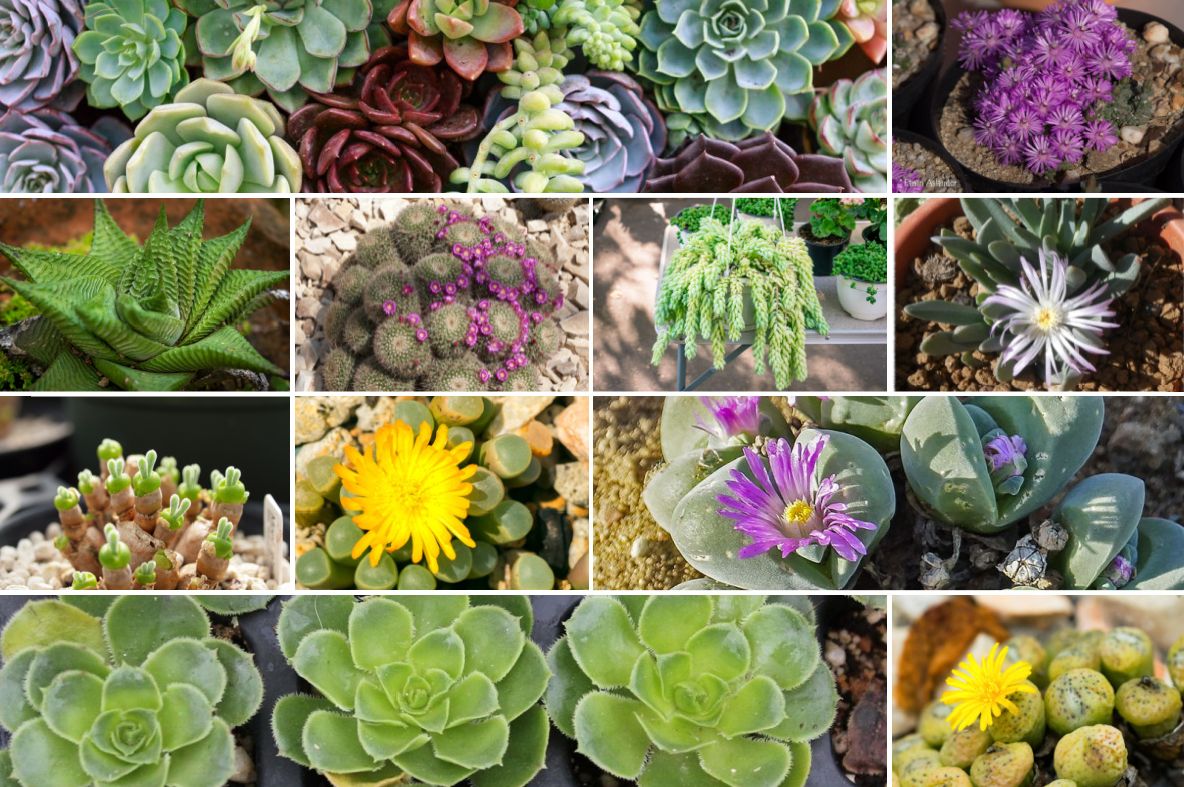
Not only are there thousands of succulents to choose from, but scientists are also constantly crossbreeding these plants to create new types of succulents every day. If you’re looking for the perfect succulent for your home, look no further, as this list we’ve compiled has them all.
So, without further ado, let’s take a look at all the amazing different types of succulents.
What is a Succulent?
A succulent is a plant with several unique features. Unlike most plants, succulents store water in their leaves, often giving them a fat and fleshy appearance. Some people even think the leaves of succulents look like cushions.
Because a succulent can store so much liquid in its leaves, it can survive many harsh climates and go days without water. Therefore succulents make great gifts as they are plants that don’t require much care.
Even if the word succulent is one you are reading for the first time, chances are you are familiar with the plant. Cacti are the most common form of succulents and are found all over the United States.
Characteristics of Different Types of Succulents
Succulents are very easy to identify, even for those who don’t consider themselves plant people. They have very distinct characteristics which are easy to spot.
Here are some easy characteristics you can look for when trying to spot succulents:
- Thick stems, often round in shape
- Fleshy leaves that look like cushions
- Roots near the surface of the soil
- Spines or hair on the surface of the plant
- A wax layer on the outside of the plant
- Leaves growing on top of one another to maximize growth
If you see a plant with 2 or 3 of these characteristics you’ve likely found yourself a succulent.
How to Identify Different Types of Succulents
Are you struggling to identify a plant you believe might be a succulent? There are a couple of tips you can use during succulent identification to ensure the plant you are looking at is truly a succulent.
Succulent Identification Tip 1: Look at the Leaves
Are the leaves bendy and moveable? Then you don’t have a succulent, that is just a regular plant. Succulents have thick leaves that will break if try to bend them.
Succulent Identification Tip 2: Observe What the Succulent is Growing in
Because succulents are such hardy plants, they are often grown in containers with different types of growing materials. Many don’t need direct sunlight and can grow in materials like pebbles or rocks.
If the plant is in a pot with soil, this doesn’t mean it isn’t a succulent. But if it is in a pot with soil and has bendy leaves, then you can be reasonably assured then the plant is not a succulent.
Succulent Identification Tip 3: Look at the Shape of the Plant
Most succulents grow in a rosette shape, with the leaves growing on top of one another. Some succulents, such as cacti, don’t have the rosette shape, but they are still round with star-shaped flowers. When trying to decide if a plant is a succulent, the shape should be a dead giveaway in succulent identification.
Succulent Identification Tip 4: Know How it Reproduces
One unique thing about succulent plants is the fact that they can reproduce easily. Now, while you can’t observe this just by looking at a plant, you can typically read about it (or ask about it) to find the answer.
If a plant can re-produce from a leaf or broken bulb, it is generally classified as a succulent, even if it doesn’t have the signature fleshy leaves. One prime example of a succulent that doesn’t have fleshy leaves but reproduces easily is the snake plant.
Types of Soil for Succulents
Succulents aren’t like normal plants, and thus you can’t just stick them in a pot of soil and call it a day. Succulent plants need soil that is well-draining and loose to allow excess water to leave the area around the plant.
It is always best to make your own soil for succulents, as it is easy and you can add all the components your succulent needs. If you do decide to make your own soil for succulents, ensure it contains a mixture of organic, and inorganic matter.
How to Make Your Own Succulent Soil
Materials:
- Inorganic matter: silt, sand, rock, gravel, clay, or perlite
- Organic matter: compost, manure, leaves, bark, peat, or moss
- A bowl or pot to mix the soil in
- A pot where you plan to put your succulent plants
Step 1: Fill the Base of the Pot
Start by placing a layer of inorganic matter at the base of the pot. It is best to do a layer of rocks or sand.
Step 2: Mix the Soil
Mix the soil for the pot, you want roughly 80% organic matter and 20% inorganic matter. Mix this well then add it to the pot. You can mix potting soil with succulent soil on a 2:1 ratio to achieve the same result.
Step 3: Plant the Succulent
Place your succulent in the soil mixture ensuring the roots are covered but still have room to breathe.
How to Care for Different Types of Succulents
Succulent plants come in all shapes and sizes and they all require different types of care. Generally, when you purchase a succulent plant, it will let you know the type of care that succulent needs.
Here are some basic instructions for caring for different types of succulents to get you started.
Look at the Amount of Sunlight
Although succulents don’t tend to need a lot of water, they still need a fair amount of sunlight. Be sure to check if your succulent is a full sunlight, or partial sunlight plant, as too much sunlight can also harm your succulent.
Generally, if a succulent requires full sunlight, a spot in a window is enough. For those with especially large succulents, you may want to consider planting them in a place outside where they can still receive plenty of sunlight.
Cacti, aloe vera, and echeveria succulents all need lots of sunlight.
Don’t Over Water
Succulents store lots of water in their fleshy leaves, therefore they should only be watered when the soil in their pot is completely dry.
Additionally, if you notice any standing water in the pot of your succulent, you should drain this water out immediately, then check the soil composition to ensure water won’t get trapped in the pot of your succulent in the future.
Monitor the Soil
Succulents need special soil, and different types of succulents will do better in different soil mixtures, which is why it is recommended to make your own soil.
When you make your own soil, you can easily change its composition of it based on the performance of your plant. If the soil isn’t draining enough, it needs to be made of a more airy material. Cactus soil is always a great place to start when it comes to planting succulents.
Feed Your Succulent
Some Succulents are more finicky than others and they will require fertilizer, or plant food, in order to grow.
You can easily add this to the pot of an indoor succulent, but it might be more difficult with an outdoor succulent, therefore you should keep this in mind before you plant a finicky succulent outdoors.
Think of the Temperature
As hardy as succulents are, they do not like crazy temperature changes. Most succulents prefer to be kept somewhere between 50 and 80 degrees Fahrenheit. Of course, this doesn’t mean that they can’t survive in hotter or colder climates, it just means you need to acclimate them naturally.
For example, if you have a cactus garden indoors which you would prefer to move outdoors, this can be done, but don’t attempt it on a day when you’ve got the a/c set to 72 while it is 90 degrees outside.
Instead, move your cactus garden in the spring, when it is a similar temperature both indoors and out, allowing the cactus to gradually adjust.
Stem Cuttings
Stem cuttings when it comes to a succulent aren’t necessary but can be done if you would like your succulent to propagate. Simply use sharp scissors to cut a single branch or stem from your succulent.
Next, place this branch or stem cut side down in its own pot of soil. Water it when the soil gets dry. Depending on the type of succulent it can take a few weeks to a month for the succulent to begin growing from the branch in the new pot.
70 Different Types of Succulents to Include in Your Collection
Types of Indoor Succulents
1. Albuca
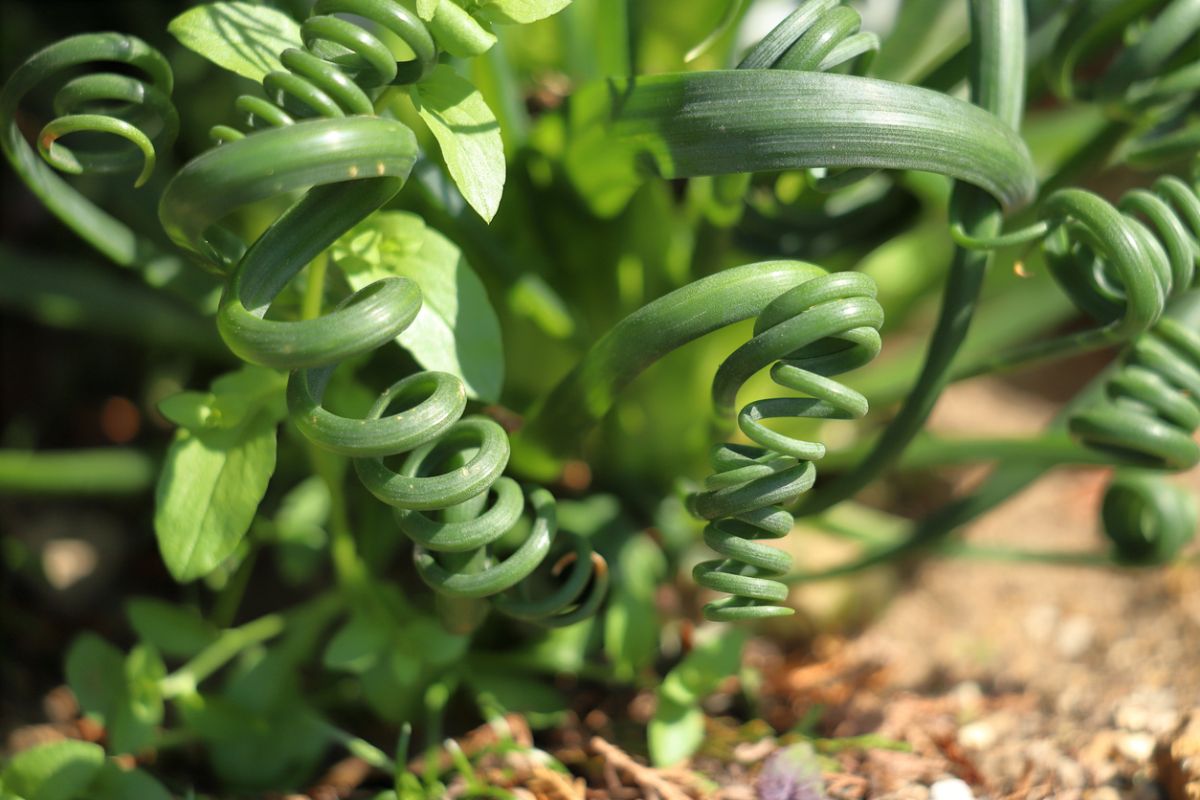
Albuca succulents, also called the ‘Frizzle Sizzle’, is an indoor succulent plant known for its long stems which curl at the end. It’s dark green in color and covered in tiny hairs which can sometimes make you think this succulent is sticky to the touch.
In the spring, you’ll want to keep this succulent near a window in your living room as it will grow beautiful yellow flowers that emit a fresh vanilla scent.
2. Astroloba
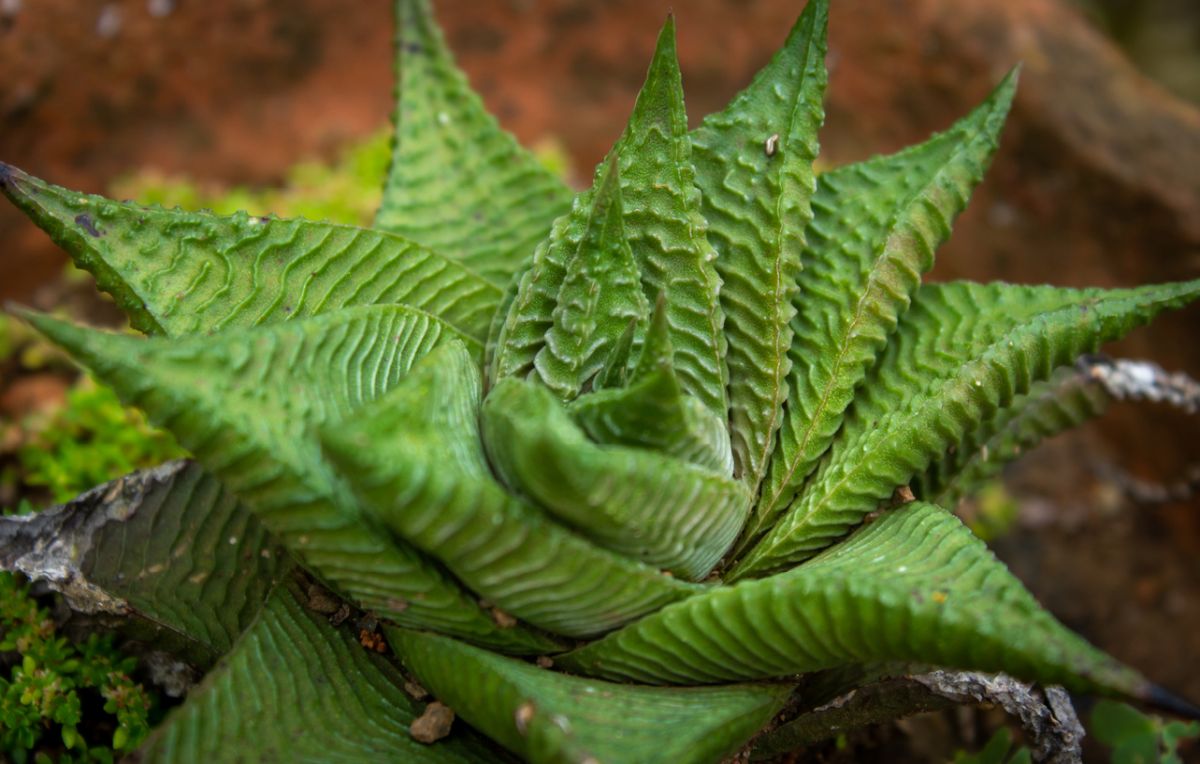
The Astroloba is one of many cactus succulent species with bright green leaves that grow in a pretty, pointed, arrangement. While Astrolobas can be grown outside, they need partial shade to keep them from getting too much sun and they need to be brought inside during the winter, therefore most succulent growers prefer to keep the Astroloba indoors year-round.
Astrolabas are the ideal addition to indoor rock gardens because of their hardy nature and the fact that they grow well with other cactus-type succulents.
3. Echidnopsis
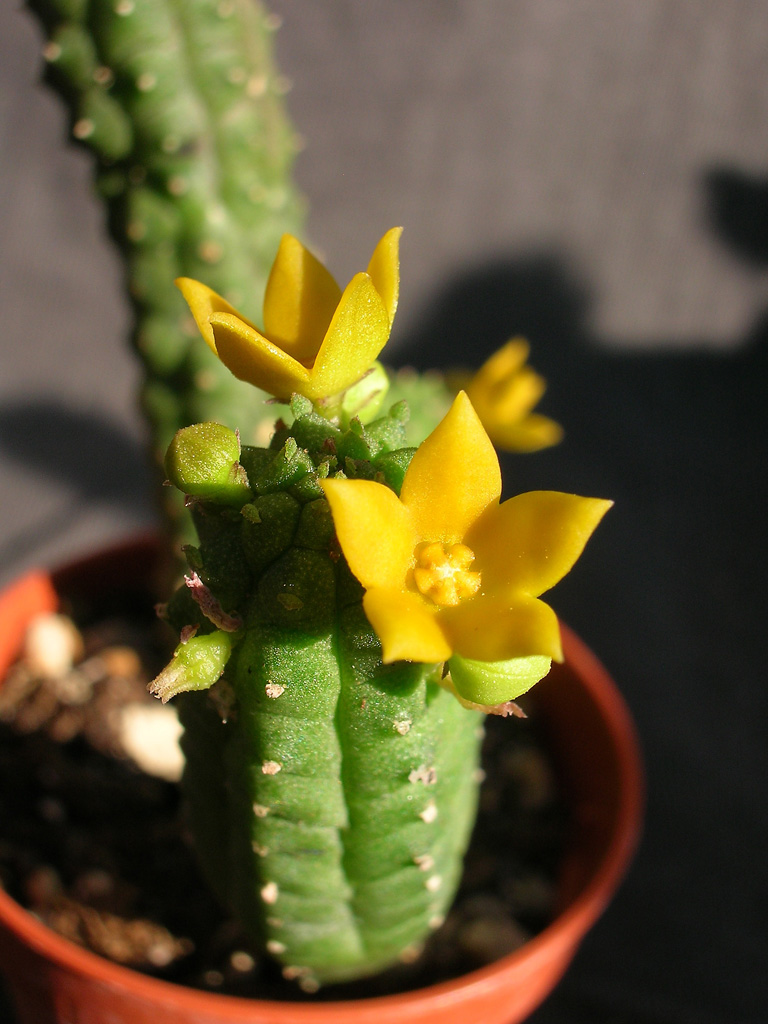
When many people think of growing succulents, they think of small cactus plants that you can buy in a pot and place on a coffee table. The Echidnopsis genus of succulents is exactly that, a bunch of small cactus plants which are dark green in color and grow best when placed in potting soil indoors.
For those that want a flowering plant, Echidnopsis succulents won’t disappoint as they have beautiful showy flowers that can sometimes be seen year-round. Most of the flowers are pink, red, or yellow in color, but it is not uncommon to find some flowers which exhibit multiple colors in an ombre look.
4. Fenestraria
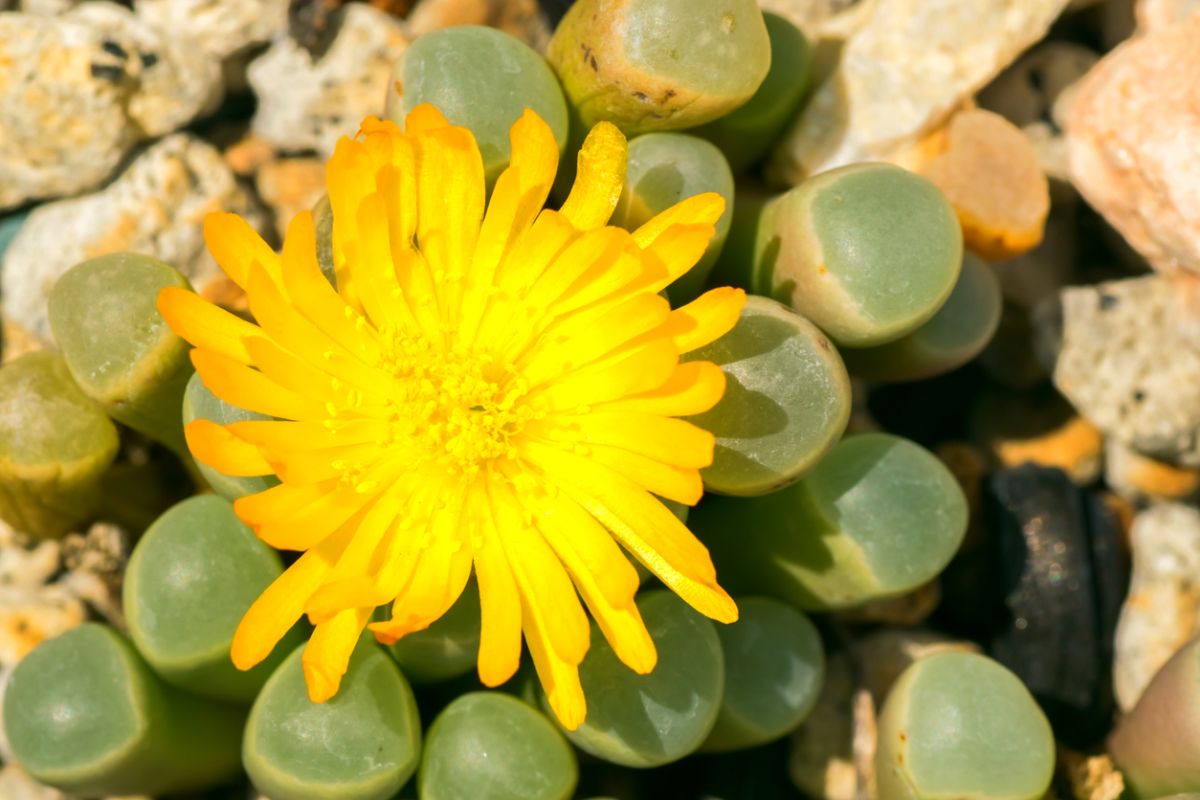
Fenestraria succulents are generally an indoor plant, but they can also be grown outdoors. They are unique in that they grow leaves that look light green stems with a somewhat white top. The flowers, on the other hand, have their own stem and rise above the leaves.
Fenestraria needs bright sunlight, at least 6 hours a day. They cannot, however, handle direct sunlight or large amounts of rain which is why it is better for you to plant indoors.
5. Gasteria
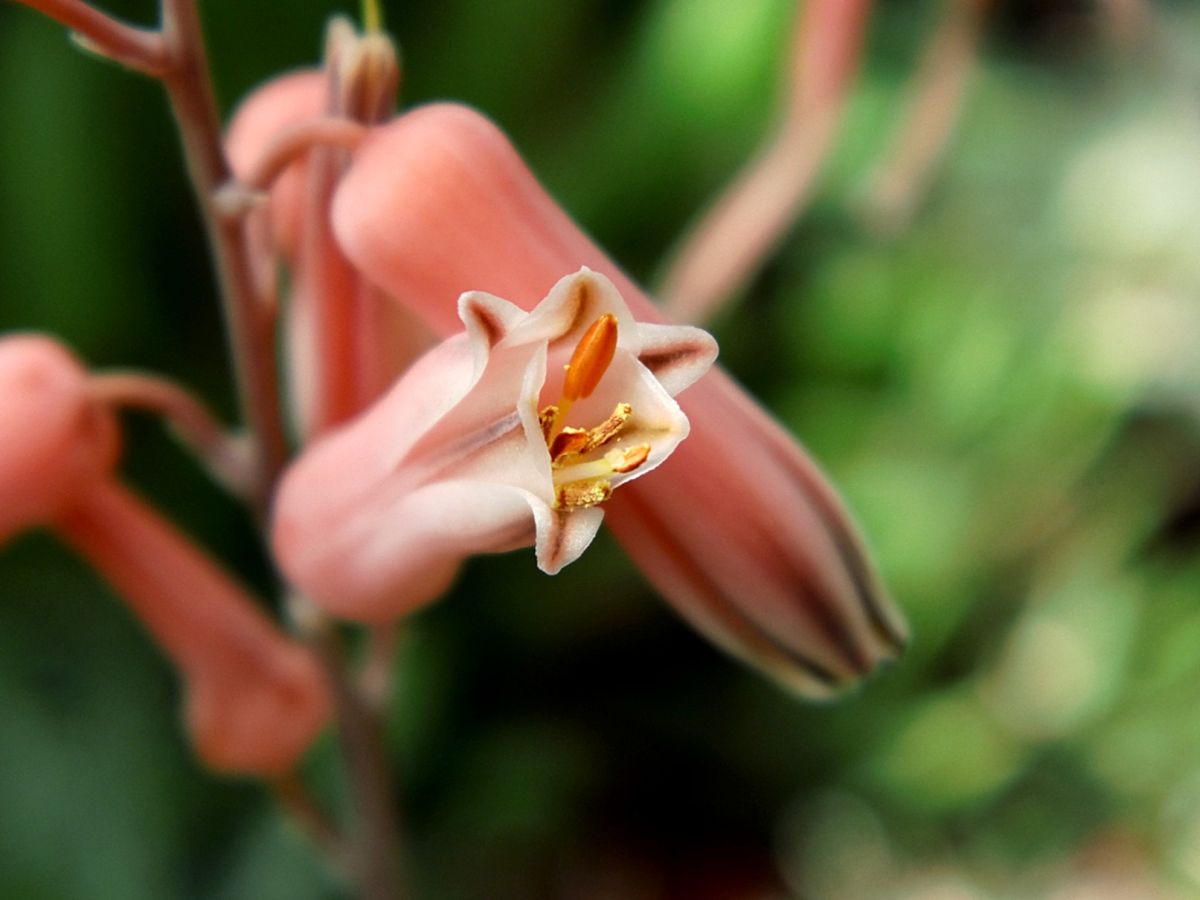
Gasteria are indoor succulents native to South Africa which are widely selected because of their unique appearance. Some Gasterias grow long leaves that a rough-in texture that somewhat resembles an ox-tongue. Others have sac-like flowers which resemble the shape of a stomach.
Gasterias do not need a light or bright light, making them an ideal house plant. Not to mention they grow very slowly, meaning they will stay small and be unlikely to outgrow their pot in your home.
Unlike other Gasterias, skip the rocks and pebbles and plant them instead in potting soil, as this is much closer to their preferred habitat.
6. Graptopetalum
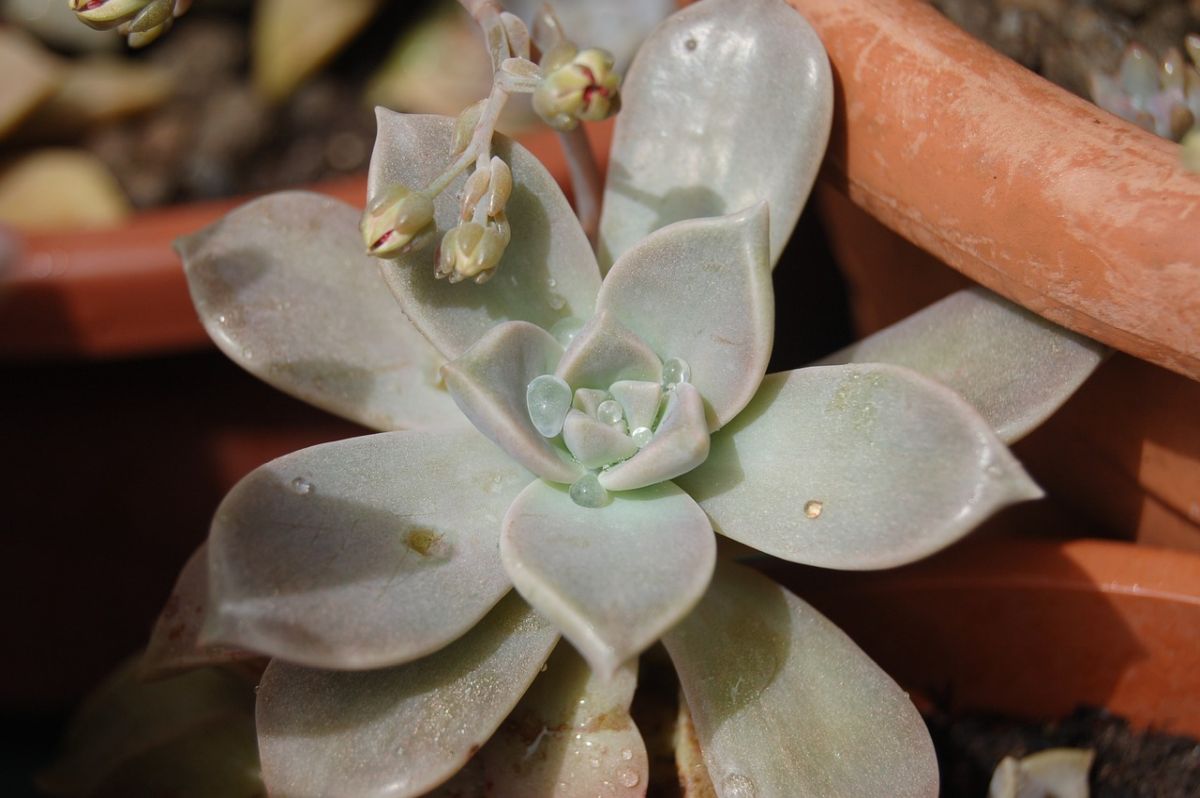
Many people, when searching for succulent plants, are looking for the stereotypical star-shaped flowers. When this is the case, look no further than the Graptopetalum, which is a succulent species that contains several different types of succulents that grow leaves in the star shape.
The thick leaves on the Graptopetalum vary from green to pink, and sometimes, even shades of purple. These succulents are quite beautiful and do well when placed in a pot making them ideal indoor succulents.
7. Haworthia
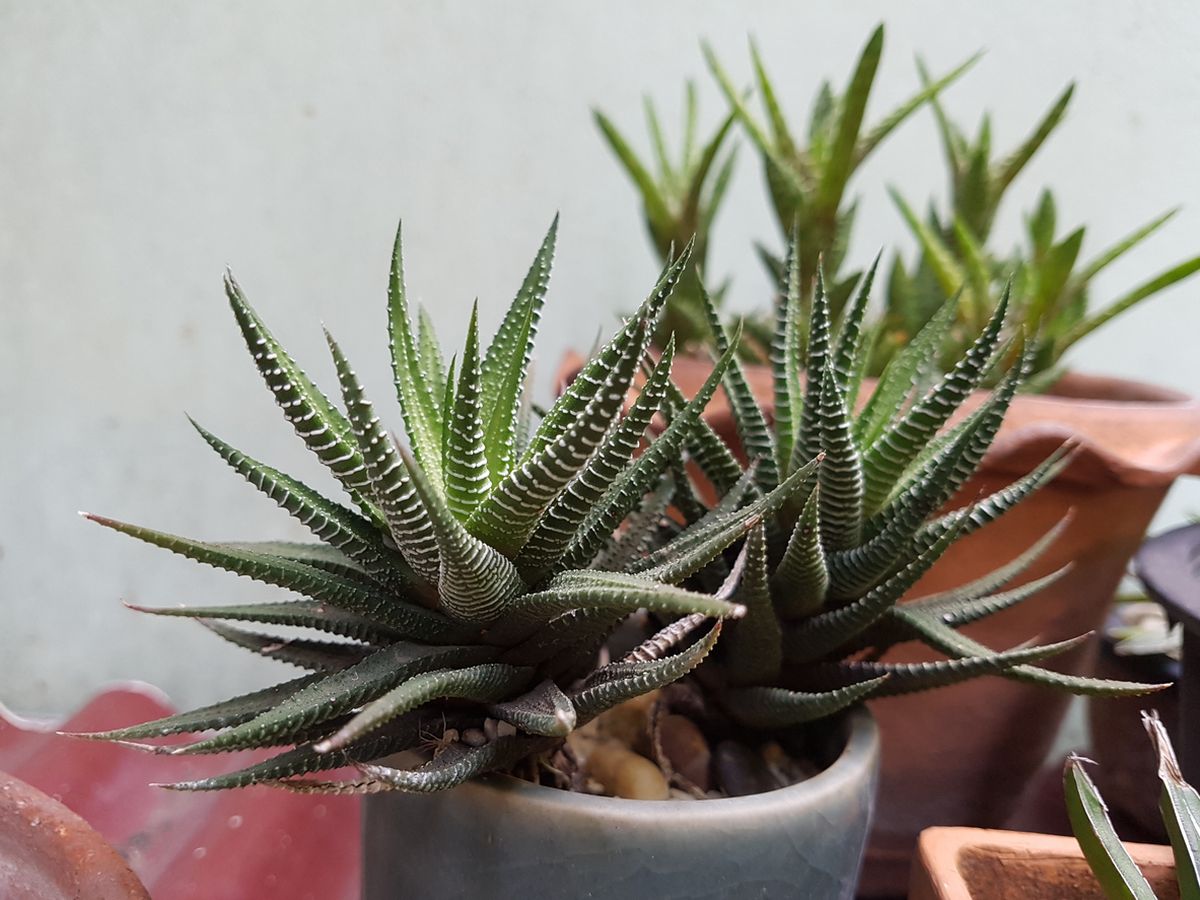
Want an aloe vera but don’t have the space? Check out Haworthia succulent plants which are like baby aloe veras. They grow the same style of green leaves, some of which have spines, but they typically don’t grow more than 5 inches tall.
Haworthia are native to South Africa, but surprisingly don’t do well when placed in full sun. Instead, a Haworthia will be happily placed on a window sill where it will get partial shade for some of the days making these excellent indoor succulents.
8. Snake Plant

When looking at the snake plant and following the succulent identification tips above, you may be confused as to if a snake plant is a succulent. The answer is, it is! Its thick leaves and slow-growing qualities classify it as a succulent, as well as the fact that it doesn’t need a lot of water to grow.
Snake plants are indoor succulents because they generally don’t like full sun. While they do need some sun, they can also be quite happy in a shady spot. Be careful, however, as most types of snake plants are poisonous to dogs and cats.
9. Huernia
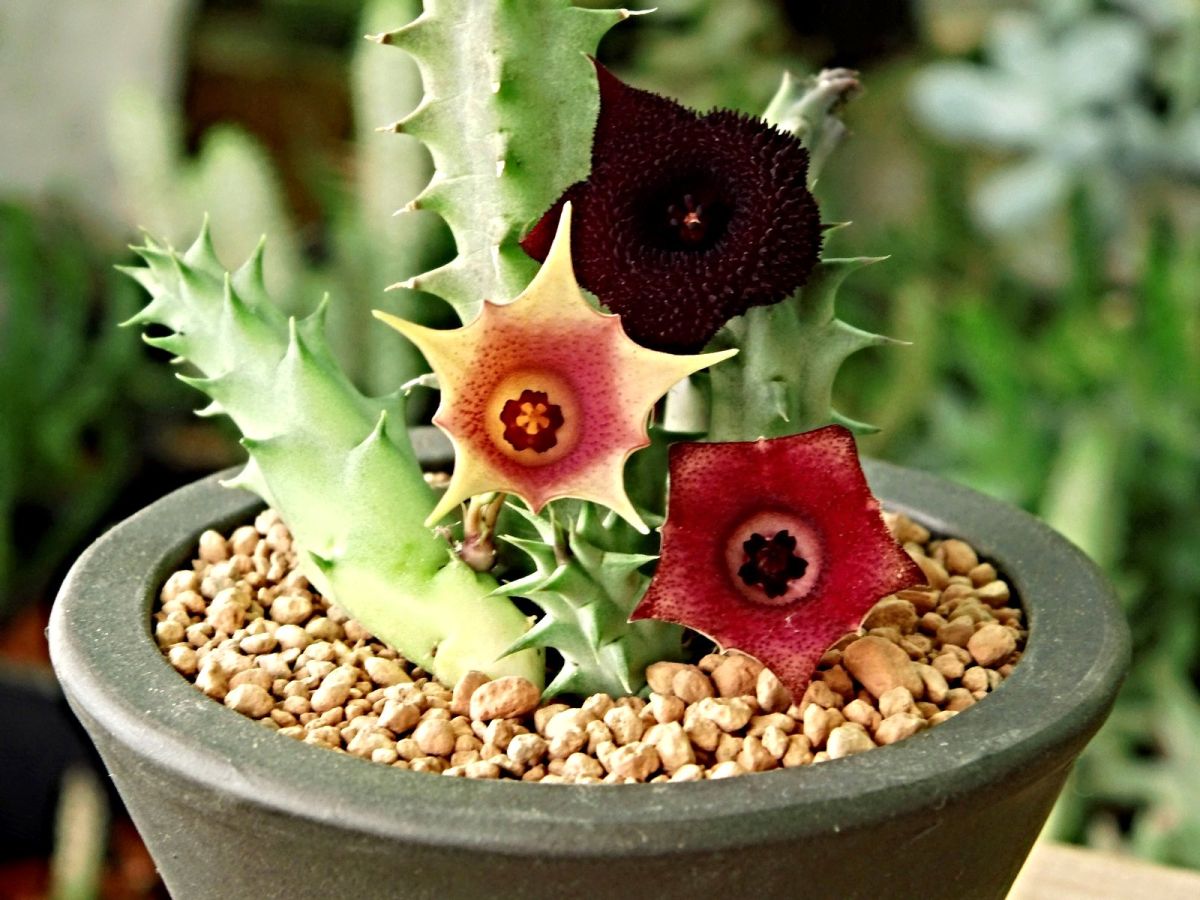
There is no mistaking the Huneria, as these types of succulents grow in the shape of bright red star-shaped flowers. They are small, however, making them indoor succulents.
In addition to being small and eye-catching, these succulent plants need bright light, but indirectly, so they are best placed in a window. Water them 1-2 times per week, but only when the soil is dry, and this is a succulent which will be the statement of your room for years to come.
10. Crinkle Leaf Plant
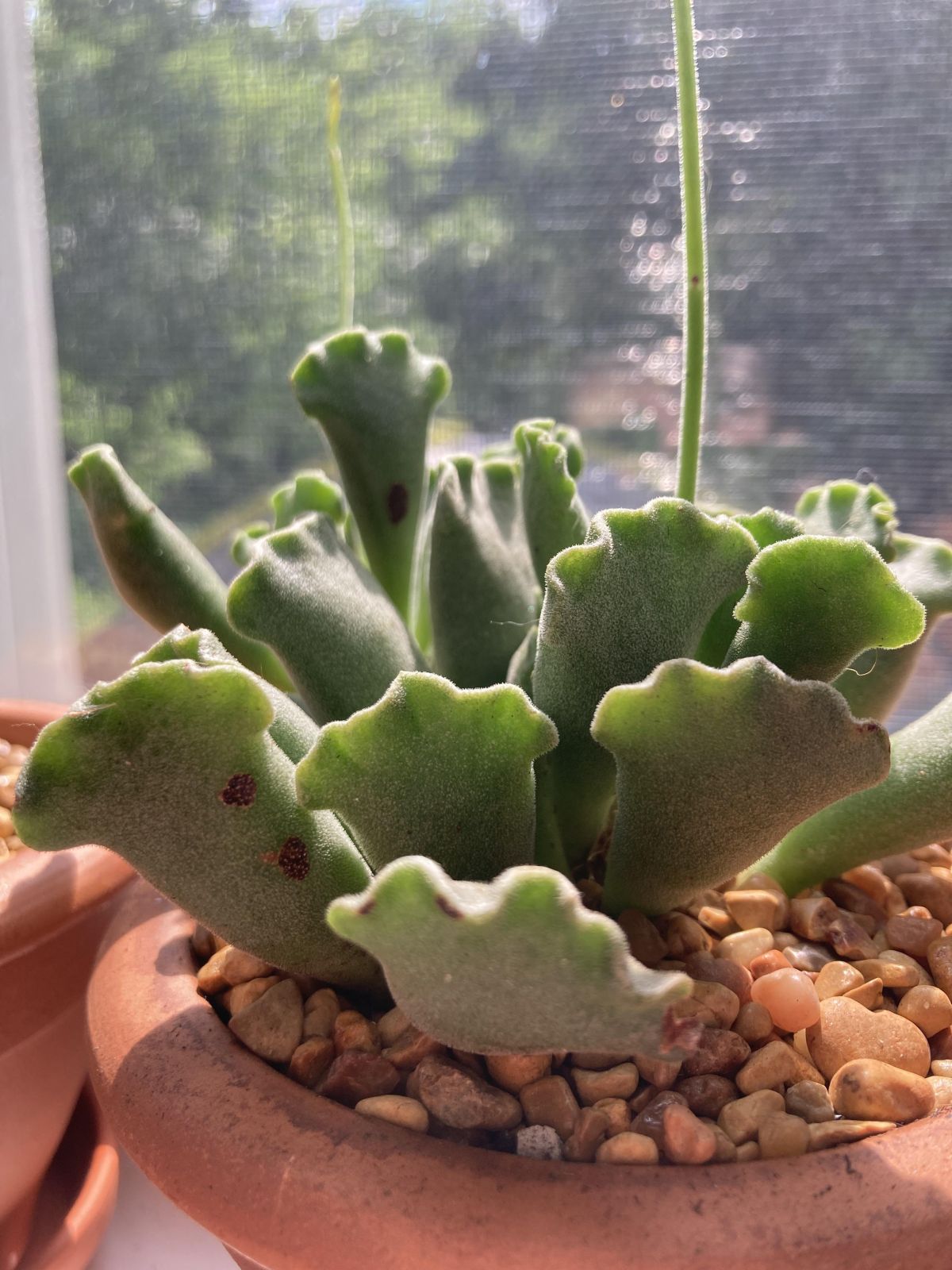
The crinkle leaf plant is a succulent native to South Africa, which grows triangular leaves that appear in a crinkled shape, hence where they got their name. They are small, and they grow very slowly, making them a good small house plant to place on the corner of your desk.
Be careful, however, as these plants do need a significant amount of sun so be sure they are on the sunny side of your desk or home office.
11. Peperomia
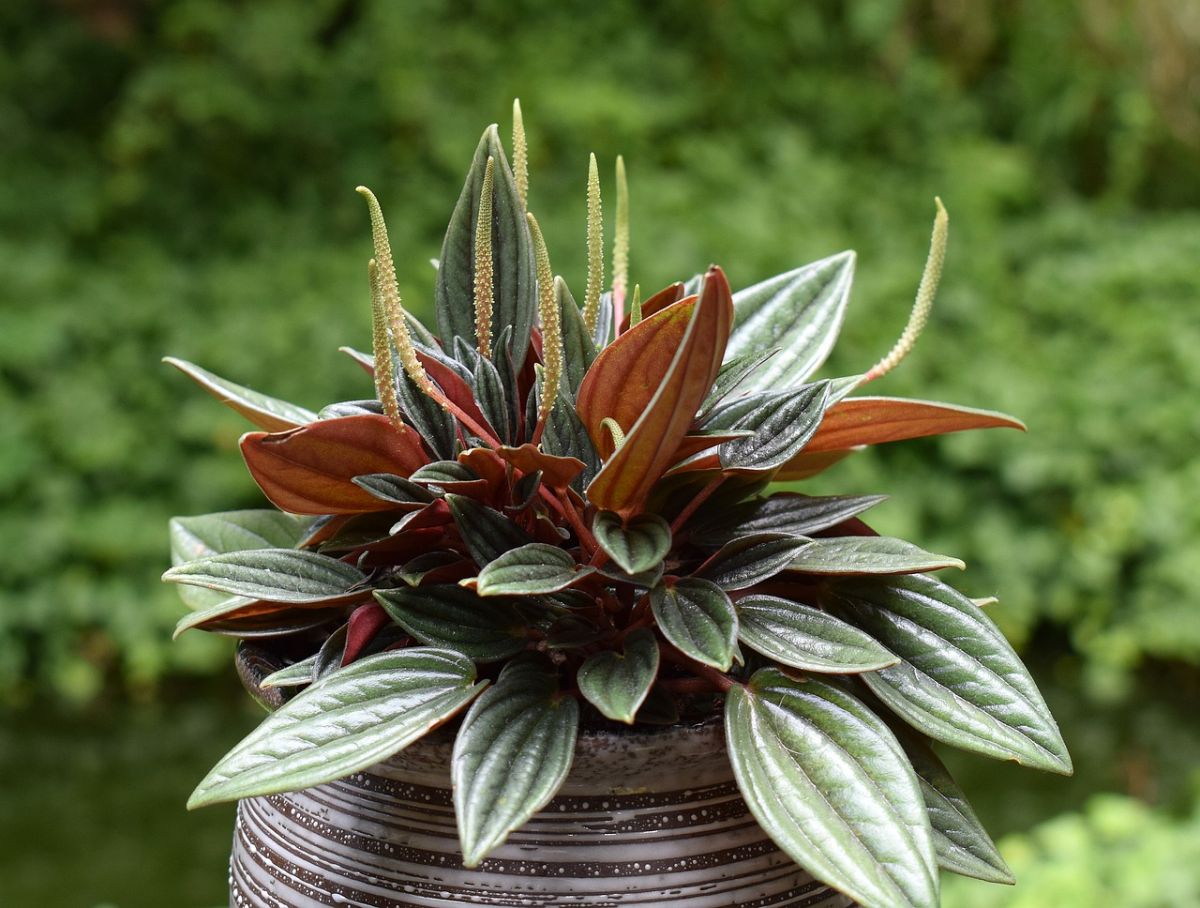
Peperomia succulents are native to Mexico and South America and therefore do well in climates that resemble these areas. Luckily, if you don’t live in one of these areas, Peperomia are very easy (and happy) to grow indoors.
Peperomias are very distinct when it comes to succulent identification as they have green leaves with a yellow rim similar to a snake plant, but not in the long shape. These succulents bloom in the summer with white, green, or brown flowers.
Types of Hanging Succulents
12. Aptenias
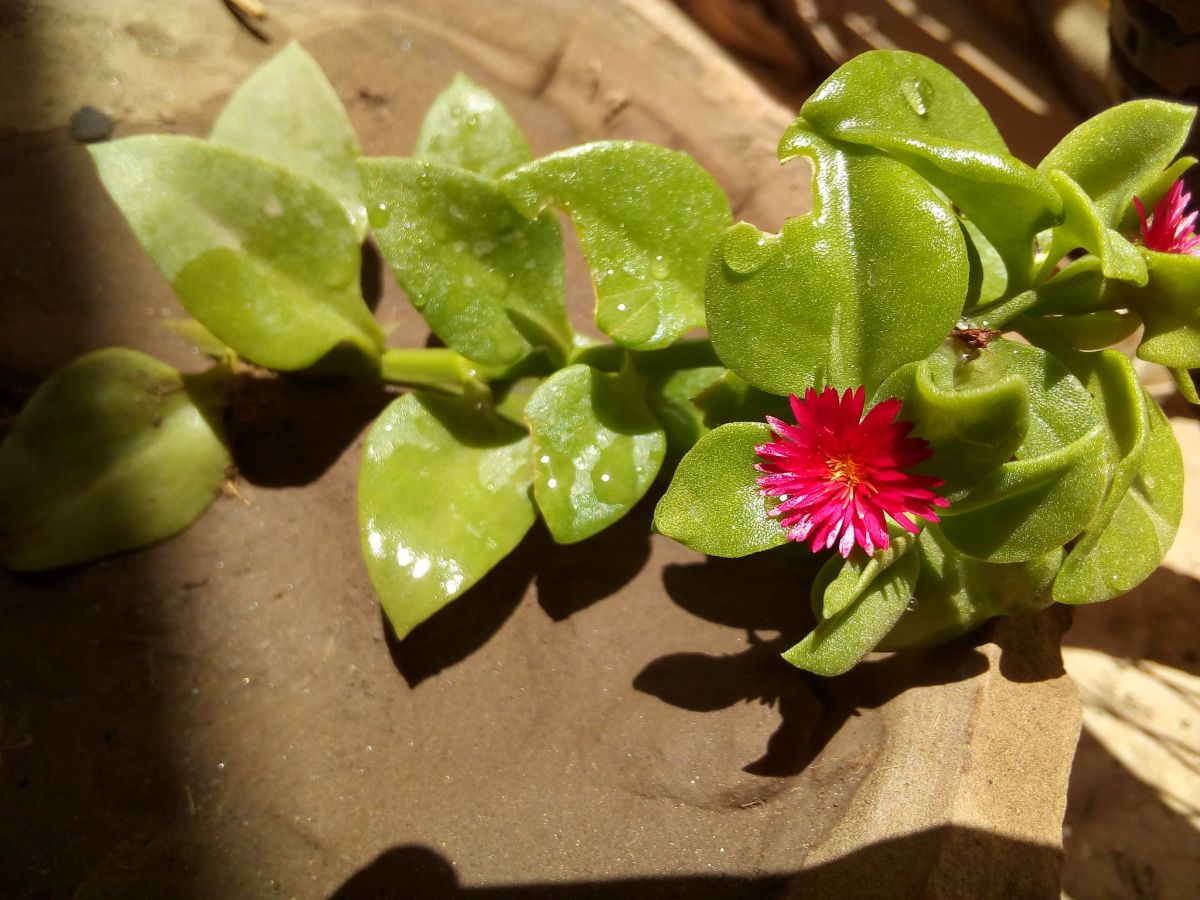
Aptenias are a type of succulents that will climb a trellis when they are planted near the bottom, meaning it’s easy to have these succulents hanging over a patio or garden.
Because these succulents grow so tall, they are only recommended to be grown outdoors, as they will likely not be happy when placed indoors.
Like many other succulent plants on this list, Aptenias are native to South Africa and sensitive to overwatering. Only water your Aptenias when the soil is dry and in need of water. In the spring, Aptenias carry beautiful pink or orange flowers.
13. Callisia
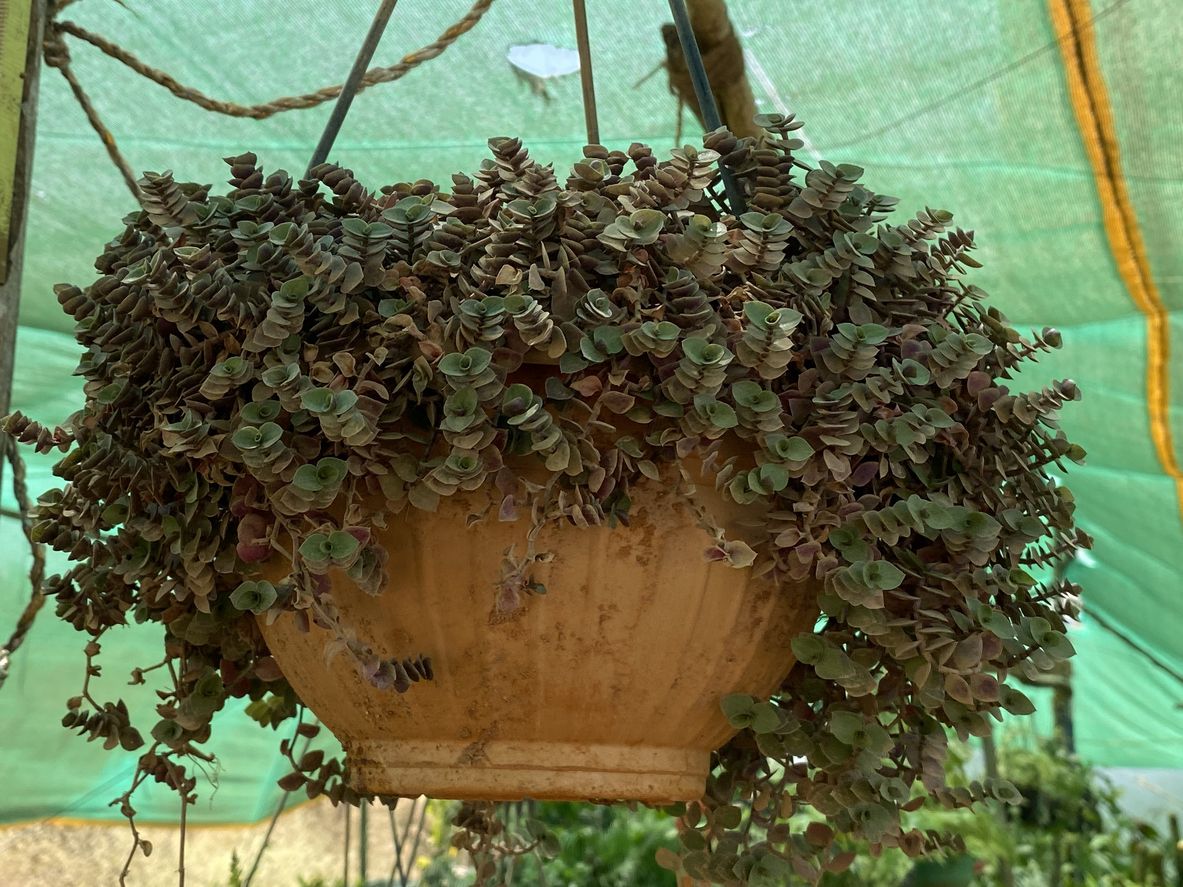
The Callisia succulent is a hanging plant that will be a great addition to your home when grown in hanging baskets. The hanging baskets will allow the dark green leaves to hang over the side and grow downwards.
The Callisia is a subtropical plant and it prefers to be kept in the shade and humidity, so it’s probably better to grow this particular succulent indoors.
14. Crassula Ovata
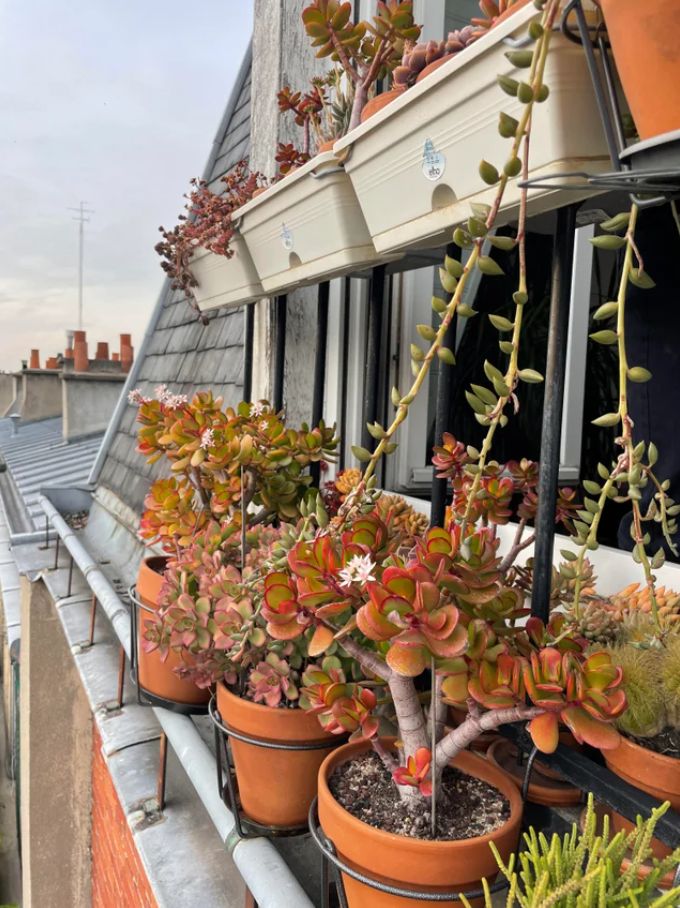
The Crassula Ovata, also known as the jade plant, is an indoor plant with deep red stems and light green fleshy leaves. Crassula Ovata are container plants, and do best when grown in a pot of soil that you can place in a sunny, indoor location.
Jade plants can get quite large, so if you are short on room, or don’t want to repot your jade plant, it is best to invest in a dwarf jade plant instead which is the same breed of succulent but it won’t grow as tall. Many people love the beautiful pale pink flowers which bloom on a jade plant each year.
15. Elephant Bush
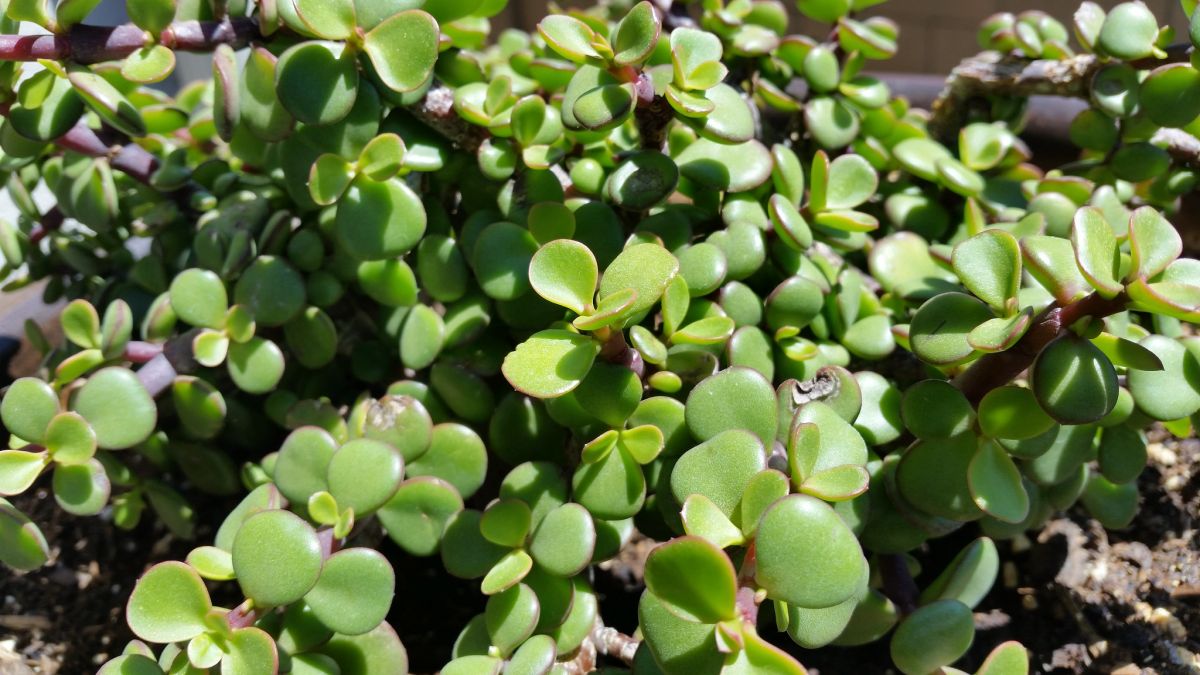
Elephant bush is a succulent native to South Africa which got its name for an obvious reason-elephants love to snack on their leaves. In your home, the Elephant bush is a great succulent to place in hanging baskets as its green leaves will grow up and out to create a beautiful lush bush.
It may be daunting to place an Elephant bush inside, but this particular succulent grows best indoors as it does not handle drafts or weather changes well. It does need some sun, however, so be sure it is hung somewhere where it will get some light on a daily basis.
16. Burro’s Tail
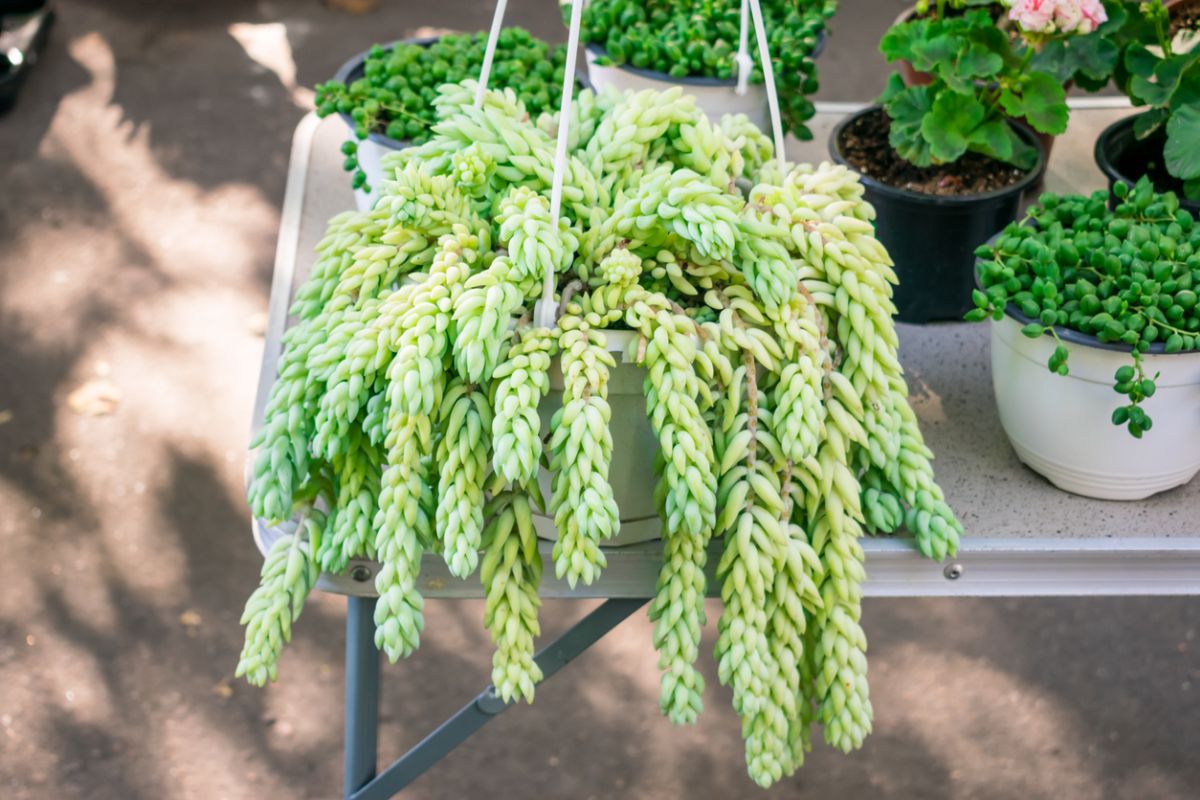
Burro’s tail, sometimes called horse’s tail or lamb’s tail instead, is a unique succulent that grows its green leaves in a hanging shape that looks like a bushy tail. These types of succulents are native to southern Mexico and Honduras, so although they can be grown outdoors there, in the United States they are indoor succulents only.
Burro’s tail rarely blooms, but they can sometimes tote pink or red flowers in the summer months. These flowers do attract all kinds of bugs and flies, so you may find you prefer the years when your Burro’s tail doesn’t bloom.
17. Christmas Cactus
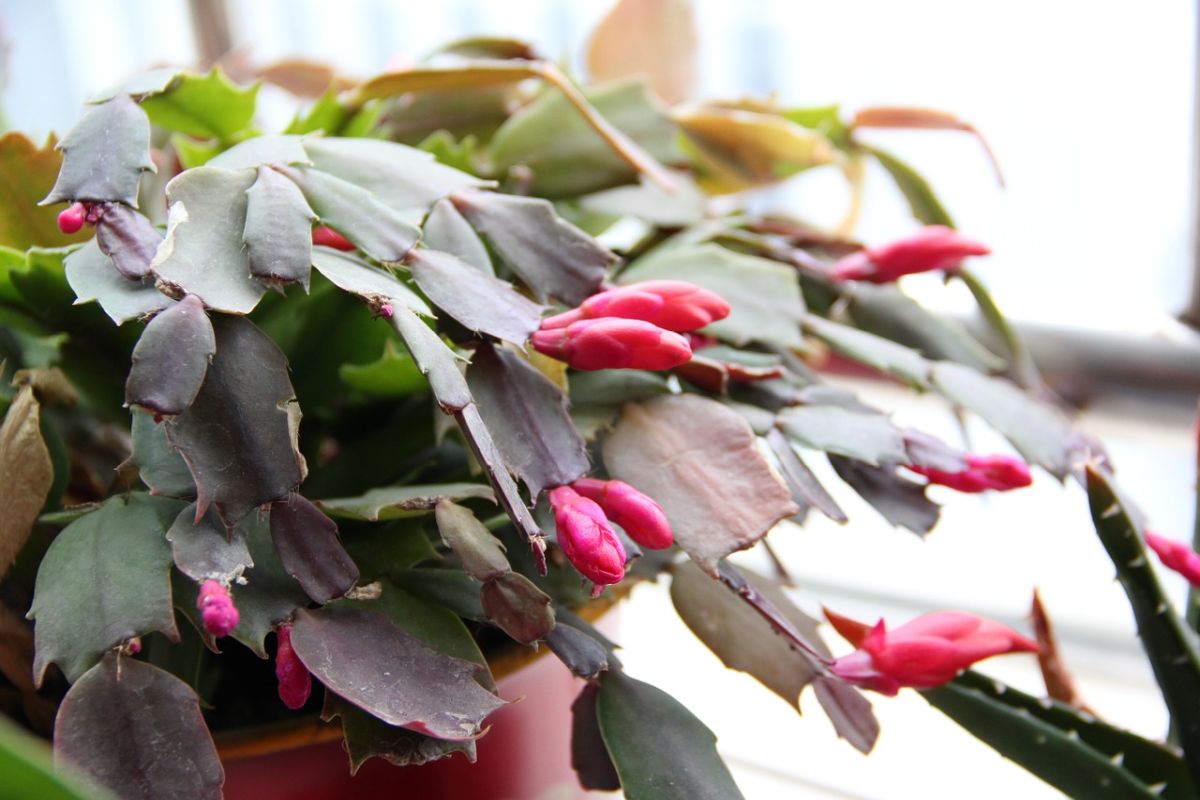
When looking for a plant to place in hanging baskets, look no further than Christmas cactus which is a type of succulent that blooms pink flowers in the winter months. The green leaves of the Chrismas Cactus grow up, only to fold over for a droopy look.
Pink flowers will bloom on the very ends in a unique shredded shape(sometimes orange flowers can also be seen). Christmas Cactus, although they are succulents, are subtropical plants and need to stay inside where it is warm and temperate year-round.
If you are struggling to get yours to grow, this could be because it doesn’t have enough room in its hanging basket. Transfer it to a larger pot in order to encourage it to continue to bloom and grow.
18. Jensenobotrya
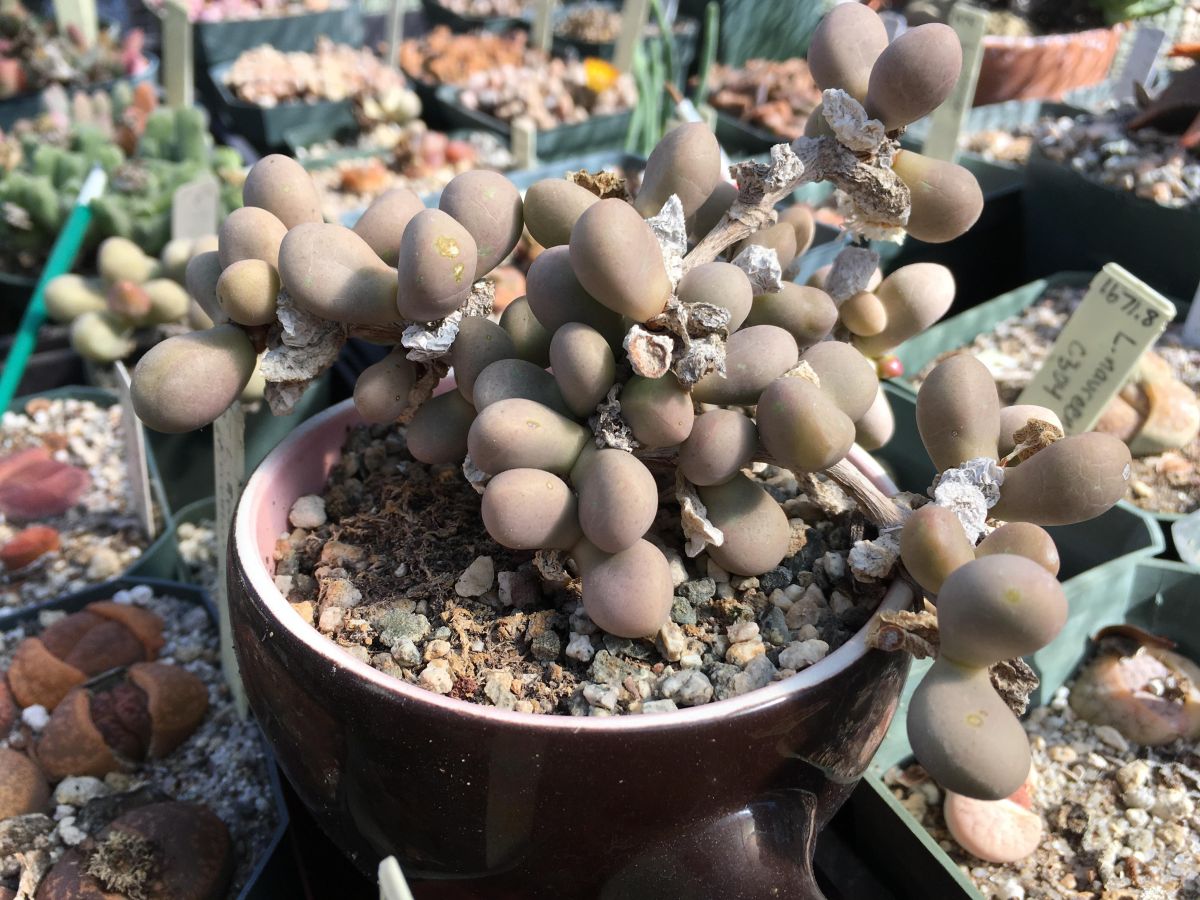
Jensenobotrya is an extremely rare succulent found only in the Namib desert. But if you are able to get your hands on some seeds, they are very easy to grow in almost any hot and dry climate.
Unlike most other hanging succulents, Jensenbotrya can be placed outdoors as long as it is set in a place where it won’t get too much water.
The Jensenbotrya grows club-shaped leaves that are green, sometimes with tones of pink and purple mixed in. The branches grow long in a bent-over shape and will bloom flowers during the daytime only.
19. Othonna Capensis
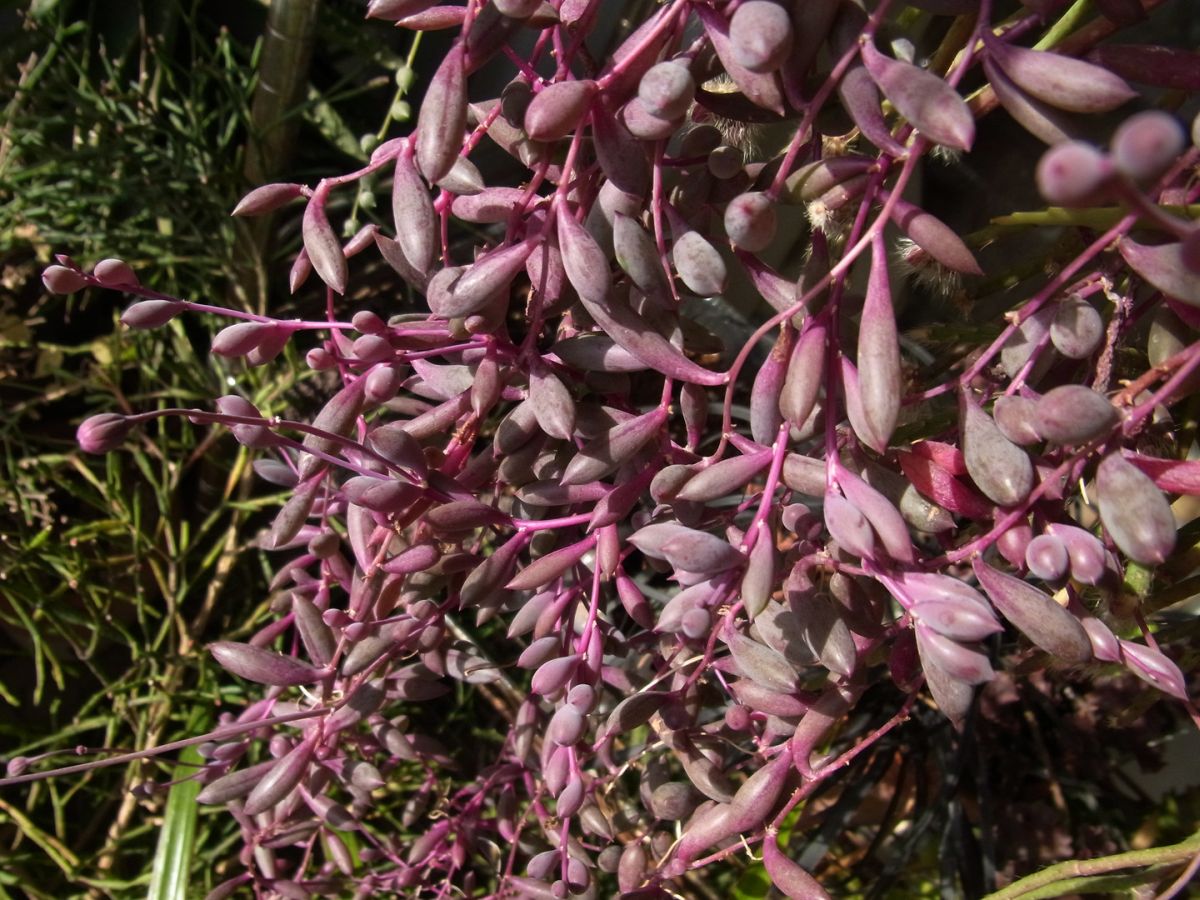
The Othonna Capensis is sometimes called the Ruby Necklace plant because of the way the succulent grows and lets its red leaves and stems hang low. Thus, it is ideal to place this succulent in a hanging basket and let it grow downwards.
The Othonna Capensis can be grown indoors or outdoors, just ensure it has plenty of sunlight in both locations. For homes without enough sun, these succulents also grow well under a grow light.
The more light you give it, the redder the leaves will become. If the plant doesn’t get enough light, you will know as the leaves will stay green.
Types of Small Succulent Plants
20. Adromischus
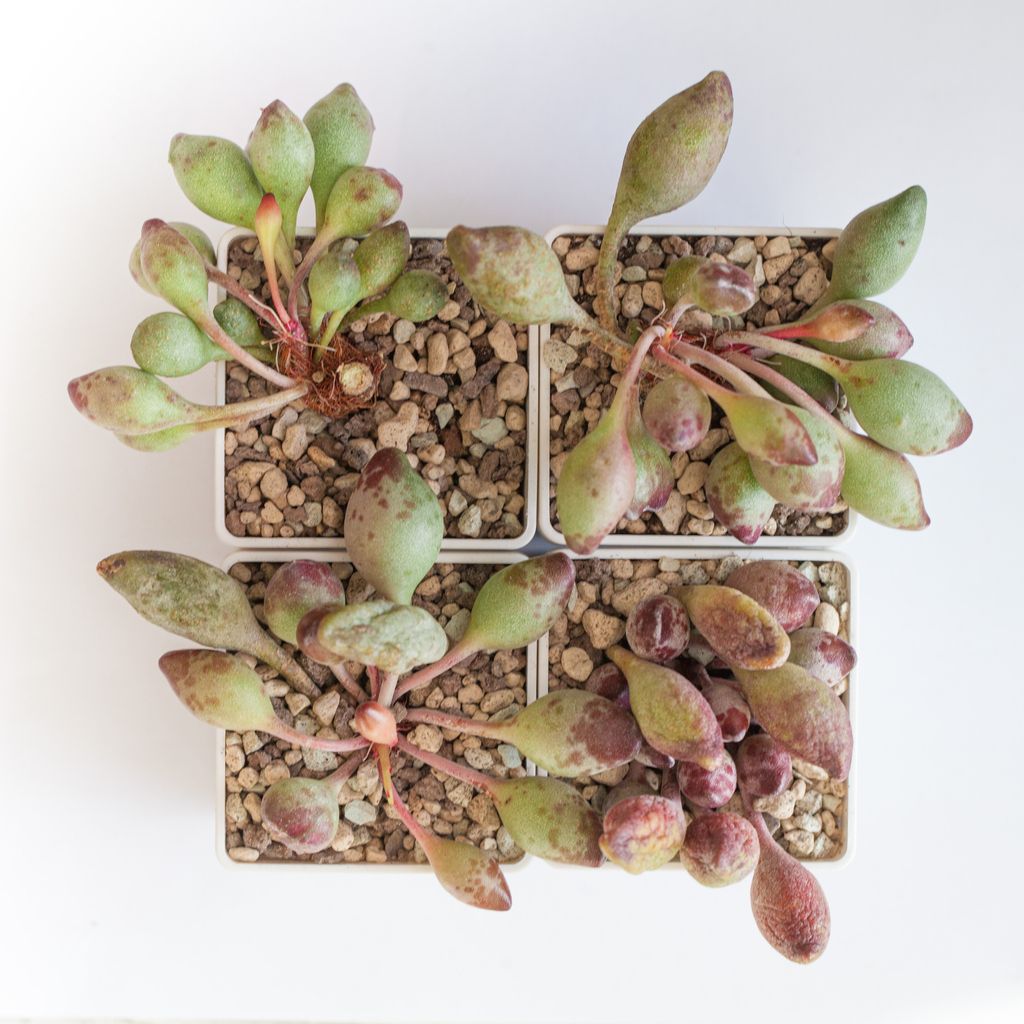
Adromischus succulents have the stacked leaf look typical of a succulent plant. They are small and happy to live in a pot for most of their lives.
Adromischus does come in different colors, with plants in everything from green, to purple, and even shades of red, making them ideal when putting together a multi-plant succulent garden.
21. Anacampseros
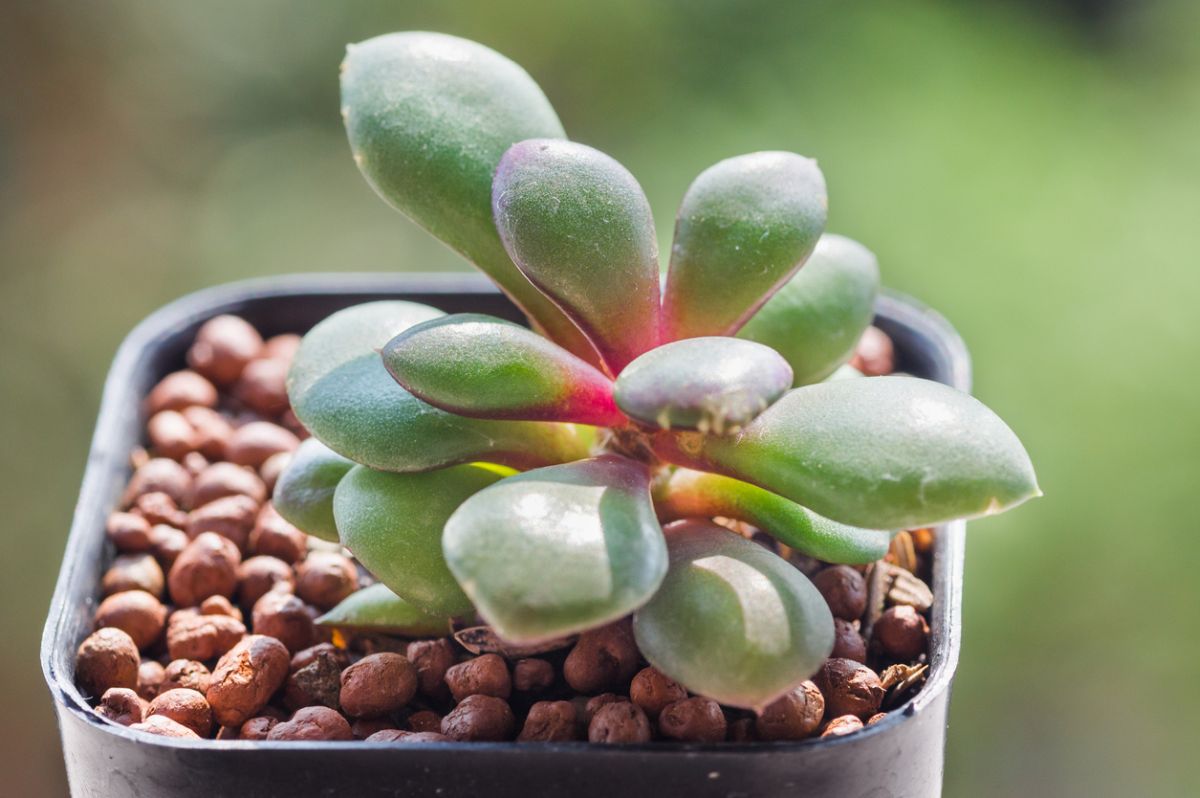
Anacampseros are a popular small succulent plant that can be kept indoors or outdoors. They are especially characterized by their purple and green leaves which sprout in a flower shape. Some varieties of this succulent will additionally bloom purple flowers in the early spring months.
Because the Anacampseros is from South Africa, this succulent is one of many subtropical plants that cannot be left outside in the cold as it will die. Additionally, the Anacamperis does not do well with too much water and thus should be watered sparingly.
22. Conophytum
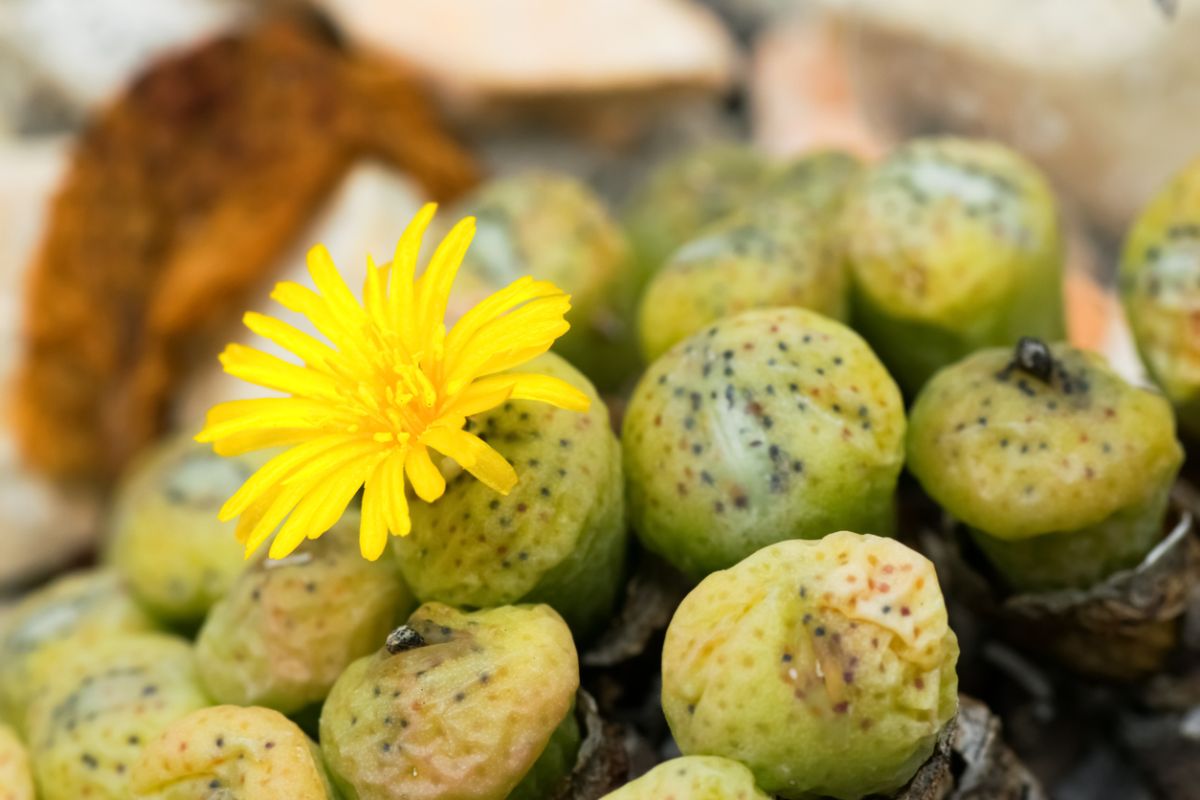
Want a succulent that is easy to give as a gift? Look no further than the succulents in the Conophytum genus which is made up of small succulent plants that grow in round shapes.
When they bloom, it looks as if the yellow flowers are protruding directly from a round light green rock which is really the leaves of the plant.
Conophytums are indoor pebble plants and they should be gifted in a pot with light soil and a layer of pebbles on top.
23. Cotyledon

Cotyledon succulents are a hardy succulent with large light green and purple leaves which can sometimes be round in shape. These succulents prefer a drier climate similar to that in South Africa.
Cotyledons are small succulent plants, and although their leaves are persistent, care must be taken not to bend or crush their stems as they are easily broken. A Cotyledon with a broken stem is not easy to bring back after it has been crushed.
24. Dinteranthus
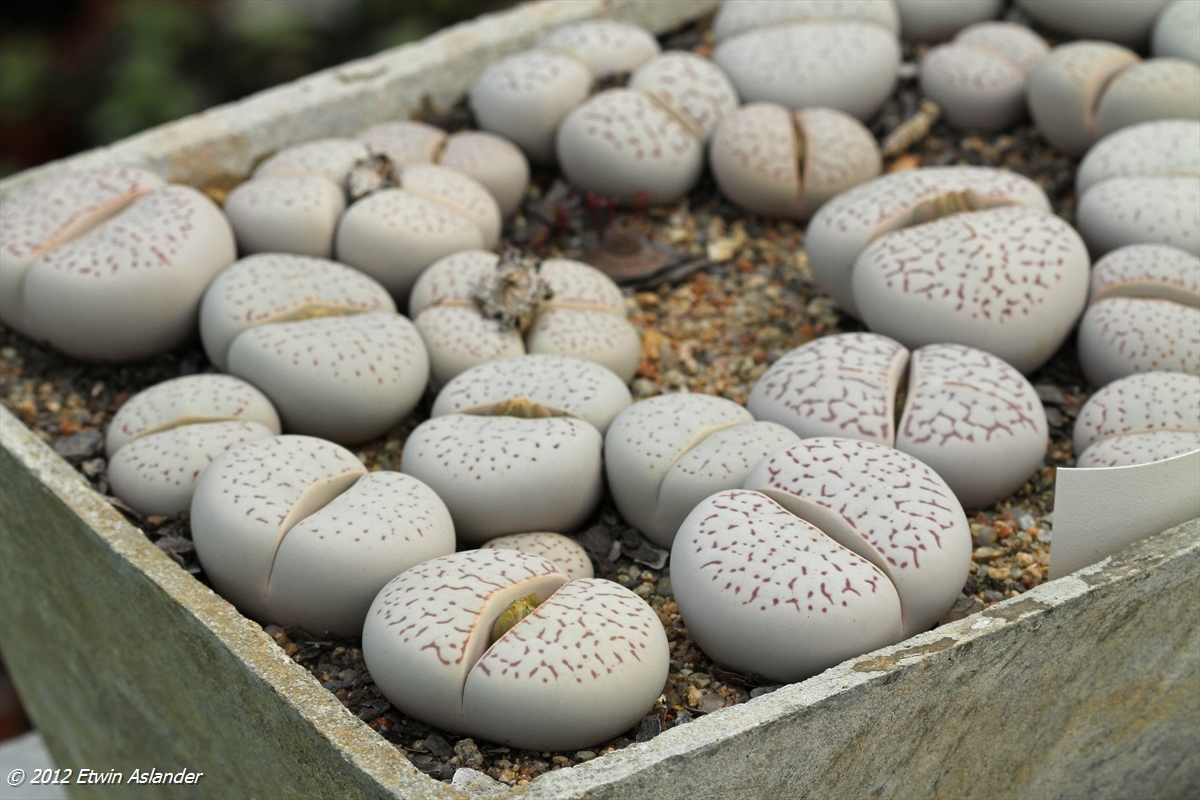
Dinteranthus succulents are stemless, giving them the appearance of white round rocks sitting on the ground. They do bloom flowers in the spring, which are yellow in color and sprout from a crevis in the bulbs.
Dinteranthus is truly a small succulent as they won’t grow any taller than 1.6 inches. They do like to be grown in pairs, however, which may lead you to plant these succulents outdoors to give them room to grow outwards rather than upwards.
25. Ebracteola
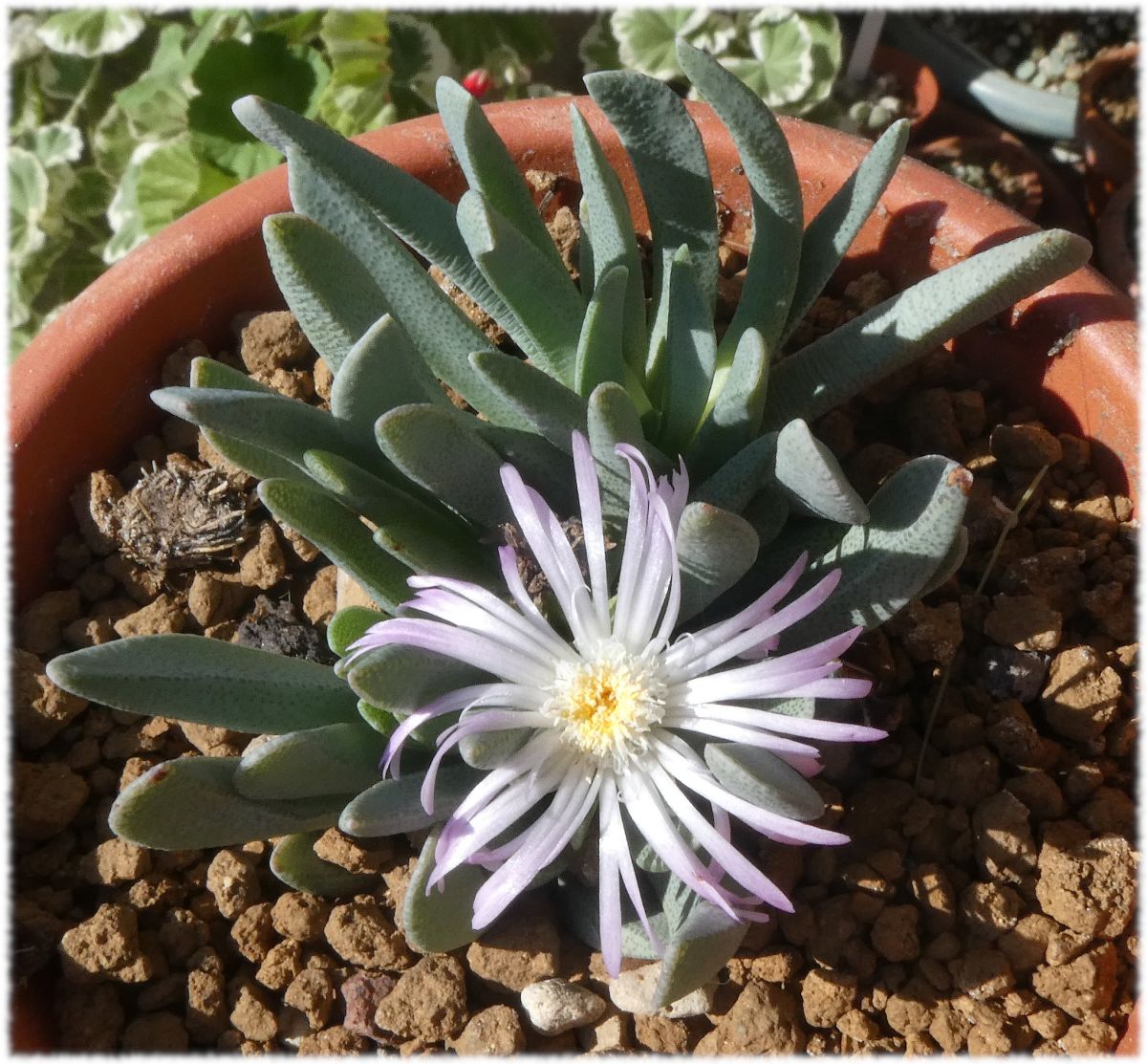
Ebracteola are a type of succulent within the ice plant family. They tend to grow in sets of 2 or 3, with branches that grow up and out around a flower. The leaves of the Ebracteola are blue or grey and quite thick. The flowers are typically purple.
Ebracteolas can be both an indoor plant or an outdoor plant depending on your preference. Unlike other types of succulents, Ebracteolas adjust well to locations with higher rainfall and do not do well during a drought so you shouldn’t plant them outside in desert locations.
26. Frithia
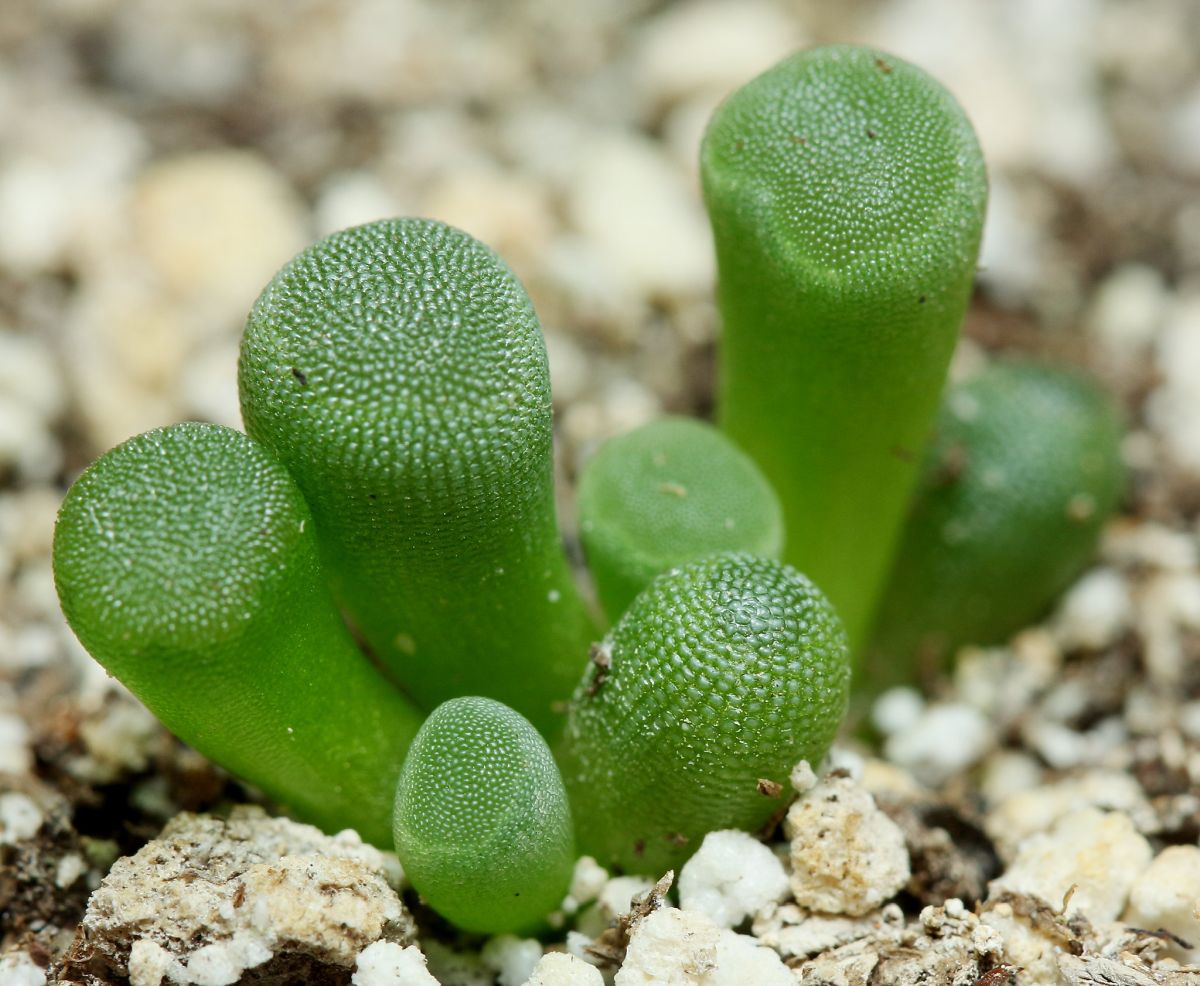
Frithia is one of the small, low-growing types of succulents that blooms in the summer rather than the spring. While they don’t grow very high, they grow thick leaves that often look a bit like fingers.
The leaves range from light to dark green with a clear ‘viewing window’ at the top. The flowers range from red to purple and sprout directly from the viewing window. While these are meant to be grown outdoors, they do need partial shade as they will be scorched in direct sunlight.
27. Gibbaeum
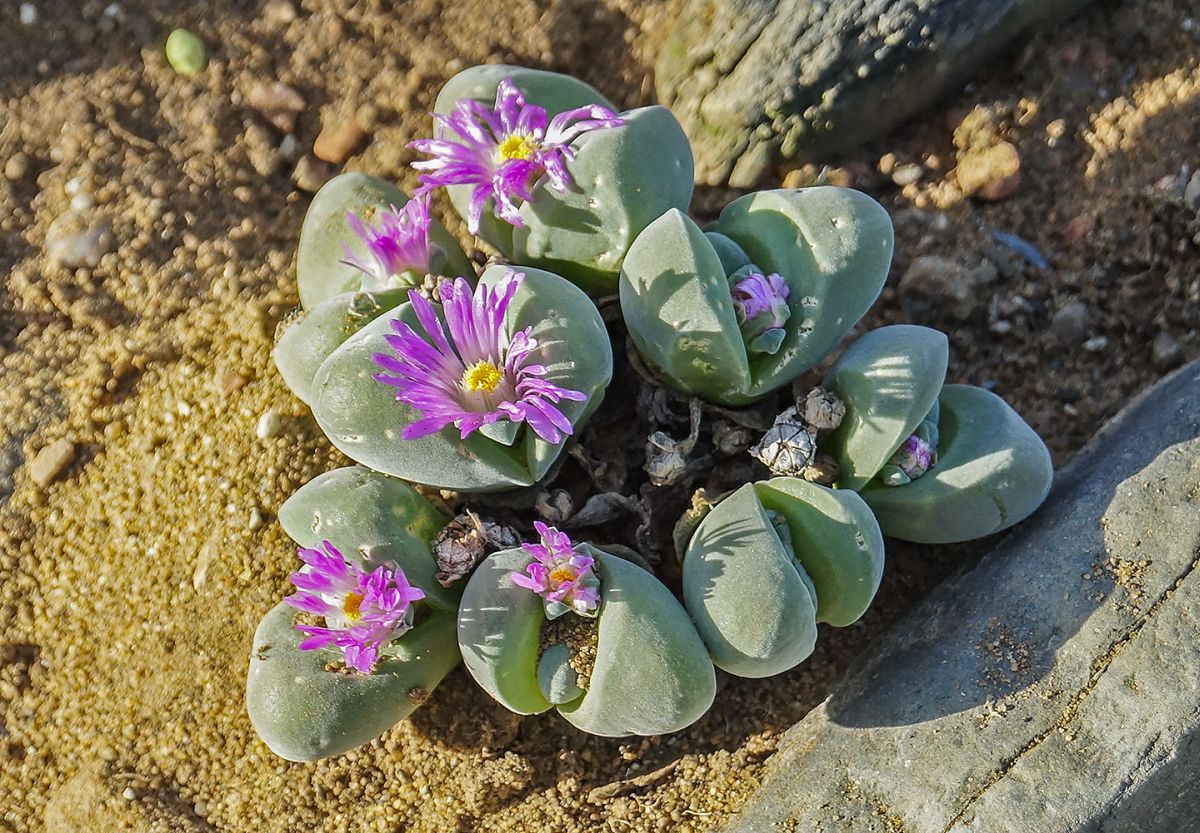
Gibbaeum are flowering plants native to South Africa and are considered succulents because of their fleshy leaves. They like to grow close to the ground, so you can be certain that this plant won’t grow too tall to overshadow your entire garden.
These types of succulents are outdoor plants and typically prefer a more dry climate. For those that live somewhere rainy, you can attempt to grow Gibbaeum inside, but know it is not their preferred habitat.
28. Plush Plant
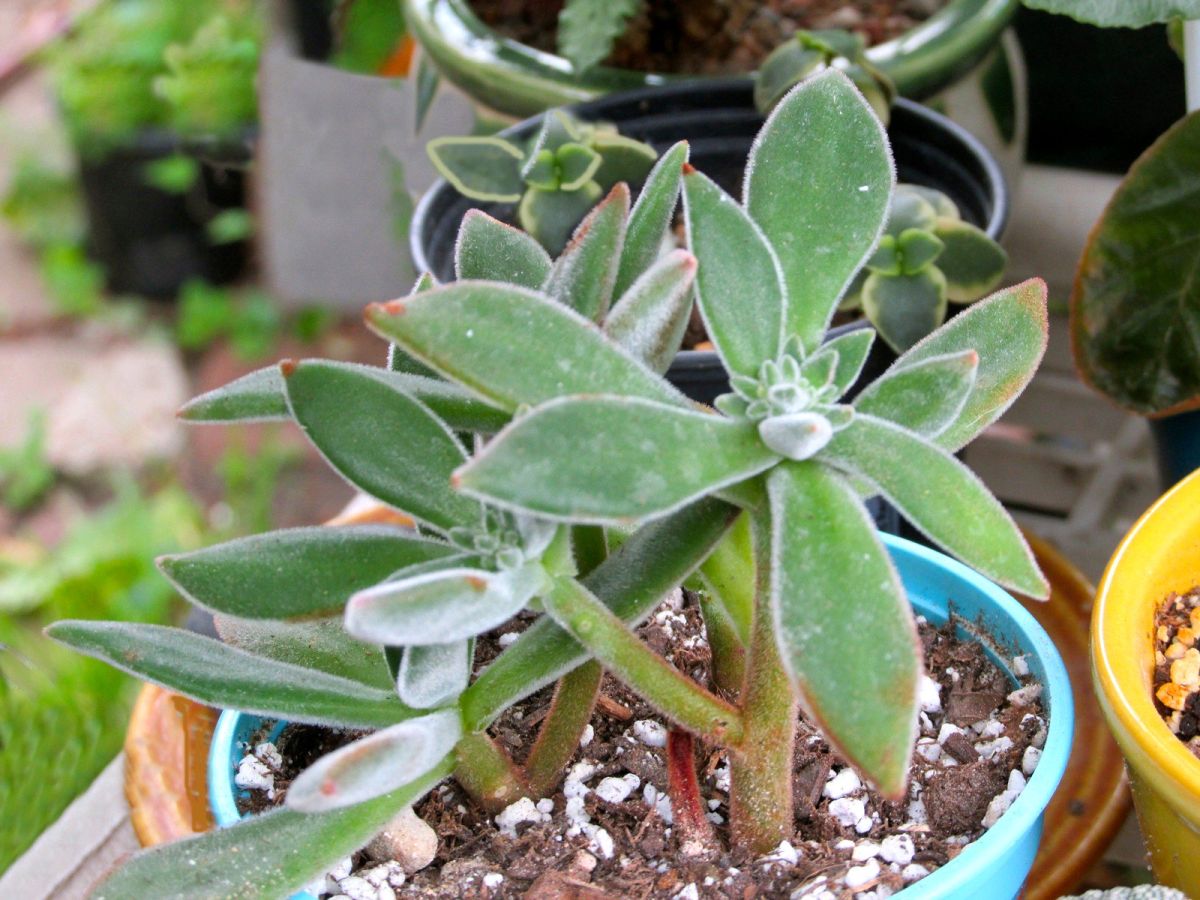
Plush plant is a type of Echeveria succulent that grows fleshy green leaves in the rosette shape while being attached to a woody stem. The combination gives them the appearance of looking like a little tree straight from a magical land.
The plush plant is native to Mexico and can surprisingly reach heights of 12 inches, but it takes a significant amount of time for it to reach that height. Thus a plush plant is an ideal house plant.
Plus, a plush plant will bloom in spring, with beautiful two-tone flowers that are sure to gain compliments from all who happen to see them.
29. Pincushion Cactus
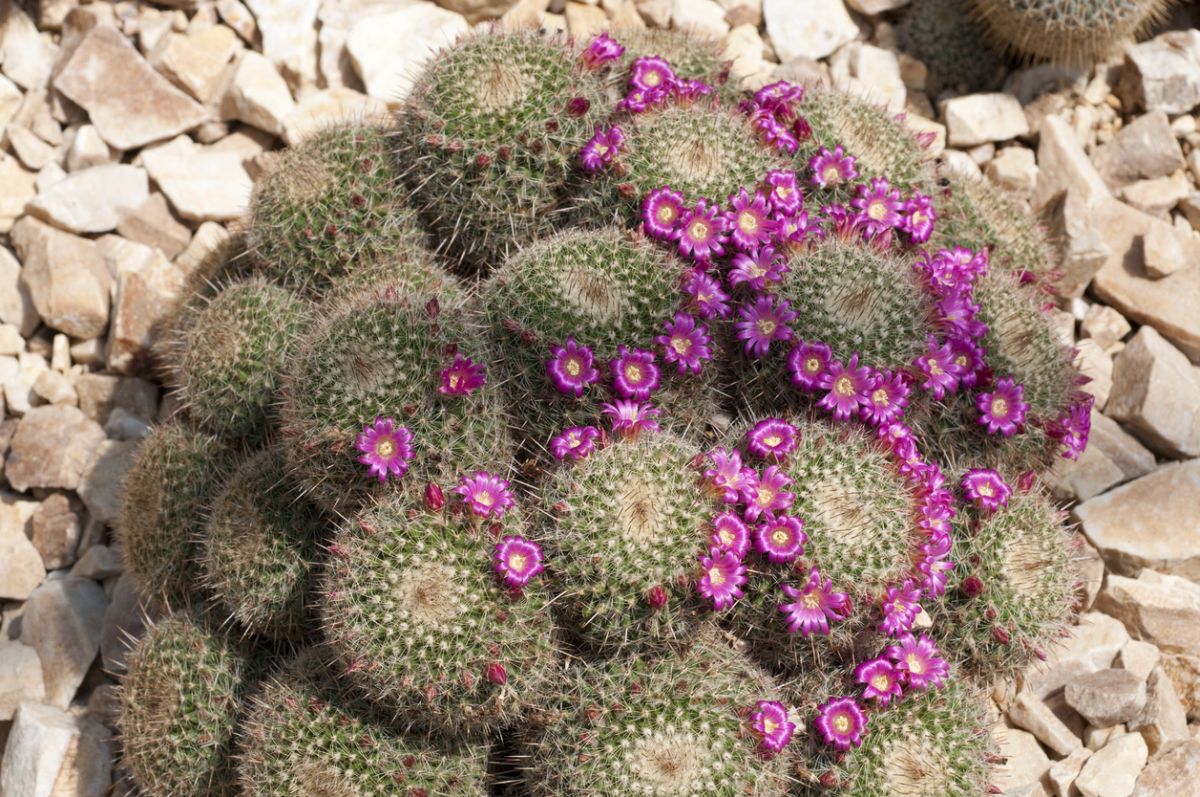
The Pincushion cactus is a favorite in the succulent world as these types of succulents remain small for their entire lives. Therefore they are the perfect succulent to plant in a jar and place on a desk or in a bedroom.
Pincushio cactus, besides just being cute, also bloom adorable pink flowers that often present themselves in a circular shape. Plant these succulents in a mixture of soil and manure, then line the top with rocks, and you will have a happy, adorable, Pincushion cactus for years to come.
30. Sedum Succulents
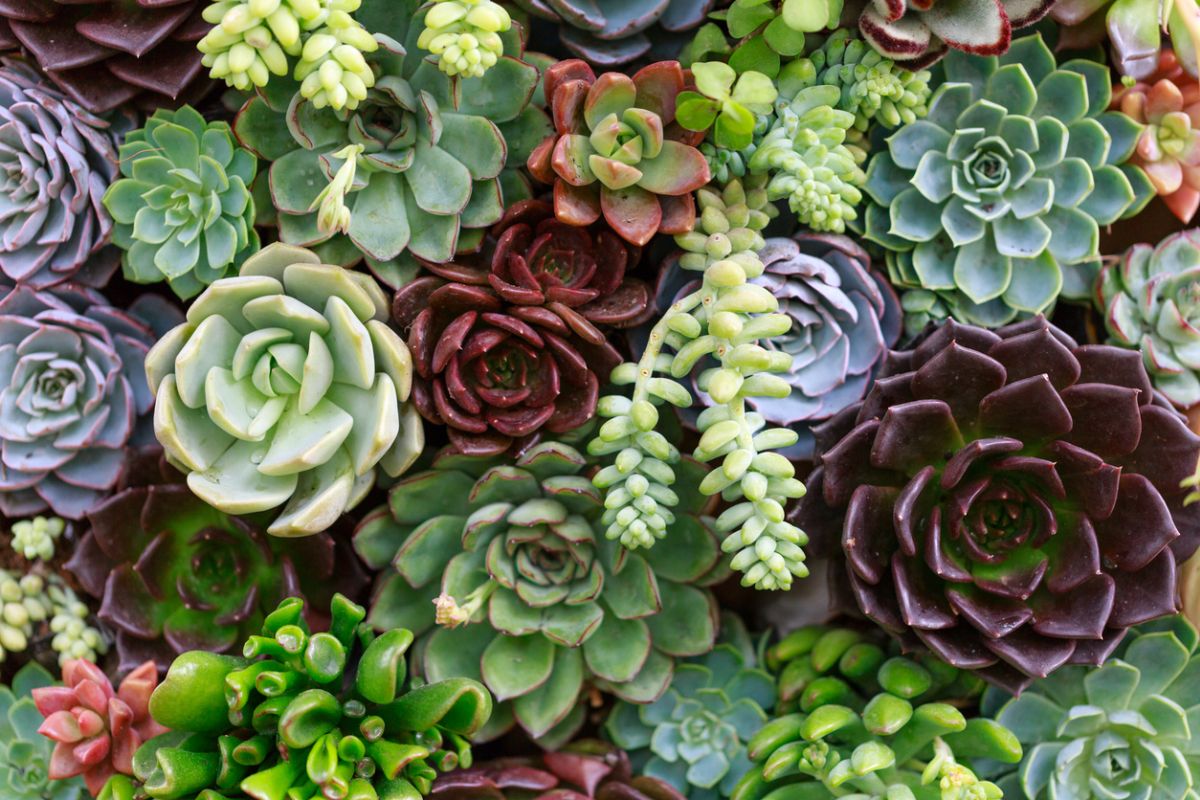
Sedum succulents are small succulents with green fleshy leaves that grow in different stacked shapes depending on the one you pick. Some look like little pine boughs while others look like flowers.
Various types of sedums do bloom, but others do not so check into this before you buy if you are wanting to enjoy some beautiful flowers at different times during the year.
31. Lapidaria
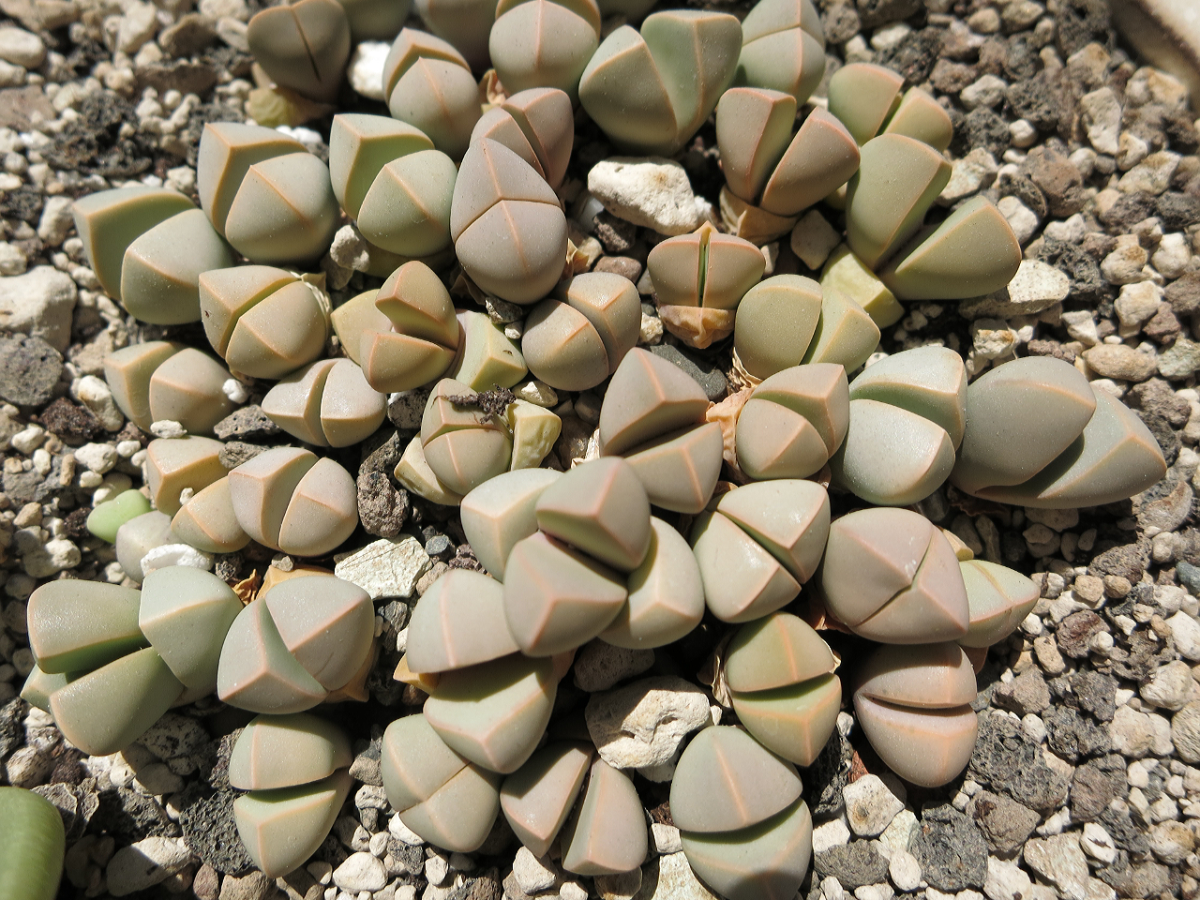
Lapidaria are easy to identify when it comes to succulent identification because of their unique shape and size. They are cacti, but they grow close to the ground in a shape that closely resembles a small pile of rocks.
The only giveaway that these are not rocks is their greenish color with pink hues and the fact that a “pile” of these are all attached to one another. Lapidaria need plenty of water, and they only flourish in a hot, desert-like environment.
32. Lithops
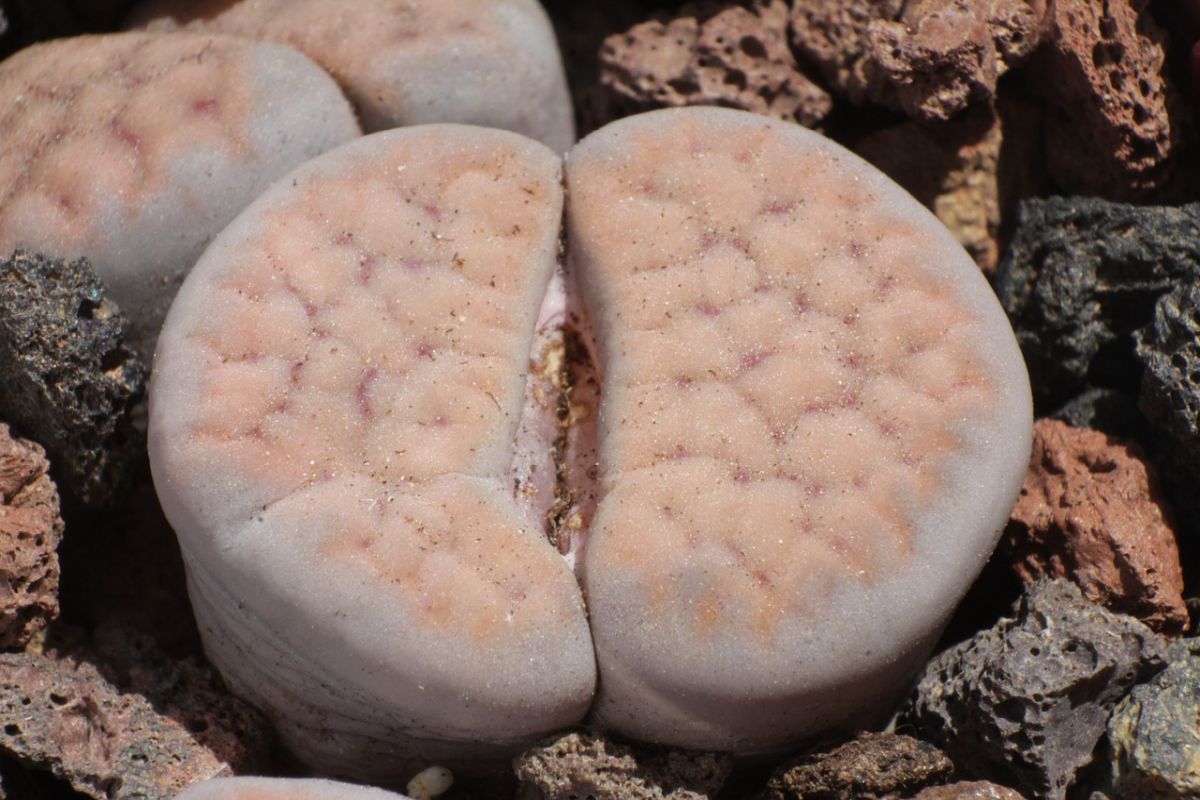
Lithops are small succulents that look almost exactly like stones. Like Lapidaria, they are similar in shape and size to stones, but unlike the Lapidaria, they grow singularly, so each Lithops looks like a single pebble or rock.
Plus, Lithops don’t just come in a single color, rather they can be found in shades of gray, brown, red, green, and even pink. A pot can start with a single Lithops and propagate into multiple within a few years if given enough space to do so.
33. Monanthes
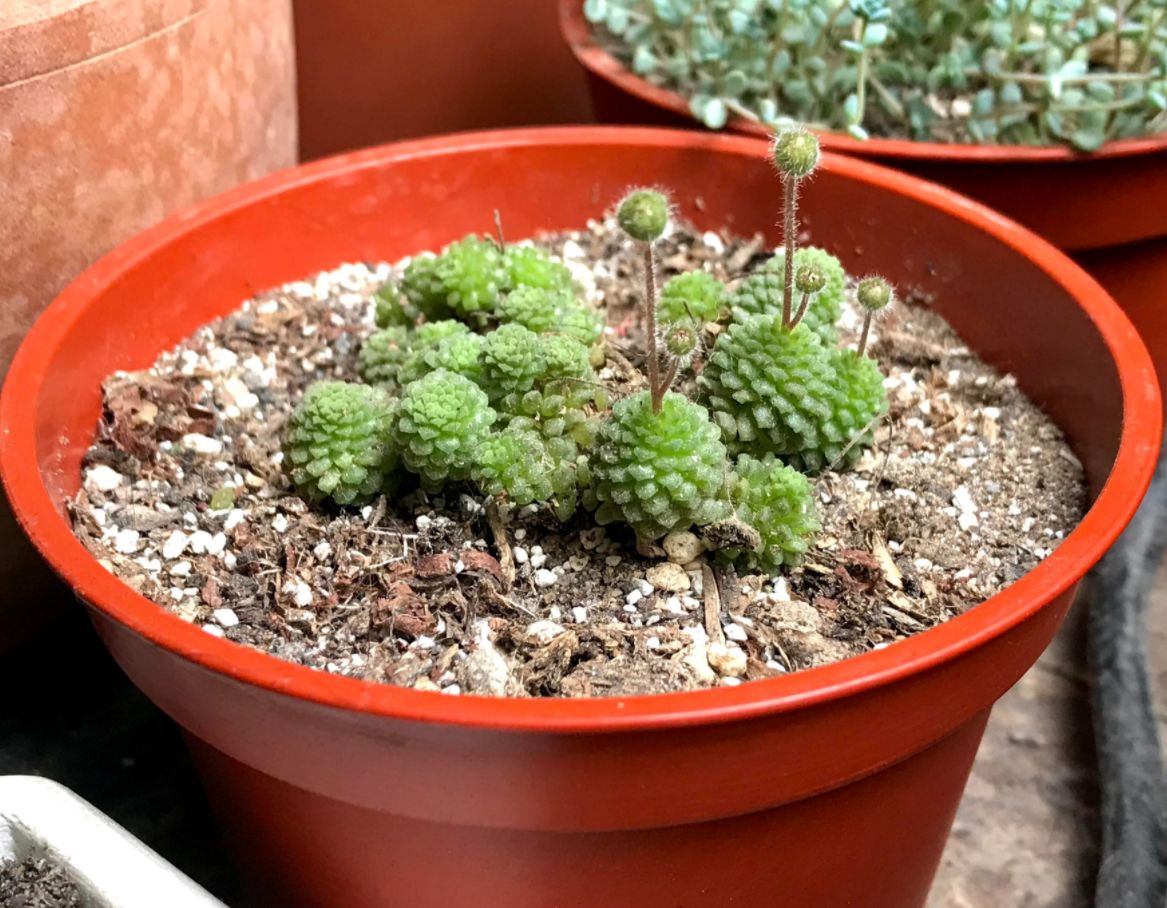
Those who live in Florida, or other subtropical locations should look into the Monanthes succulent which is a small sub-species native to the Canary Islands. These cure little succulents look a bit like a pom-pom with their round and fuzzy appearance.
Monanthes can be planted indoors or outdoors, but they need a slightly humid rather than a dry environment. Be cautious not to overwater them, however, as these succulents grown indoors need significantly less water than those grown outside.
34. Monilaria
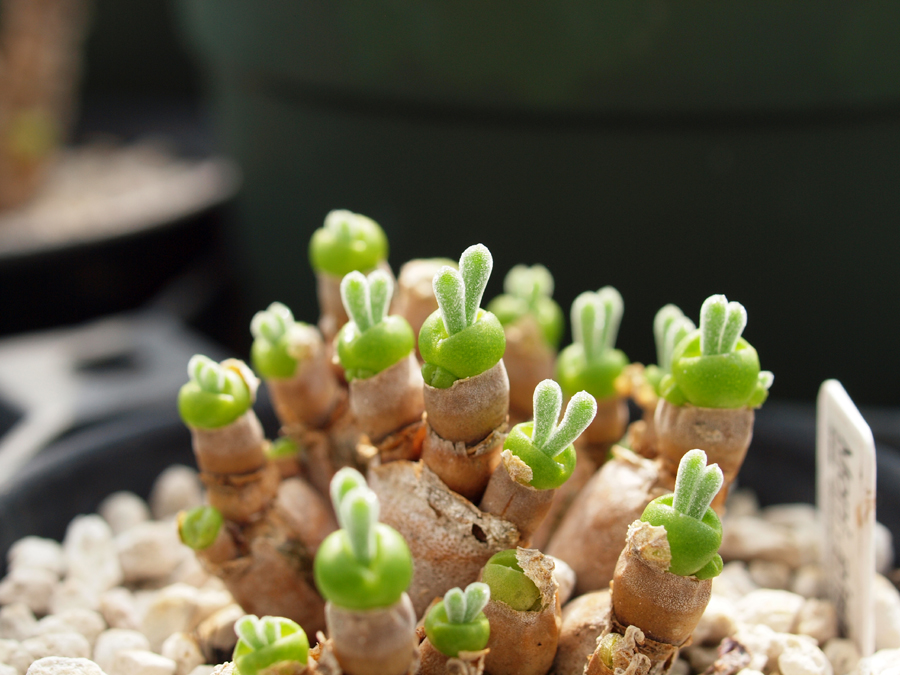
Monilaria are often called bunny succulents because of the way they sprout which looks like a bunny. First, the Monilaria grows a green bulb, then two leaves grow out of this bulb forming a little bunny head.
Sadly, it is difficult to get a Monilaria to adapt to life outside of where they are naturally found in Africa. They have very specific soil preferences, and while they can be resistant to frost, are very picky about their sunlight and temperature habits.
It is not recommended to select a Monilaria unless you are an experienced succulent parent.
Types of Tall Succulent Plants
35. Aeonium
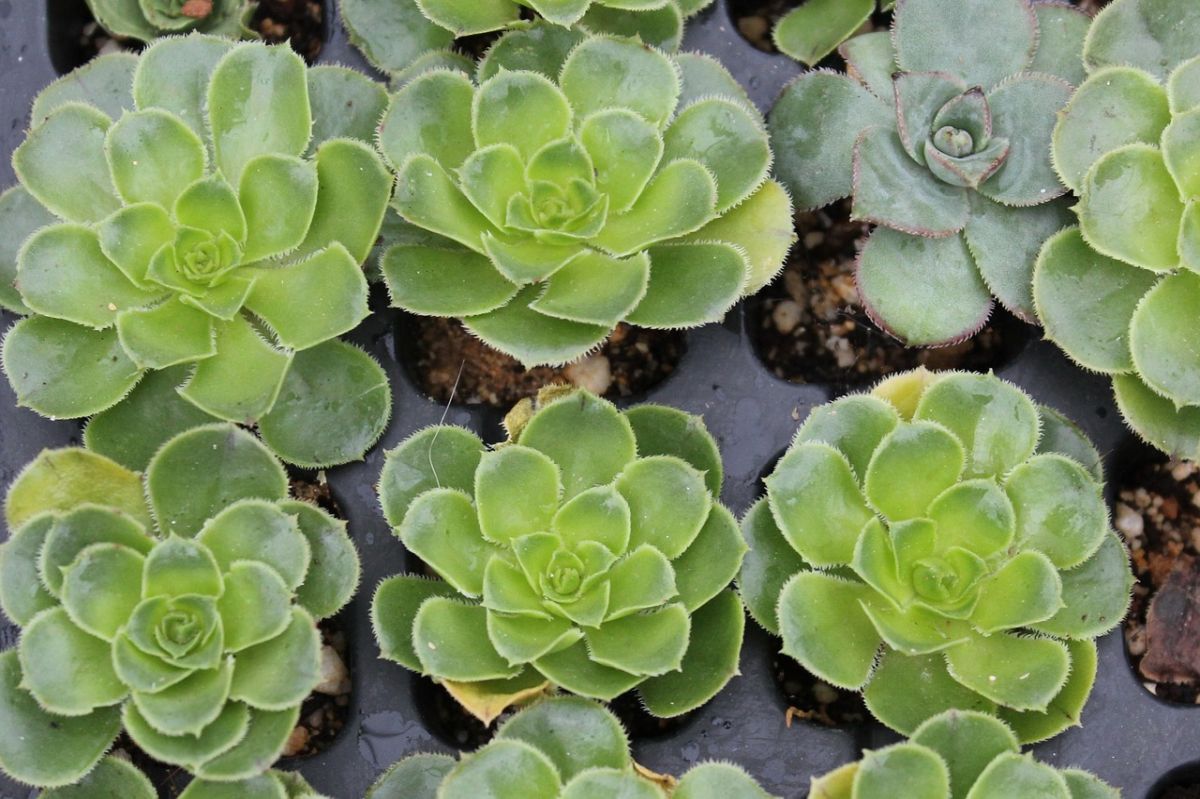
Aeonium are popular succulent plants which grown in the typical flower shape. The petals of the “flower” are thick and fleshy, as they are actually the leaves of the plant, thus this succulent will survive anything which is thrown its way.
Be careful, however, as aeonium succulents can grow to be four feet tall, making them difficult to keep inside. If you do have a place for the outdoors, know that they can survive light frosts and go dormant in the winter. Just be sure not to water them during their dormant period.
36. Braunsia
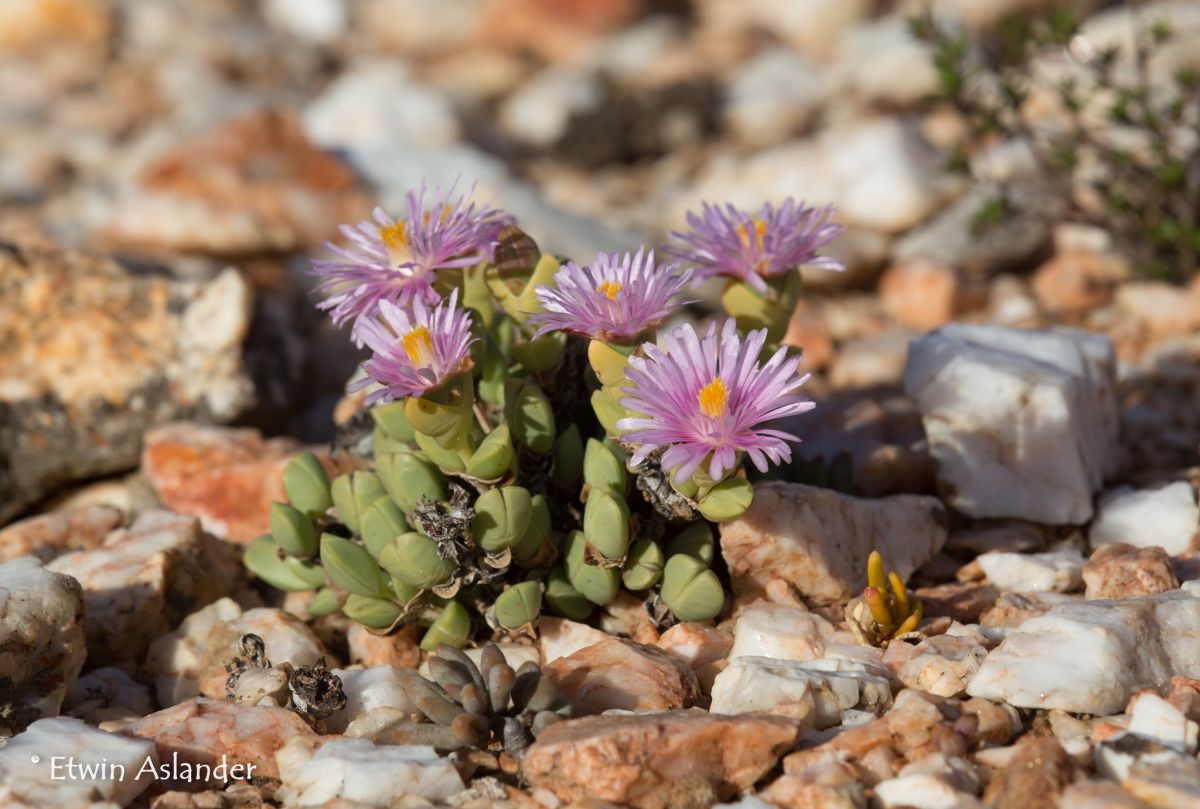
Looking for some tall flowering plants? Look no further than the Braunsia, which blooms with rose-colored flowers every spring. Braunsia plants grow tall, and while they won’t wind up a trellis, they would appreciate the partial shade of being placed near one.
The Braunsia succulent grows well outdoors as it can tolerate high temperatures as well as a little frost. While it does need some shade during the hot summer months, don’t be afraid to let this succulent get some bright light the rest of the year.
37. Euphorbia
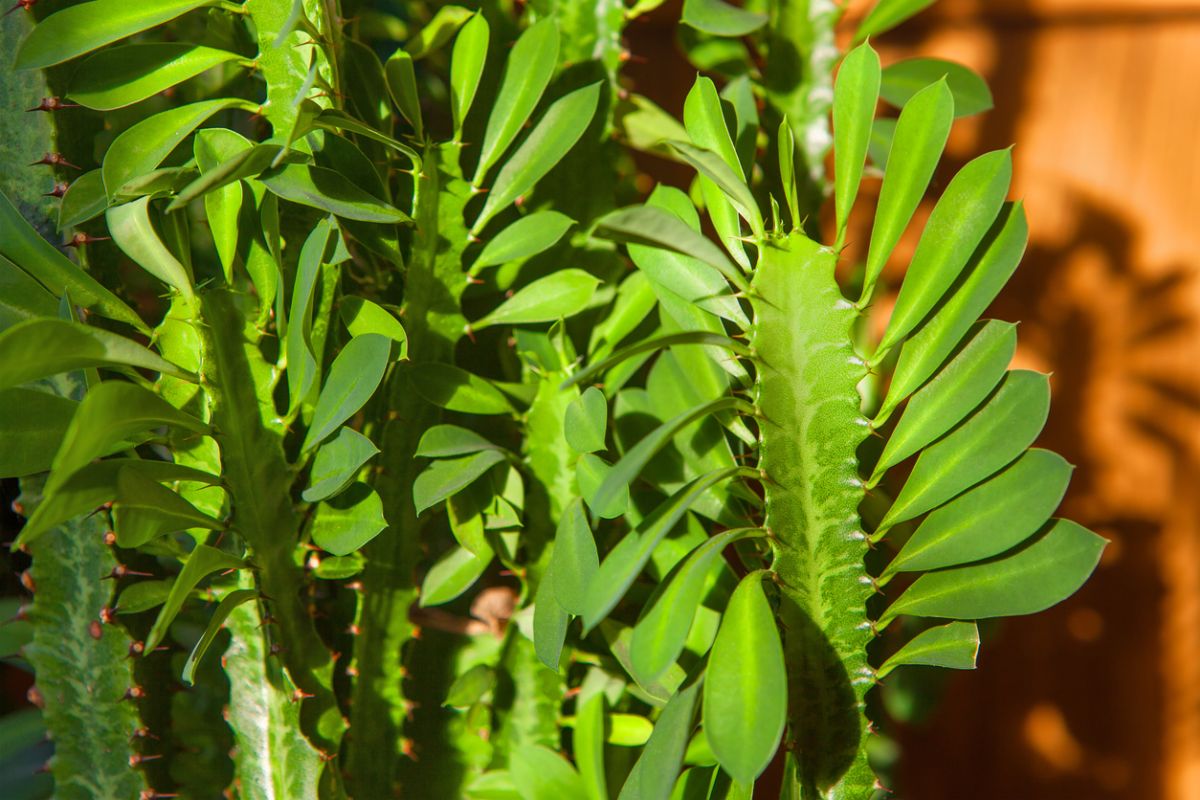
Sometimes, you want succulent plants that will make a statement rather than occupy a small space on the table. When this is the case, you will want to buy a Euphorbia.
Some plants in this genus are as small as weeds while others can get as large as trees. What they do have in common is that they are all cacti.
Euphorbias are not flowering plants, but they do come in all shapes, sizes, and colors. Because they get so large, they are typically considered outdoor succulents, but they can be kept inside while they are still small.
38. Furcraeas
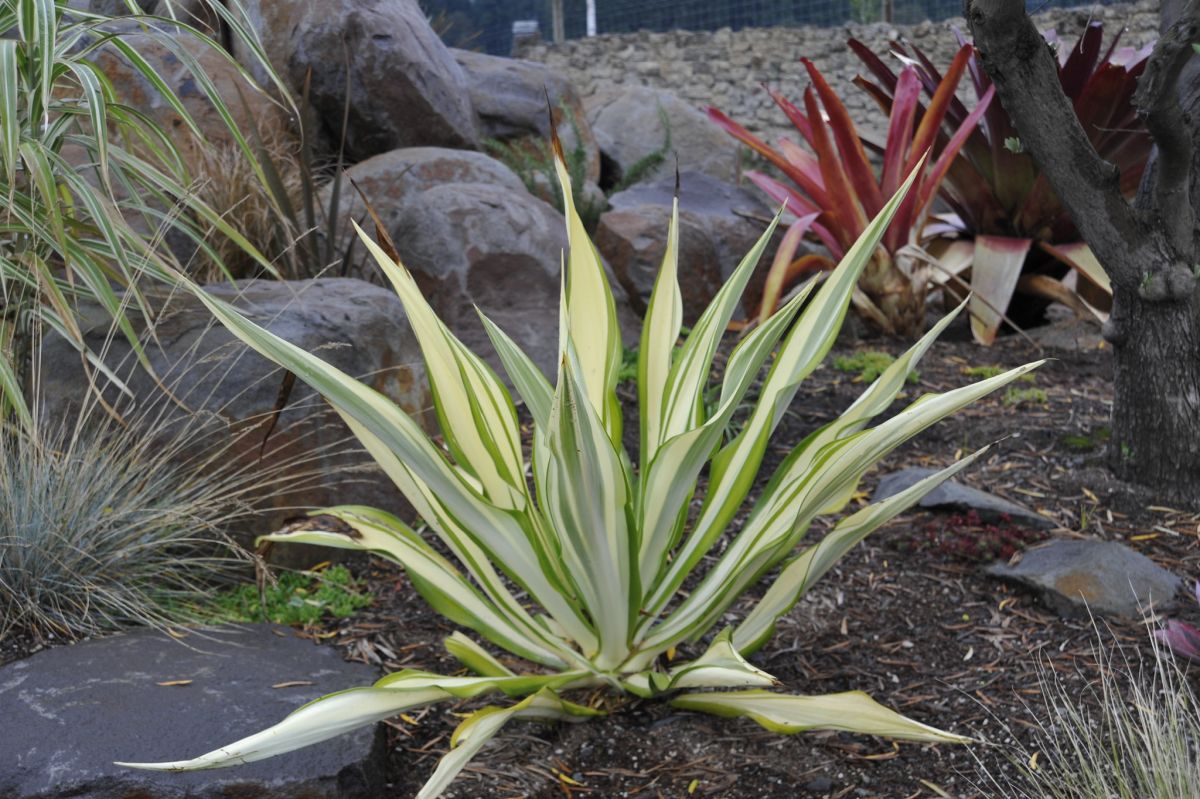
Furcraeas are often called the giant agave or aloe vera look-alikes, but the reality is, while they might be the same size, they don’t have any of the same properties.
They must be grown outdoors as their large green leaves, which look a bit like spines, will grow both upwards and outwards until they are the size of a large bush.
Furcraeas can vary widely from plant to plant, as some have spiny leaves like the aloe vera while others have smooth leaves that are soft to the touch.
There will be no succulent flowers with this plant, so if you are looking for something bright and colorful for your rock gardens, it’s better to pick a different succulent species on the list.
39. Zebra Plant
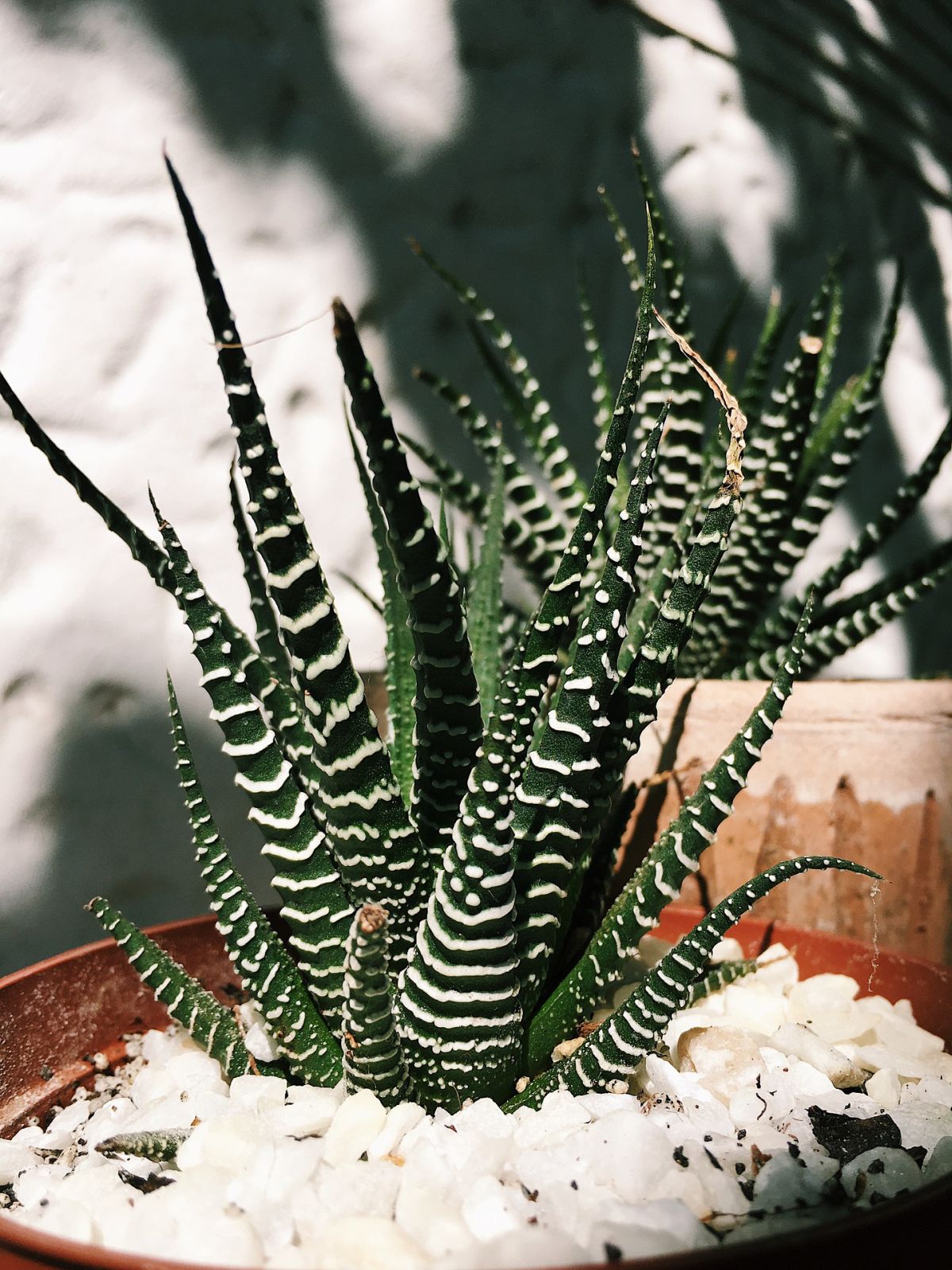
Unlike the other large types of succulents on this list, the Zebra plant is a tall succulent that needs to be grown indoors. Although the Zebra plant can reach heights of 1 or 2 feet tall, it is intolerant to the temperature and light changes found outdoors.
A Zebra plant needs bright, but indirect sunlight. It also needs a high level of humidity, otherwise, its dark green leaves will begin to brown. Besides these few requirements, the Zebra plant is one of many easy indoor succulents to care for and is recommended for first-time plant parents.
40. Torch Plant
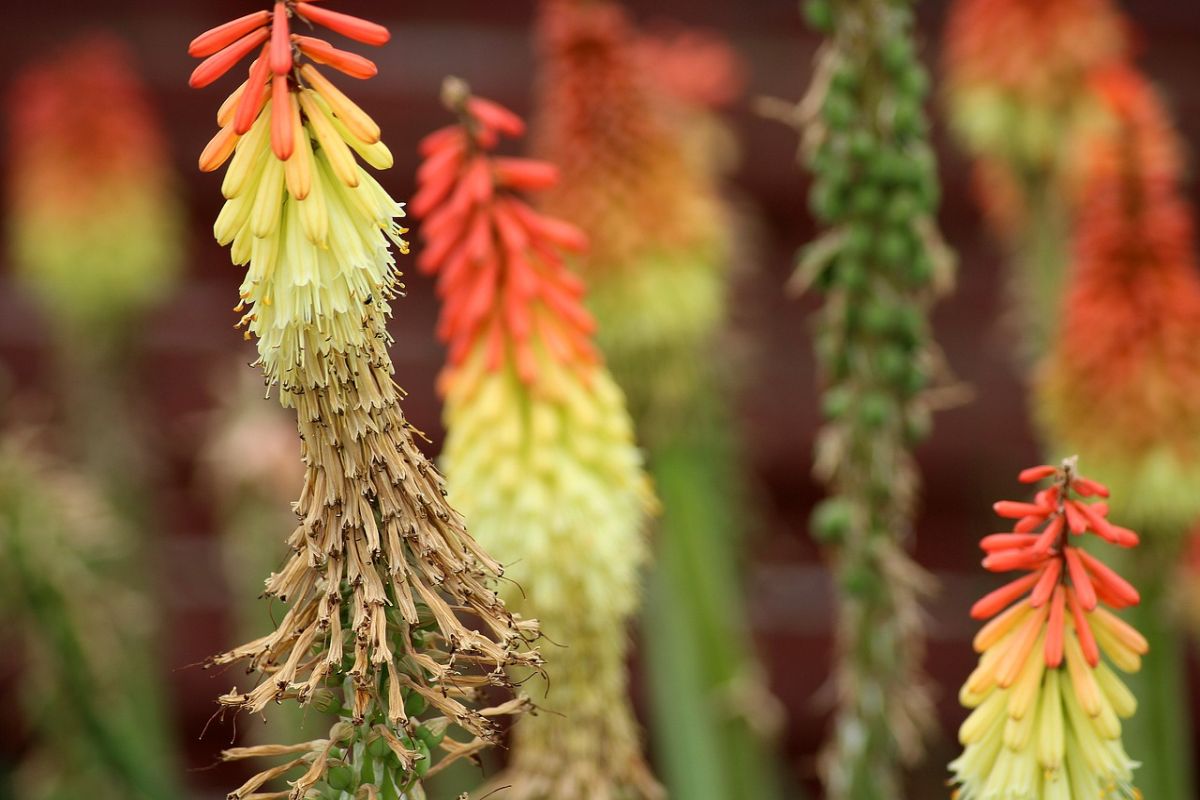
You may be familiar with a succulent that goes by the name Torch plant, but the truth is, this fancy-looking succulent is a type of aloe plant.
A Torch plant will grow best when planted outdoors where it will have access to full sun. Its green leaves will be a more pale color in the shade, transforming to their dark green glory only when they hit the light.
A healthy Torch plant will reach 8-12 inches tall in both rock gardens or when planted directly in potting soil. These plants are a good idea for a first-time gardener as they are resistant to most animals (such as deer) and practically disease-free.
Types of Flowering Succulents
41. Adenium
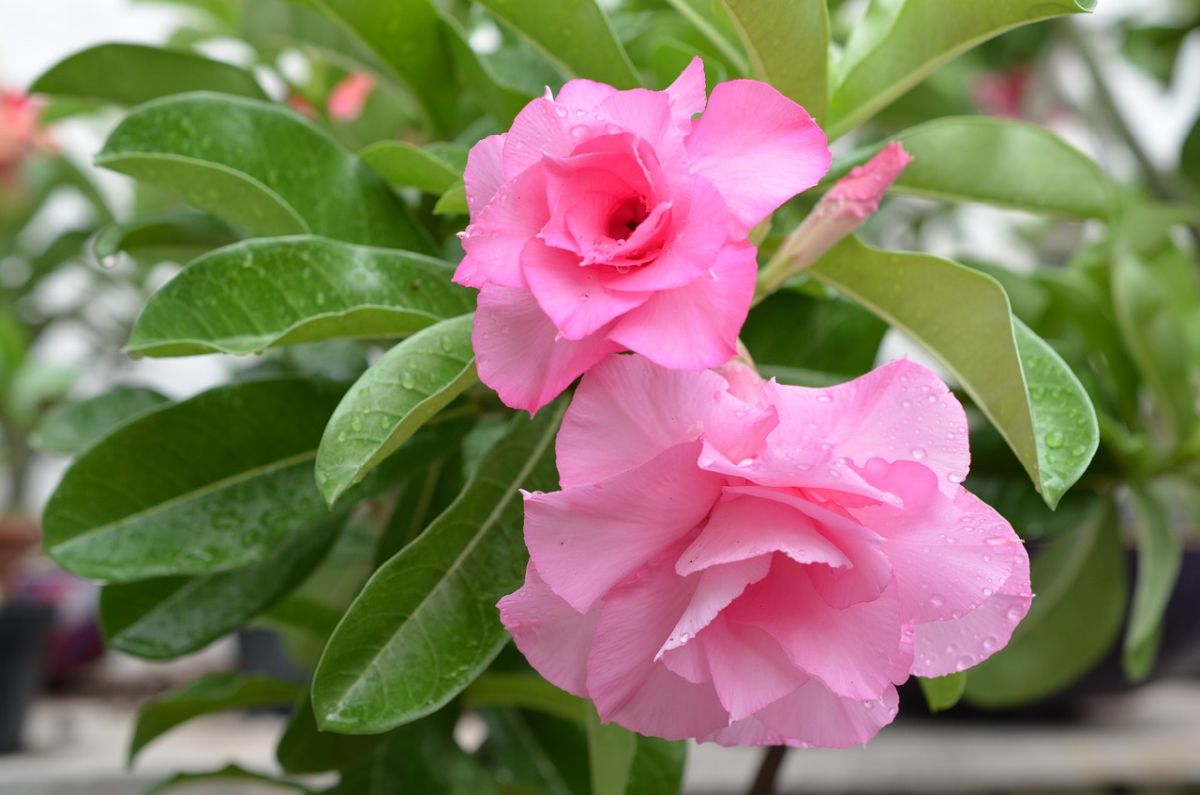
Adenium is a flowering succulent most widely known for its beautiful pink flowers. These flowers are more delicate than those found on some other types of succulents, but this plant still has a sturdy, thick stem placing it in the succulent category.
Adeniums grow best in a pot with rocks and can frequently be used for bonsai-type plant decorations because of the woody stems that give them a tree-like appearance.
42. Antegibbaeum
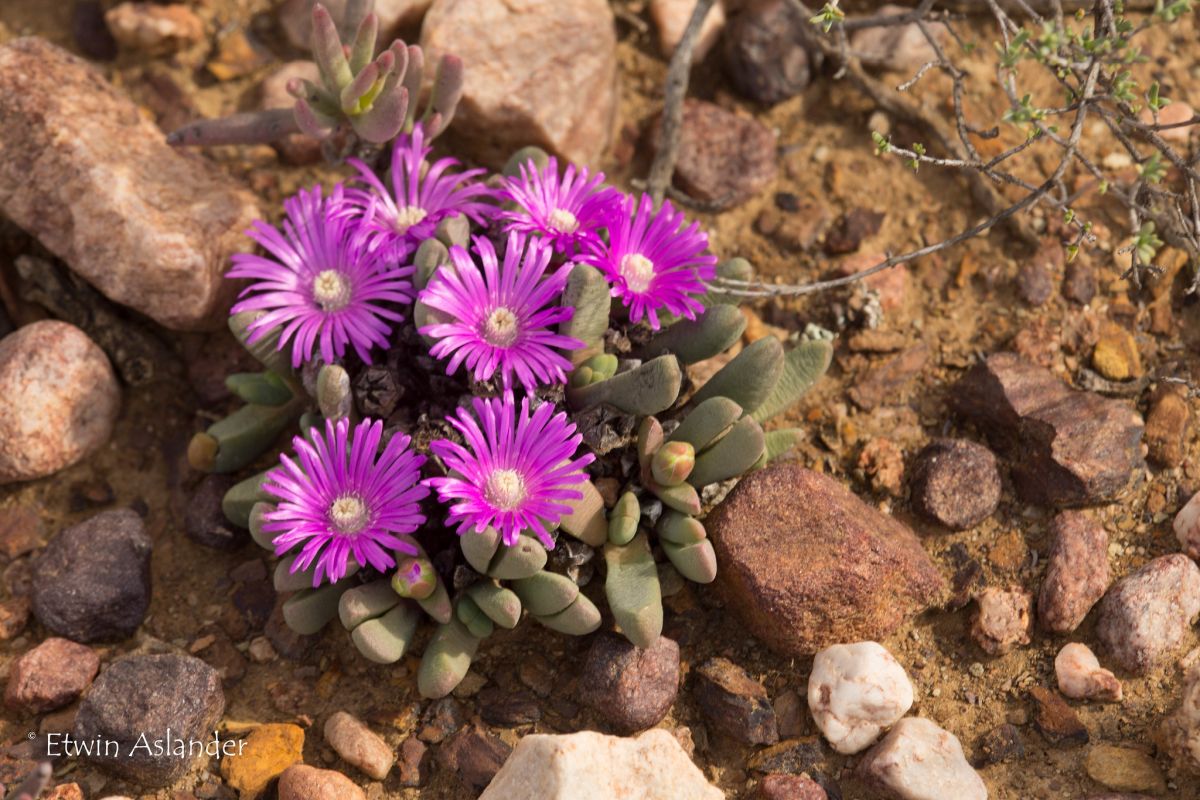
The Antegibbaeum succulent is the only one in its succulent genus and it is a unique looking plant that only grows a few inches tall. It is typically brown in color and grows in clusters that expand outwards rather than upwards.
The Antegibbaeum is one of many flowering succulents that bloom with pink flowers and red flowers in the early spring. These succulents aren’t particularly pretty without their flowers, as they often grow a black fungus on their leaves, but they are one of the very few succulents that can grow in clay soil.
43. Antimima
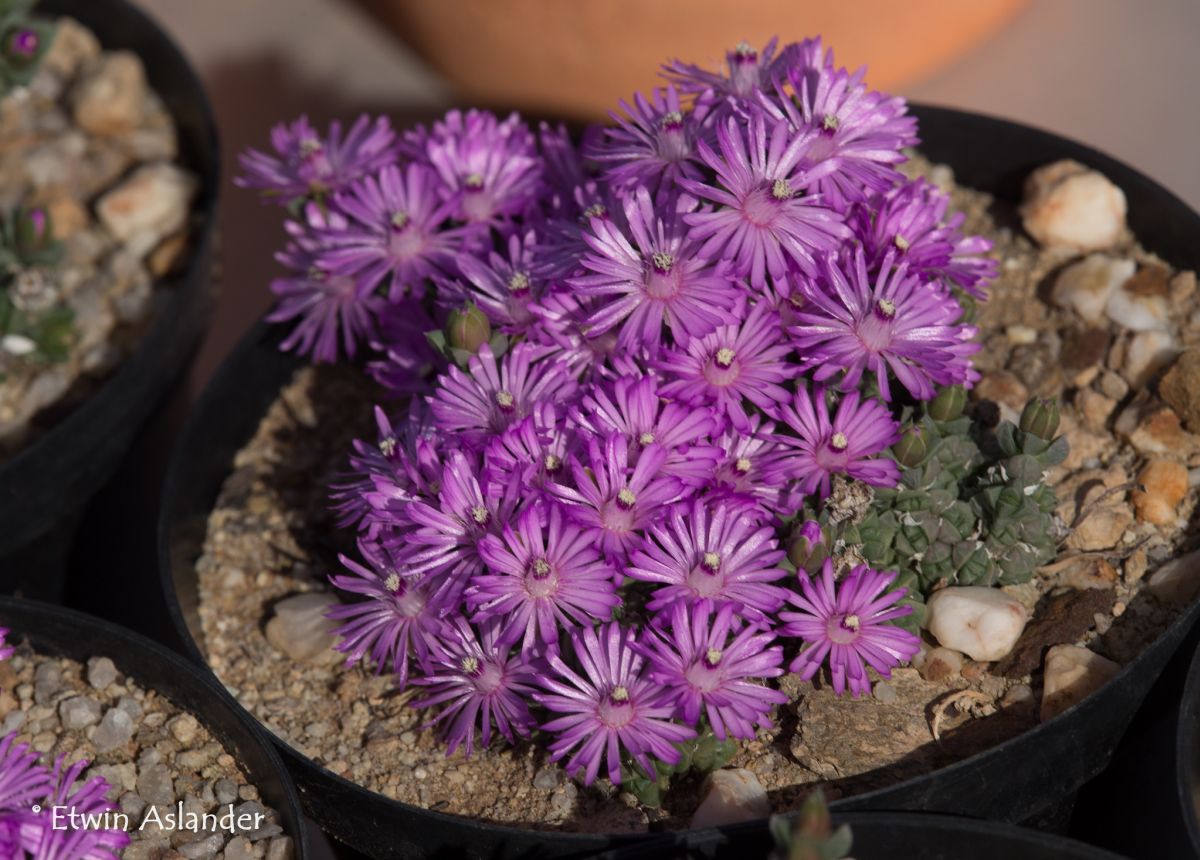
When looking for a flowering succulent, look no further than the Antimima which is a flowering succulent that will grow in a dense mat or cushion-like shape. The flowers these plants are known for will appear late in the spring and will come in a wide variety from pink to white flowers.
Antimima succulents can be placed indoors or outdoors, though most people report they grow better when placed outside with lots of space to reach their full potential.
44. Bijlia
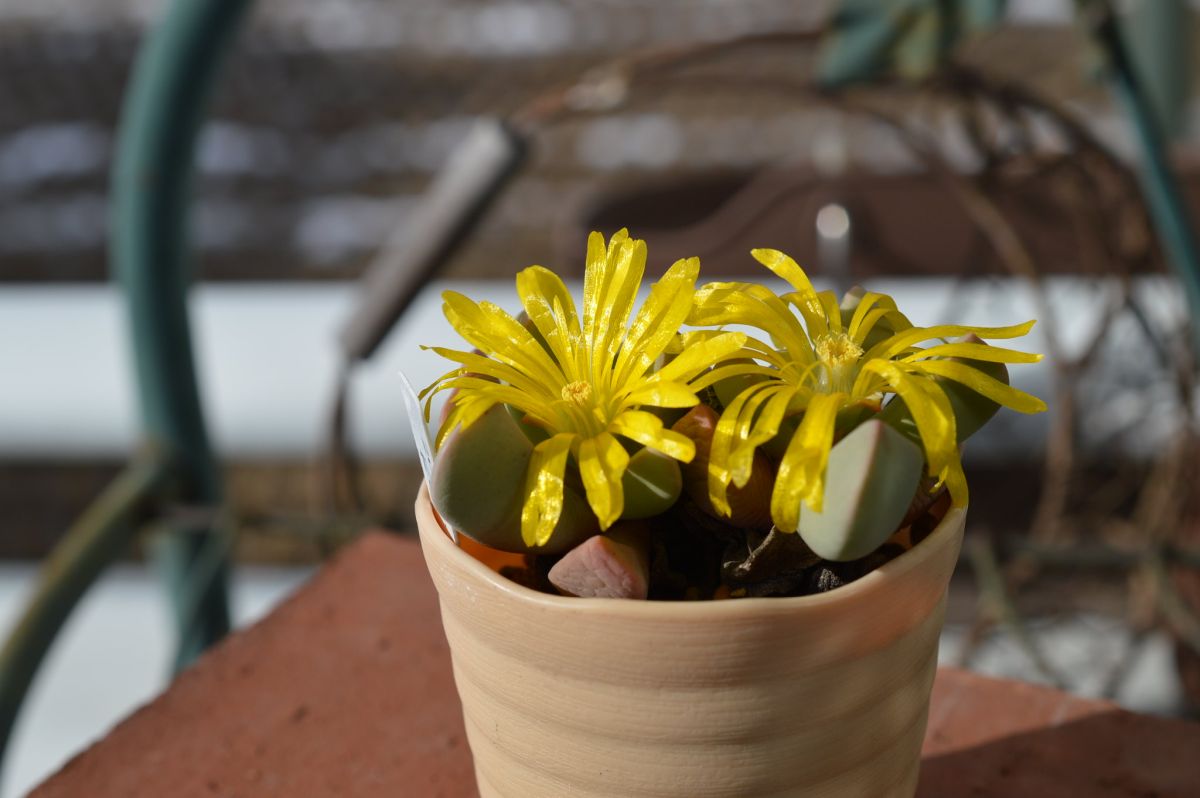
The Bijlia is a flowering succulent plant with yellow flowers that have thin petals. Growing succulents like the Bijlia is often very easy for beginners as these plants are known to grow through rock in nature.
Without their flowers during the non-spring seasons, these flowering plants can frequently be mistaken for cacti because of their light green leaves that grow in pointy, outward shapes.
45. Cheiridopsis
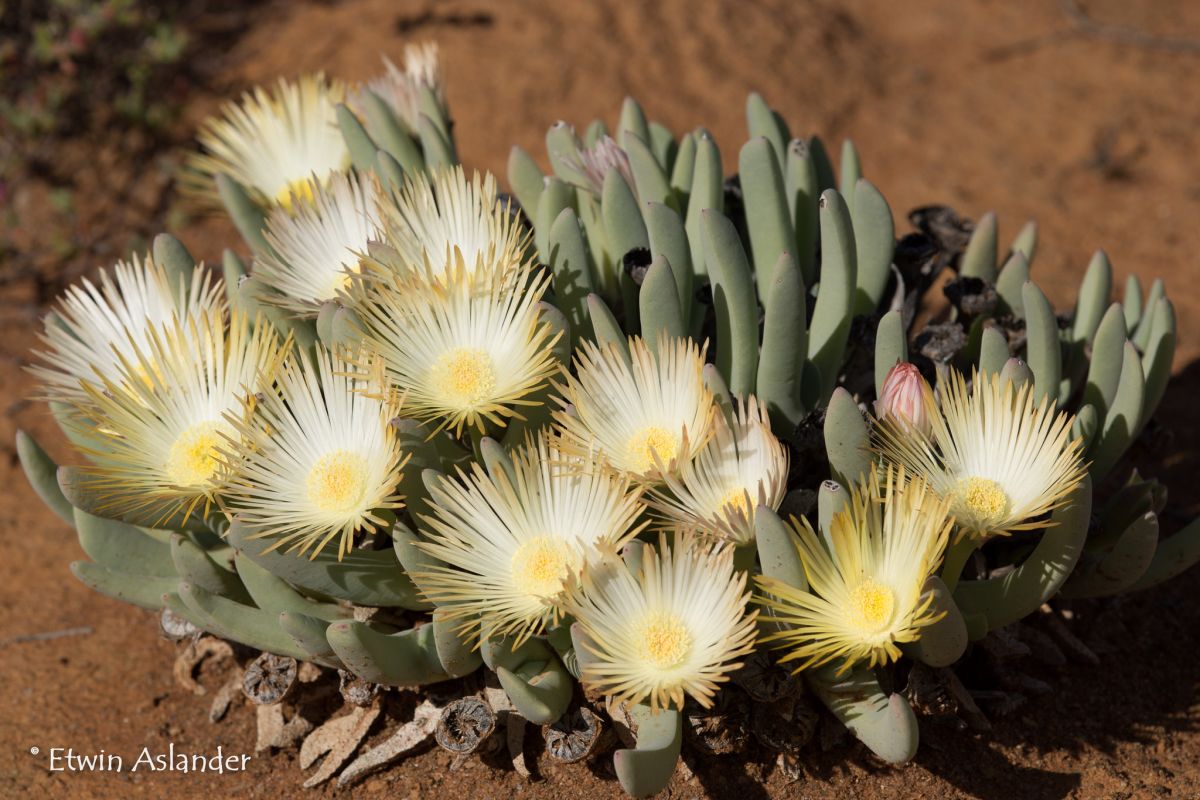
Cheiridopsis isn’t the name of a single succulent, but rather a group of flowering succulent plants that are native to South Africa. These plants are perennial succulent plants, meaning you can plant them once and they will bloom succulent flowers year after year.
When they aren’t in bloom, these succulent plants look like small cactus plants, and they can do well as outdoor or indoor plants.
46. Glottiphyllum
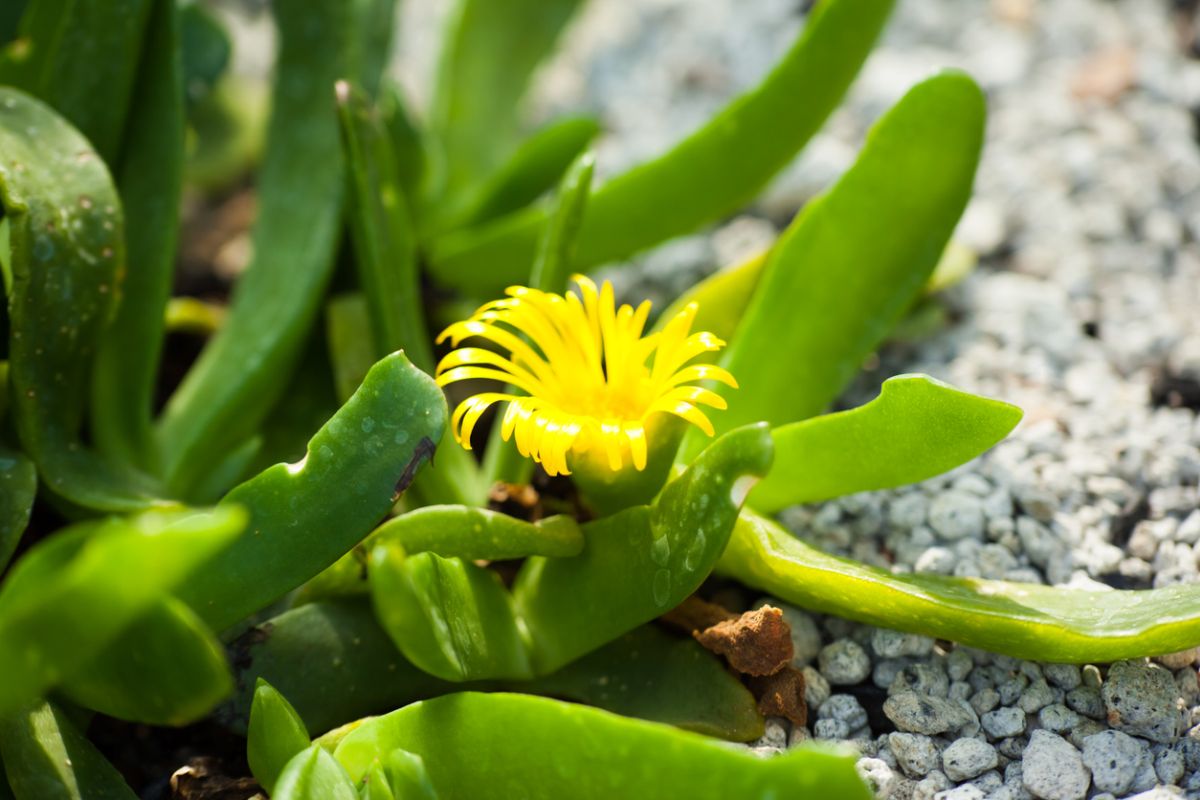
Glottiphyllum succulents are flowering plants with bright green fleshy leaves that can sometimes give the appearance of being a tongue. Unlike aloe vera, the Glottiphyllum succulent will stay compact for its entire life, making it a better accent to a garden rather than the main focal point.
Glottiphyllum have woody stems, but don’t be deceived because they are quite delicate. A Glottiphyllum will not do well if it is trampled.
The yellow flowers on this plant emerge during the late fall or early winter months, so you can add them to a spring and summer-blooming garden to ensure you have flowers all year round.
47. Ihlenfeldtia
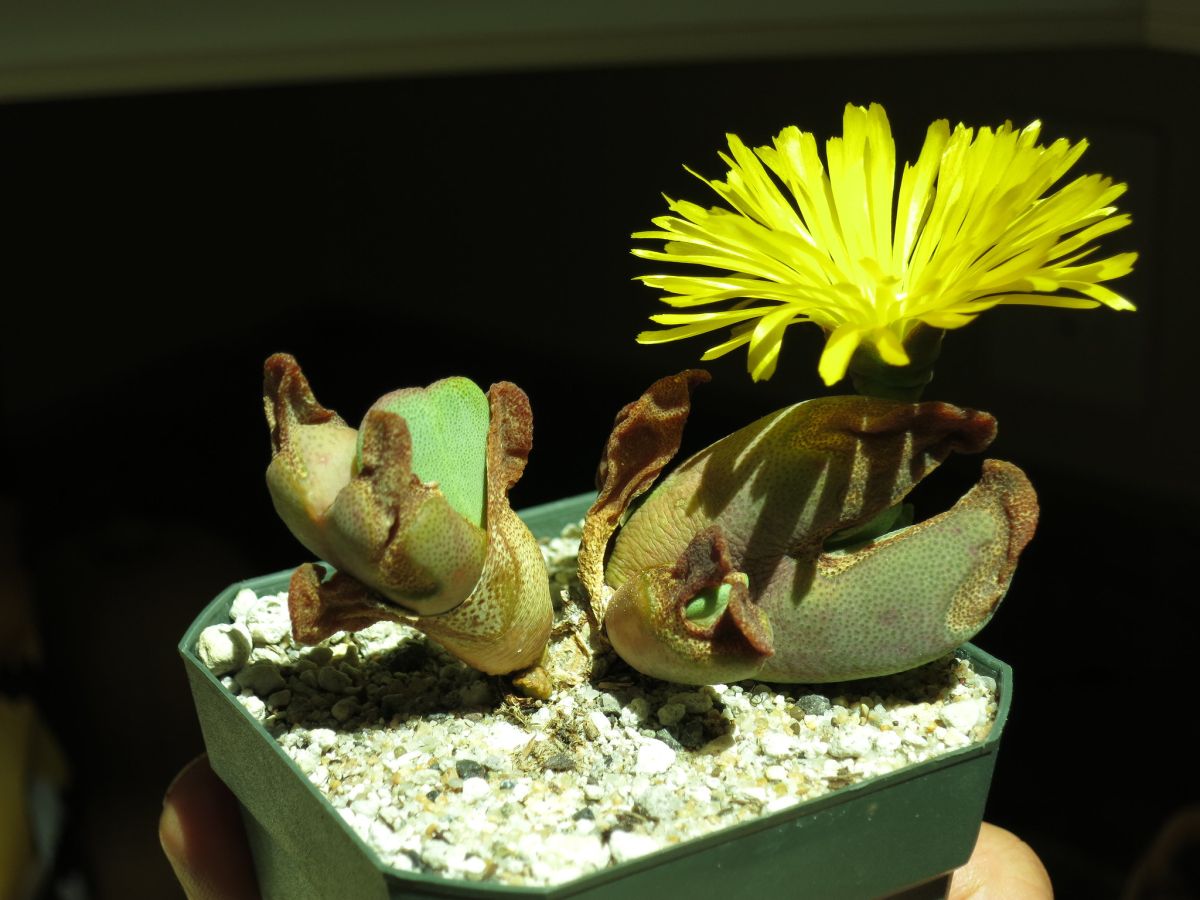
Ihlenfeldtia’s are ice plants from the Northern Cape Province of South Africa. They are small succulents with strange three-sided leaves that grow close to the ground. Ihlenfeldtia propagates by seed so it is easy to have a small collection of these in your garden.
These succulents bloom in early spring, but with flowers that are only open when the sun is up. For this reason, (and because they need it) you should place your Ihlenfeldtia’s in an area with plenty of sunlight and well-draining succulent soil not covered by rocks or pebbles.
48. Juttandinteria
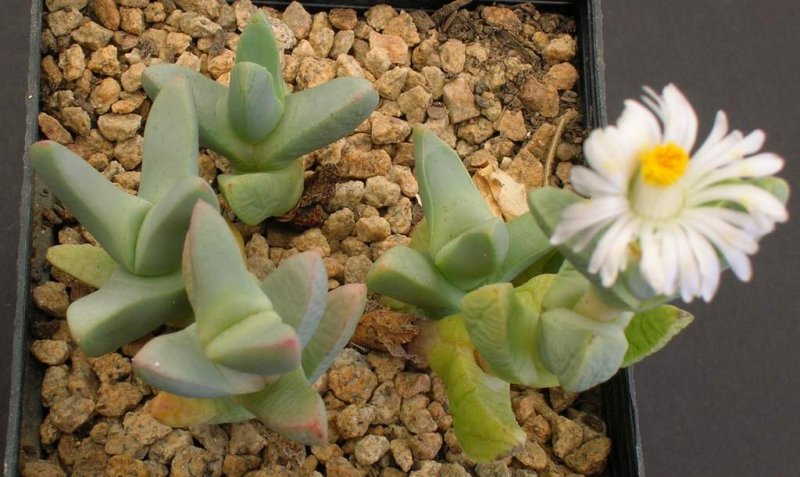
Need to plant succulents that bloom in the fall and winter? Look no further than the Juttandinteria which is a small succulent that blooms yellow and white flowers in the fall and winter months.
The Juttandinteria has a slow growth cycle but can get to be 20-25 centimeters high. The leaves are green, long, and finger-shaped. You can plant the Juttandinteria either inside or outside, but be sure it can get plenty of sun in either location.
49. Kalanchoe
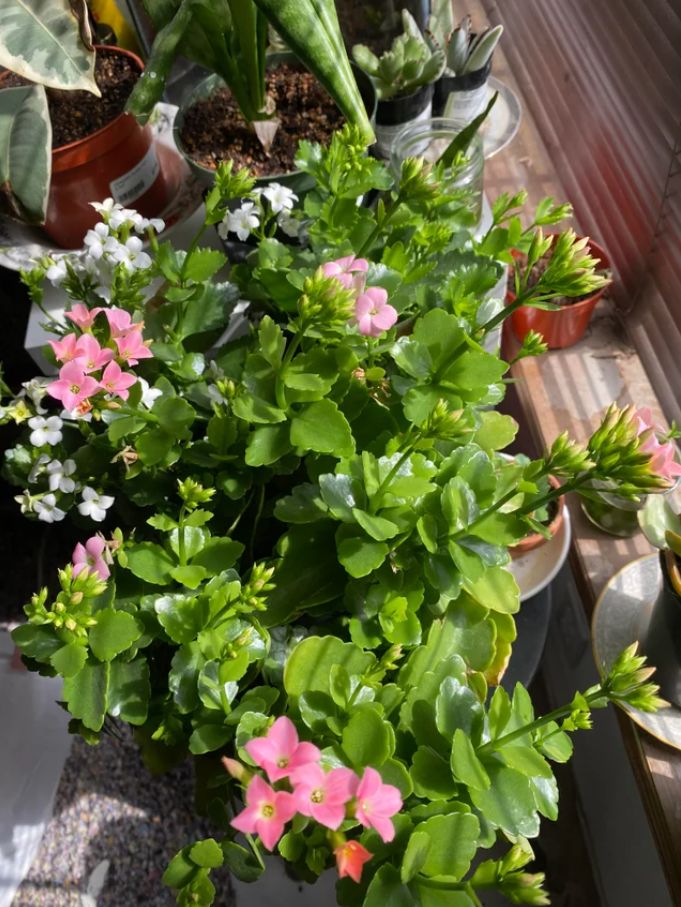
There are over 125 different breeds of Kalanchoe succulents, most of which flower regularly. They are from the country of Madagascar, meaning they are used to having a warm climate year-round and will not flourish if placed outdoors where frost can get to them.
Kalanchoe succulents come in many different shapes, sizes, and colors, making the succulent identification of this breed very difficult.
Some have white flowers with pink linings, while others have greenish-red flowers, so shop around a bit to find the Kalanchoe in the color of blooms you want in your home.
50. Neohenricia
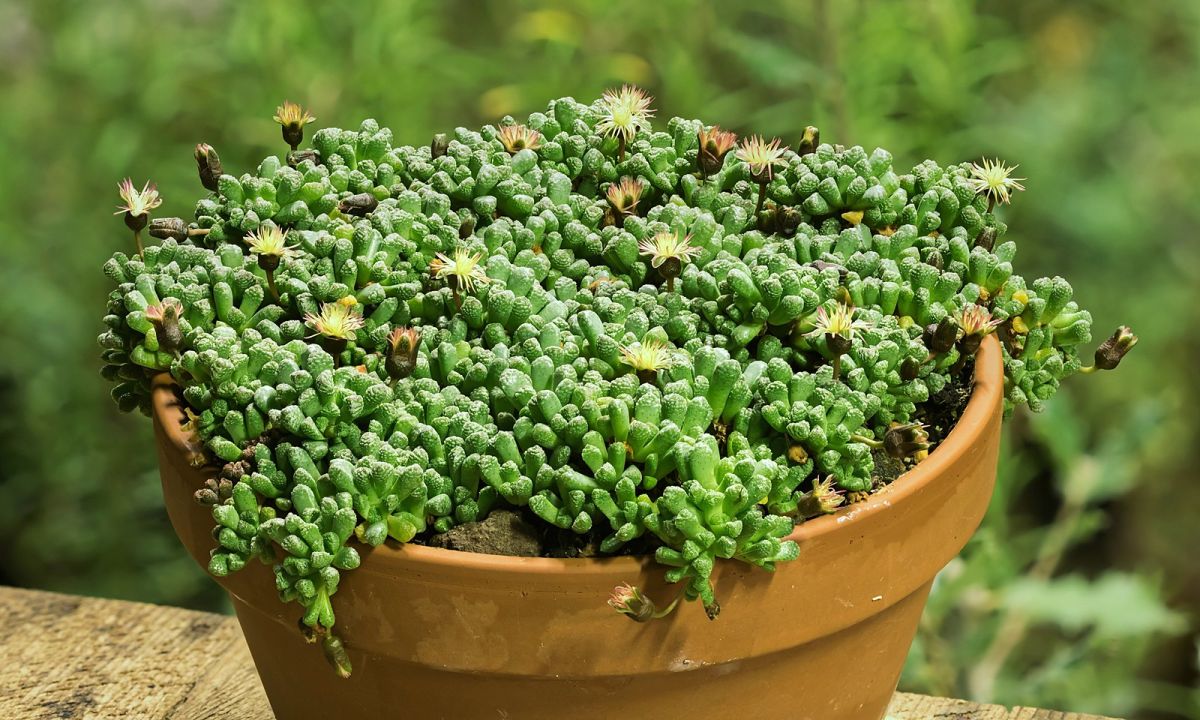
Those looking for flowering succulents that have showy flowers should skip over the Neohenricia, because while this plant has flowers, they are tiny and may need a magnifying glass to see them.
But what this succulent doesn’t have in the look factor, it makes up for in scent. The flowers of the Noehenricia are extremely fragrant, emitting a smell during the summer blooming season which is reminiscent of a pina colada with a slight musky after scent.
Putting one of these adorable green succulents in your living room is equivalent to (and probably better) than lighting a candle in the warm summer evenings.
51. Portulaca
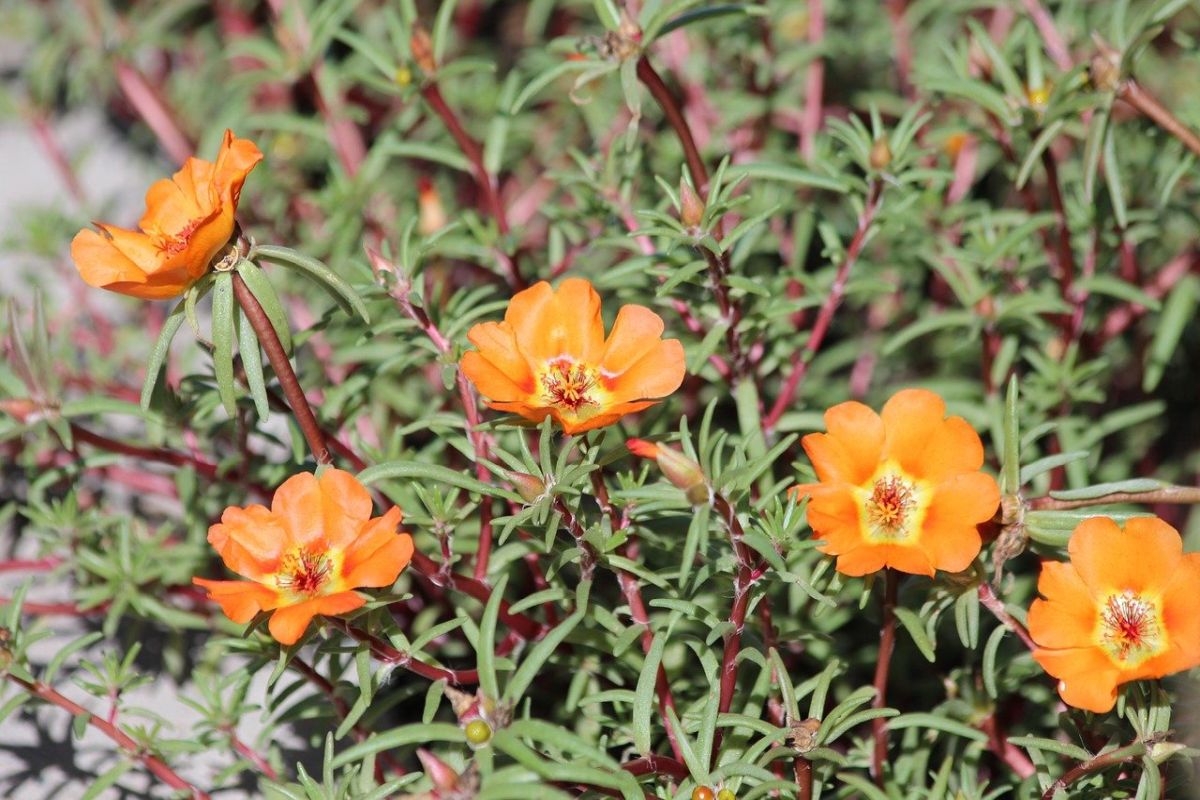
Portulaca are an easy succulent to classify when practicing succulent identification because they have every feature a succulent should have. They have fleshy green leaves as well as chunky wooden stems.
Portulacas do well in many different types of environments but generally prefer the hot weather.
When properly cared for, the Portulaca will bloom colorful flowers in shapes of yellow, red, orange, pink, white, and even purple. So if you live in the desert and struggle with keeping flowers on your property alive, the Portulaca is for you.
Types of Outdoor Succulents
52. Agave
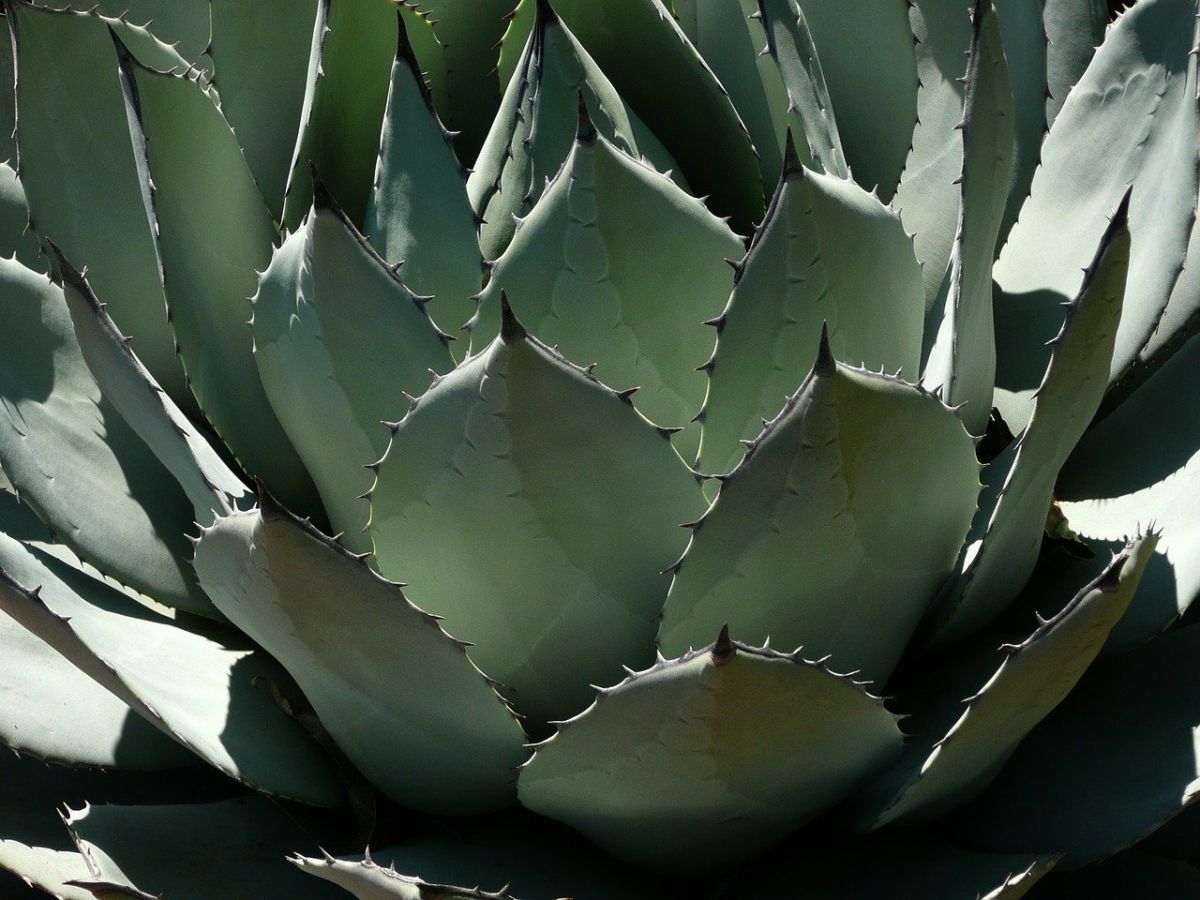
Looking for a central plant for your yard? Agave are dessert succulents which, while they start the size of the palm of your hand, can grow to be over 20 feet in diameter. Agave succulents do flower in the spring, making them a colorful addition to your yard.
Besides growing them for their beauty, a large agave succulent plant can also be useful in the kitchen as the stocks can be roasted and eaten. For those feeling really ambitious, agave can be used to create mezcal and tequila as well.
53. Aloe Plant
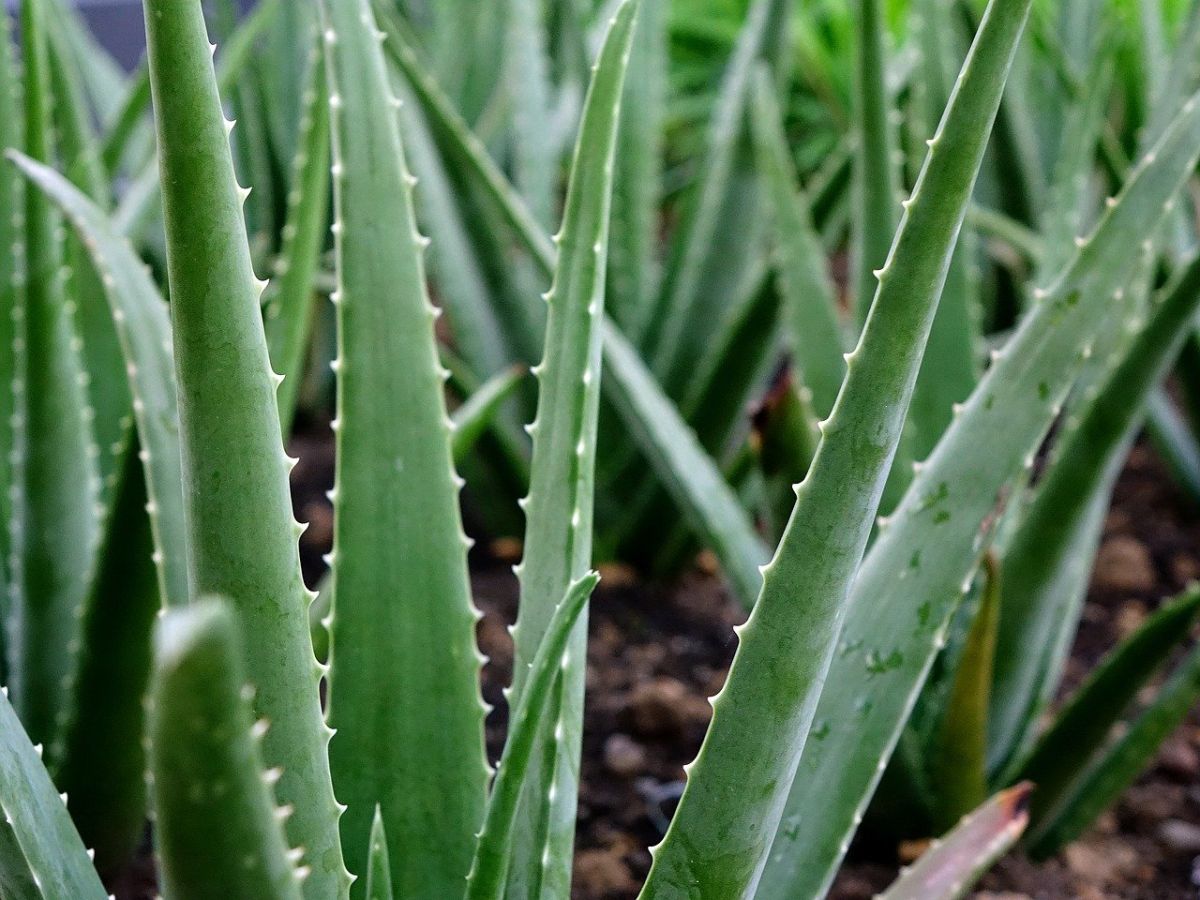
Like the Agave succulents, Aloe is another outdoor succulent that can really spruce up your porch or patio. If you live somewhere cold, however, you will want to pull this plant indoors and place it where it can get bright direct light for the months when it drops below freezing.
Even when they are inside, these succulents require full sun, therefore it is not recommended to buy an aloe vera plant if you live somewhere where there isn’t much sun year-round. But for those in a state like Arizona or Texas, the Aloe vera plant is a beautiful addition to any outdoor succulent garden.
54. Aloinopsis
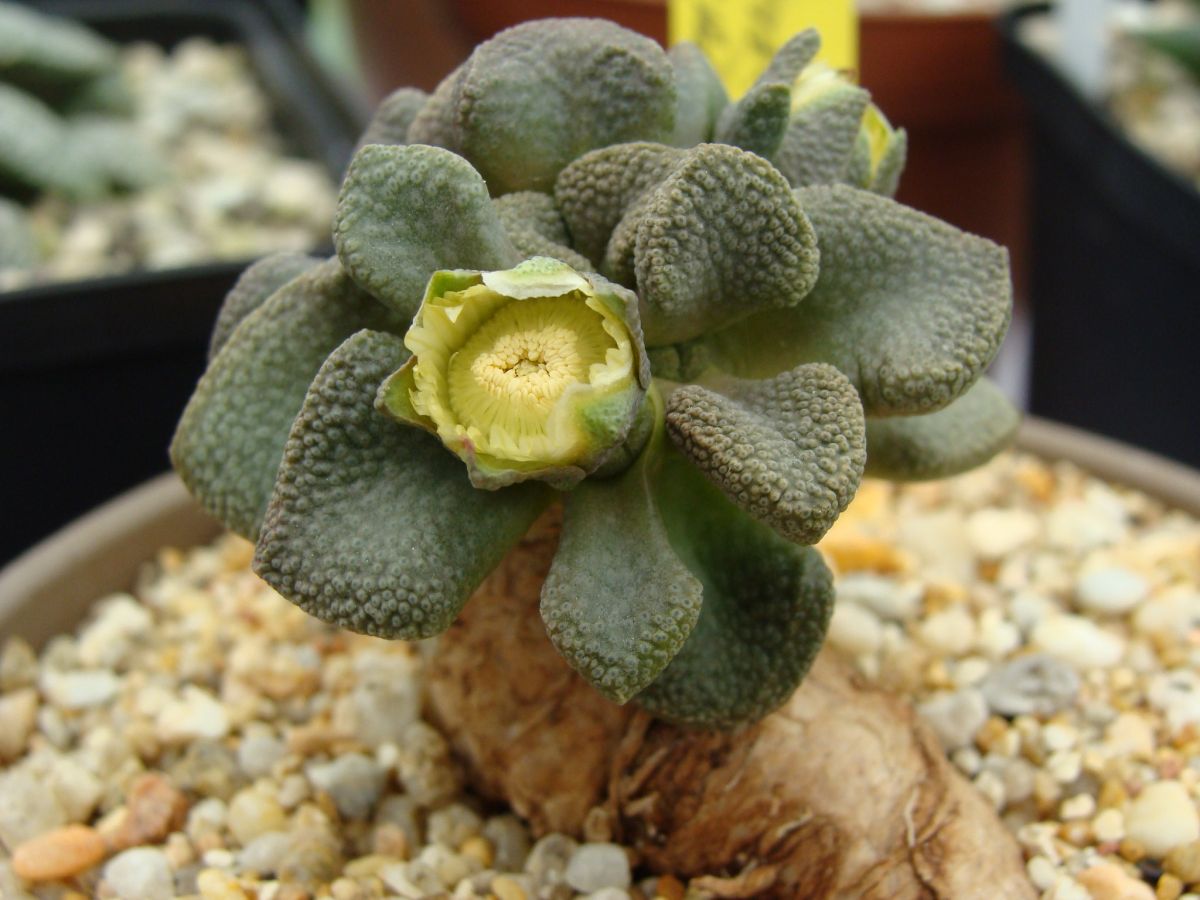
The Aloinopsis is a unique succulent in that it can stay outdoors even when the temperature drops below freezing. Not only that, but these succulents actually grow during the winter months.
Therefore if you do add an Aloinopsis to your collection, you’ll want to be sure to water it all year round.
55. Bergeranthus
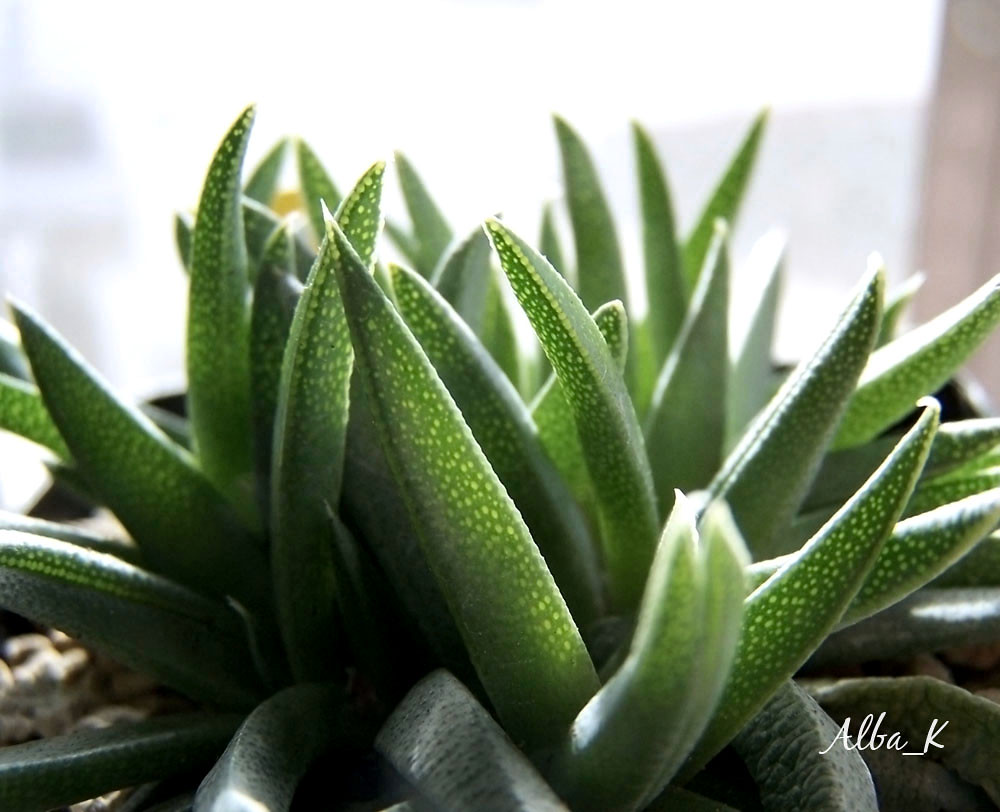
If you’ve got a garden with Aloe plants and Agave, a Bergeranthus will make a great third succulent as all three grow in the same hot and dry climate. These succulents are significantly smaller than the Aloe plant and agave plant, but they are hardy and will become dormant in the winter if temperatures get too cold for them.
Bergeranthus plants bloom white flowers or yellow flowers in the spring, which grow on long stems that grow higher than this dwarf plant.
56. Ceropegia
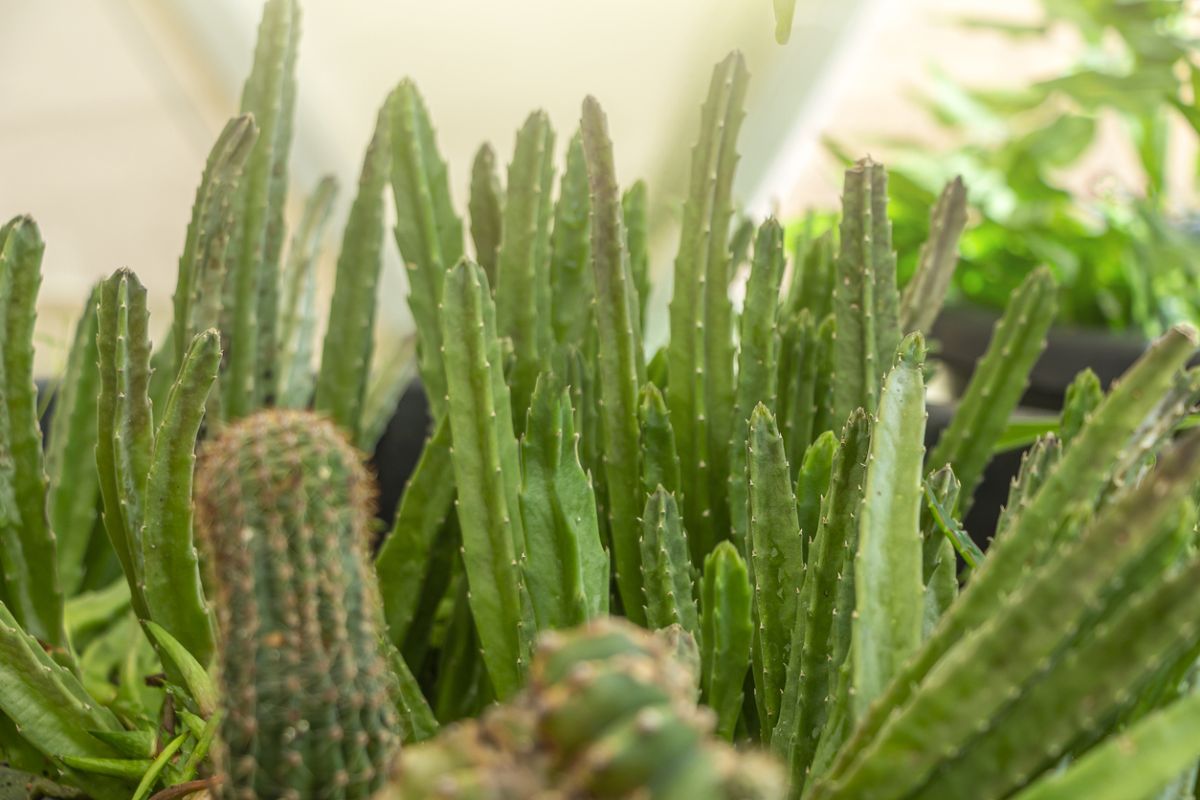
Ceropegia is a succulent genus that includes several different types of succulents. The succulent plants in this genus are known for their unique appearance and funny nicknames which people often refer to them as.
There are the Bushman’s Pipe, String of Hearts, Parachute Plant, String of Needles, Necklace Vine, Snake Creeper, and Latern Flower just to name a few. Most of these succulent plants tend to be better when planted outdoors because they grow tall in height, especially those like the Snake Creeper and String of Needles, which are very happy to climb up a trellis or the side of your home.
57. Dudleya
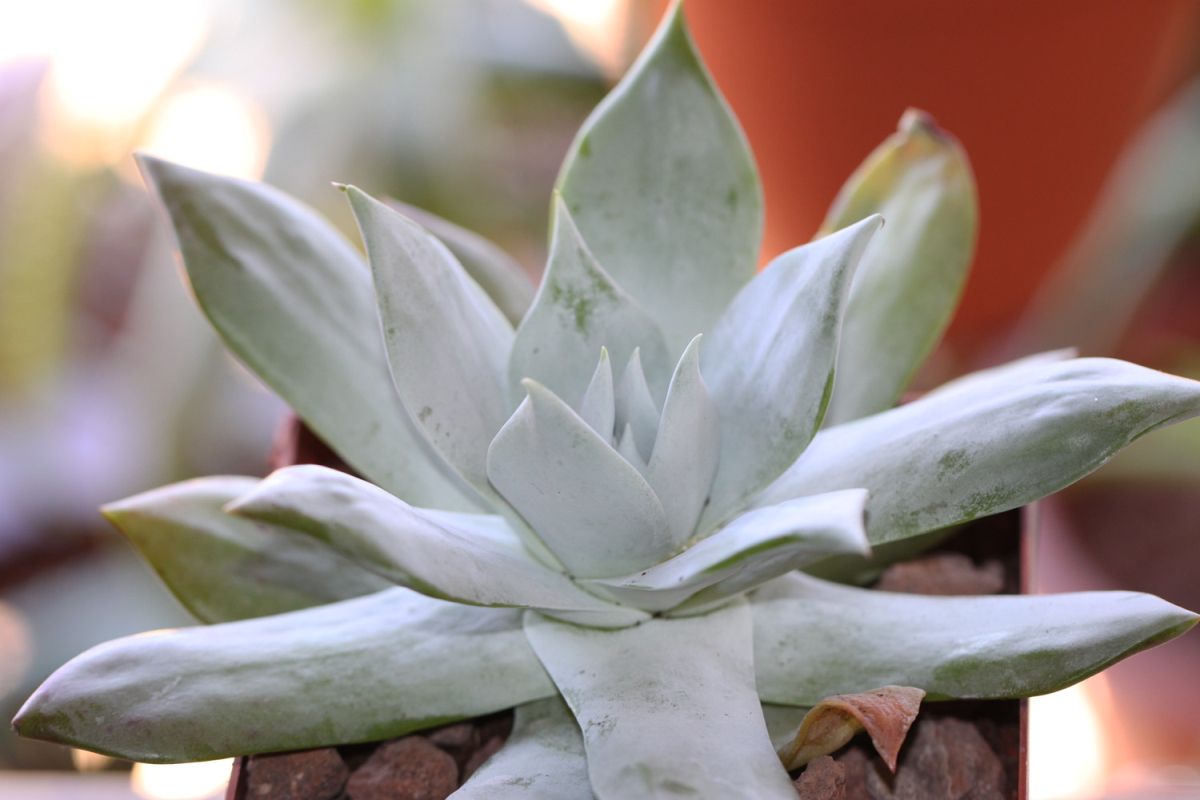
Dudleya are common succulents that typically have green leaves that come to a point at the end. They grow in a flower shape, making succulent identification easy with these plants.
Dudleya succulents can be found in a wide variety of locations, and can sometimes be seen growing out of rock. Despite its hardy nature, Dudleya needs some sun protection and does better in a yard where it will receive partial shade.
58. Dyckia
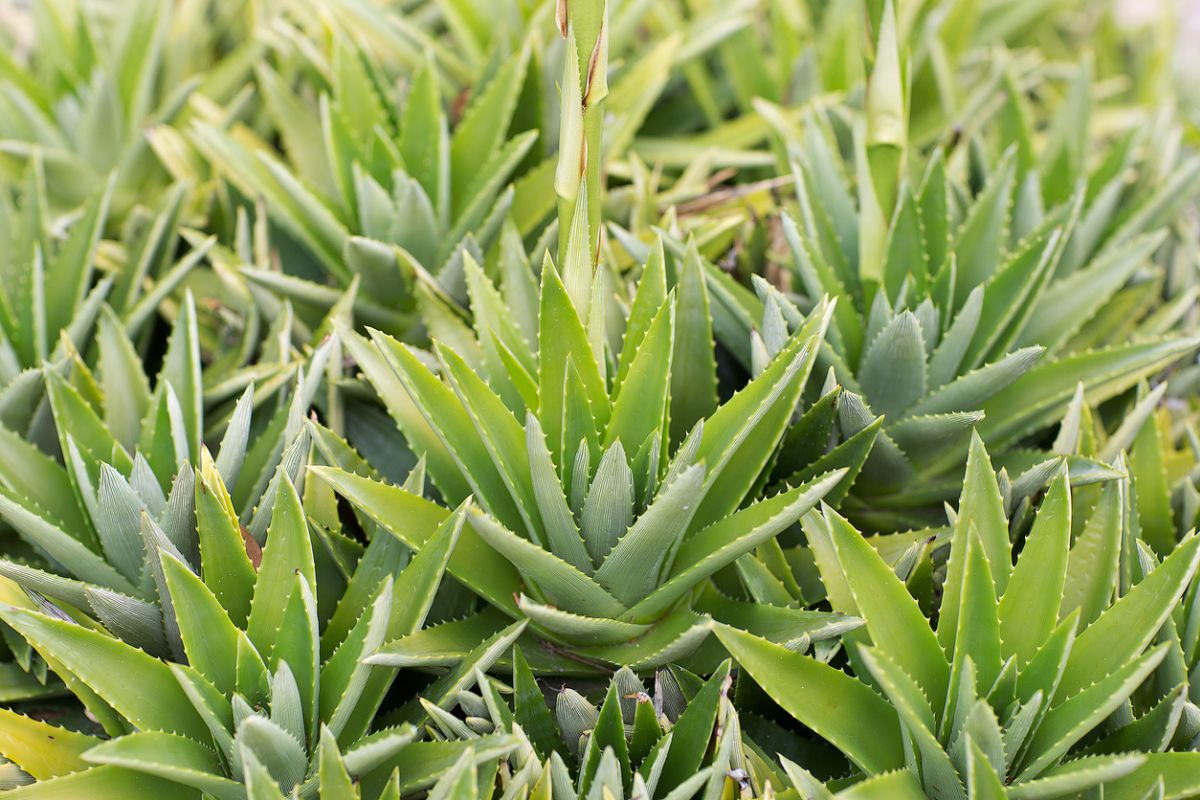
Dykia is a succulent with long leaves which are covered with spikes along all the edges. These succulents grow large and can come in all sorts of colors from green to bronze, to purple and even silver. Dykias are low maintenance once planted and can grow to cover a large portion of ground.
Although these succulents may seem a bit boring to add to your garden, they do bloom once a year with beautiful orange and white flowers. They are a perennial succulent so you don’t have to worry about replacing them year after year.
59. Echeveria Succulents
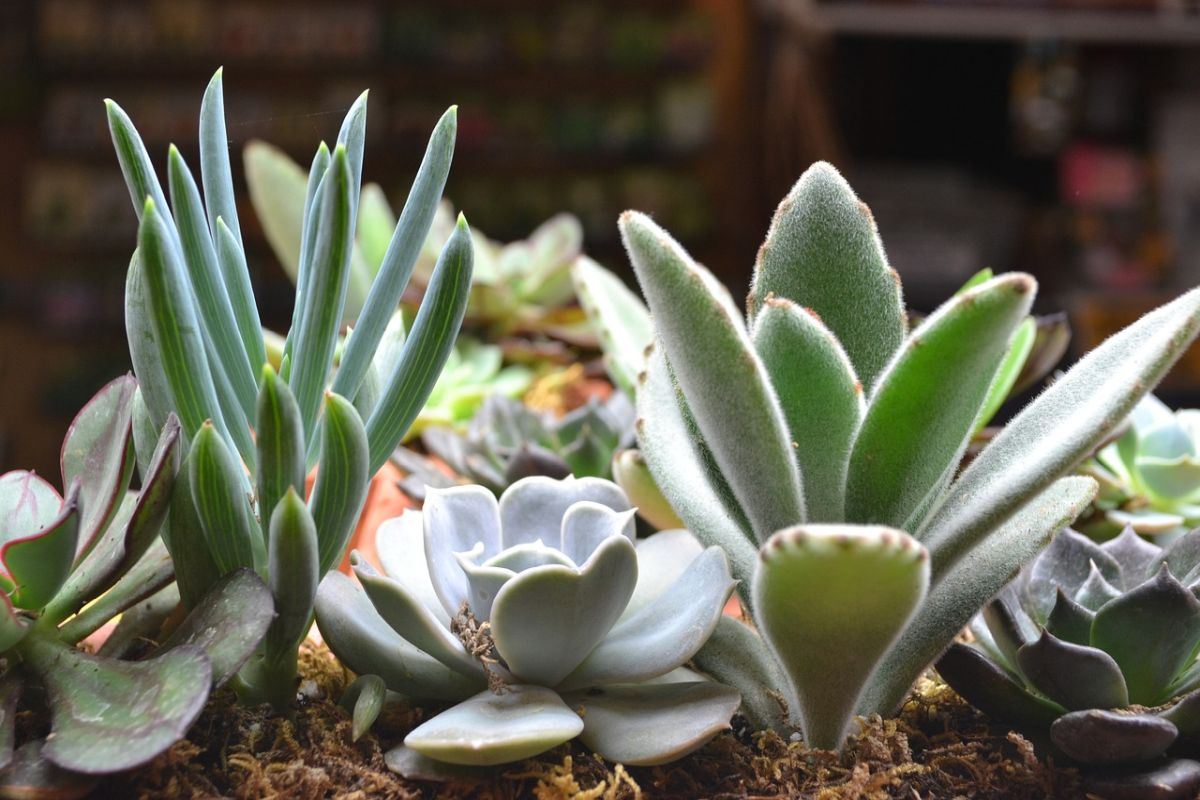
Echeverias are common outdoor succulents that many homeowners choose to add to their rock gardens. Even though you can plant Echeveria succulents in almost anything, they actually do best when placed in potting soil that contains fertilizer.
Echeveria succulent plants are drought resistant and can survive small amounts of frost. Echeverias are not flowering plants, but the shape of the leaves will look like a flower, which is what attracts many to this succulent.
Growing succulents like Echeverias is easy, as long as you have a good location in the sun and you water them plenty.
60. Faucaria
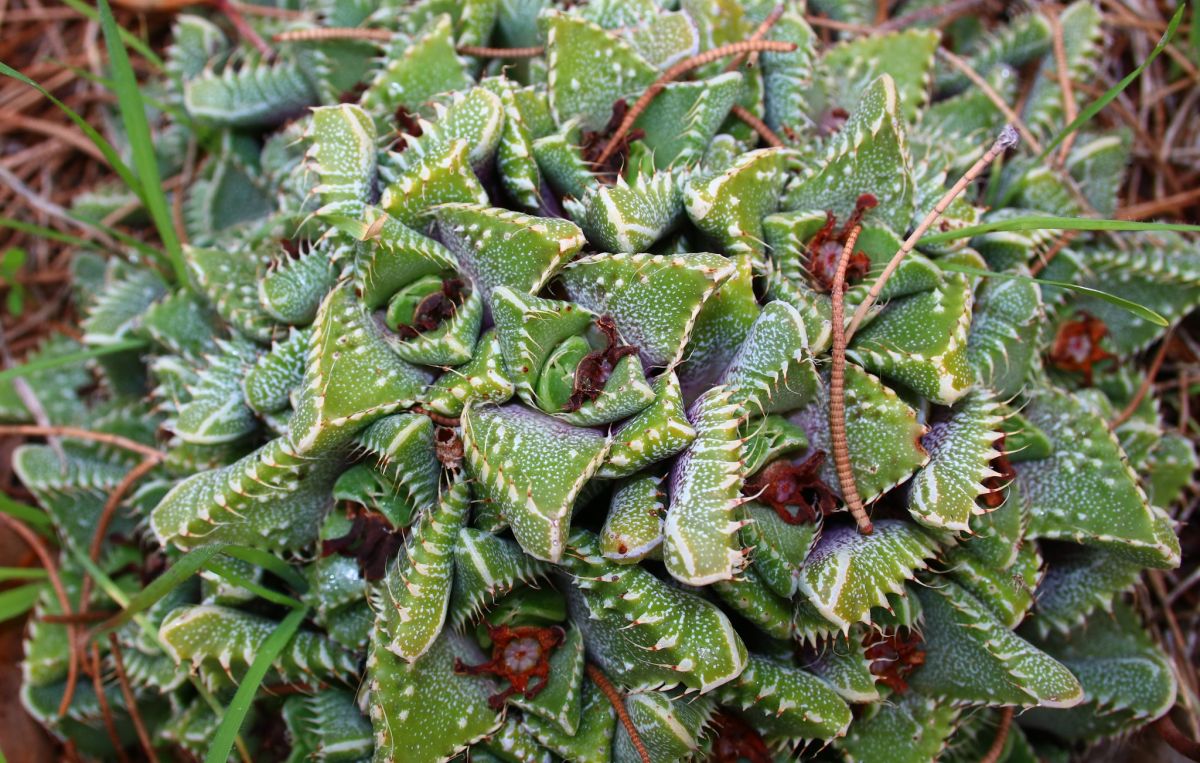
Faucaria, or better known as ‘Tiger Jaws’, is a species of succulent plant known for its spiny leaves. These types of succulents are small, typically growing to only 3 inches in diameter. They are outdoor succulents, because of their hardy nature which allows them to bloom in the middle of the summer.
Those interested in adding this succulent species to their rock gardens need to be careful, however, as they aren’t as easy to care for as the aloe vera and they can be prone to stem rot if you aren’t careful.
If a Faucaria in your care does fall off its stem due to rot, don’t panic just yet as you can pick up the bulb portion and replant it.
61. Lampranthus
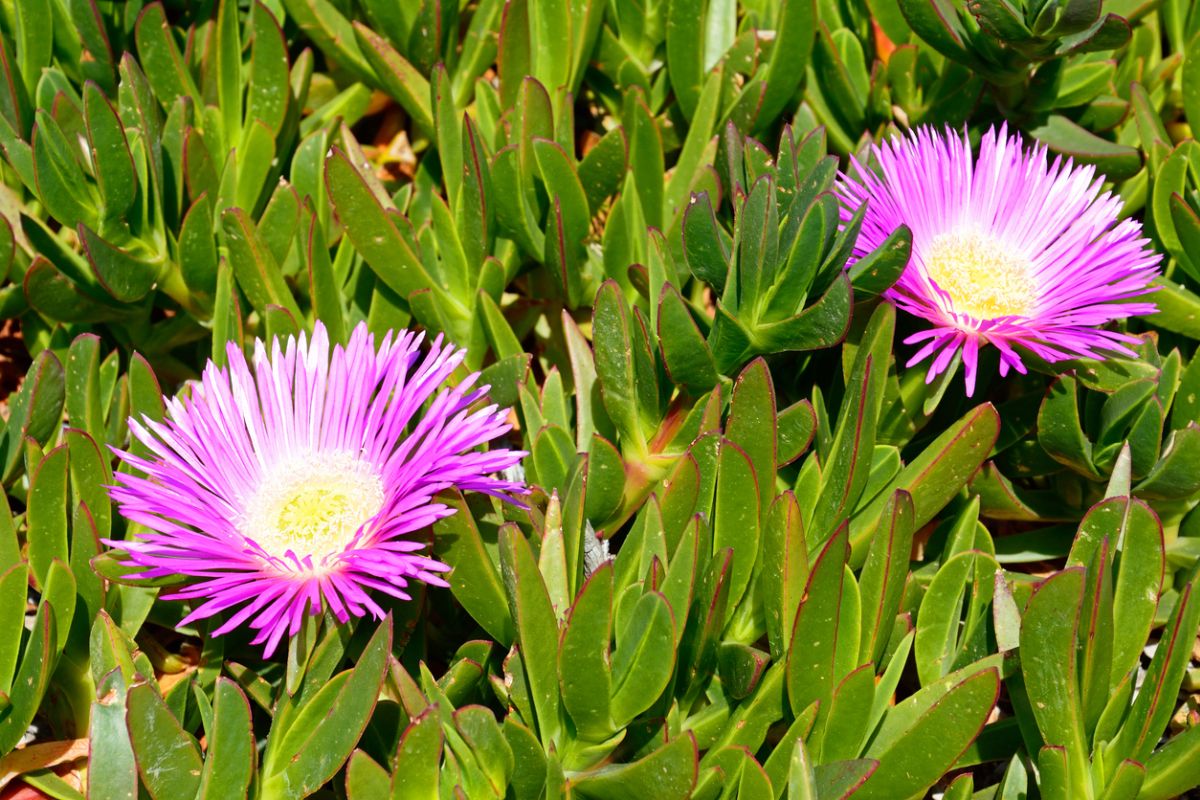
Lampranthus is an ice plant succulent that can grow well in dry and sandy environments. The name ice plant comes from small, tiny hairs, on the plant that looks like ice crystals in the sun. The Lampranthus is a flowering plant that blooms almost all year round.
While the Lampranthus won’t grow large, it will grow out as far as you will let it become ground cover. It needs full sun in order to grow and is native to South Africa.
The color of blooms you will see vary widely from plant to plant, as some will have bright red flowers while others will have bi-color or tri-color flowers in a variety of colors.
62. Hesperaloe Parviflora
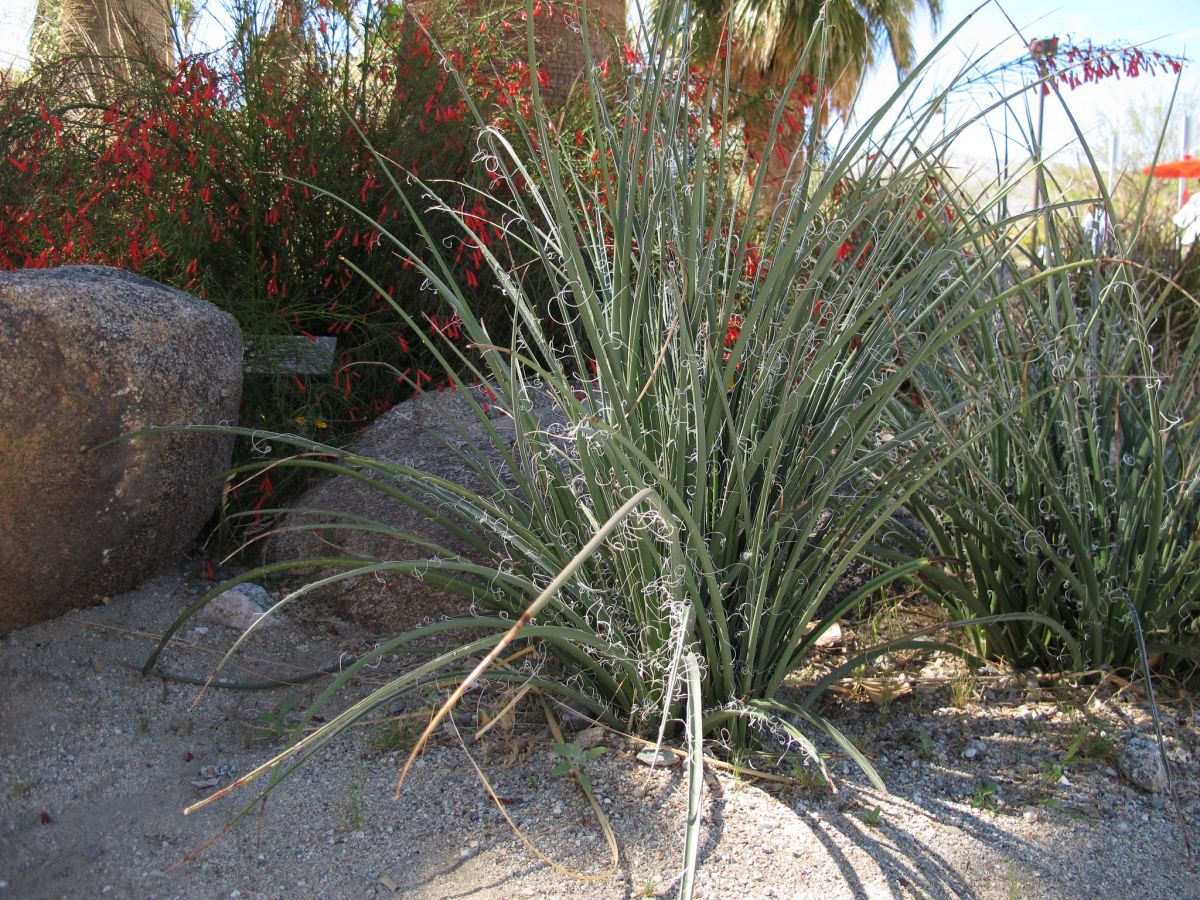
The Hesperaloe has the word aloe in it because it looks very similar to aloe vera. It is, however, its own type of succulent, that grows to be about as big as the aloe vera.
The Hesperaloe is a flowering succulent, with blooms that range from white flowers to red flowers depending on the variety you grow.
Like most types of succulents, the Hesperaloe does well in dry, airy climates. They need to be planted where they will have plenty of drainages, to ensure they don’t get too much moisture and begin to rot. The Hesperaloe is large, definitely needing to be classified as an outdoor succulent.
63. Orbea
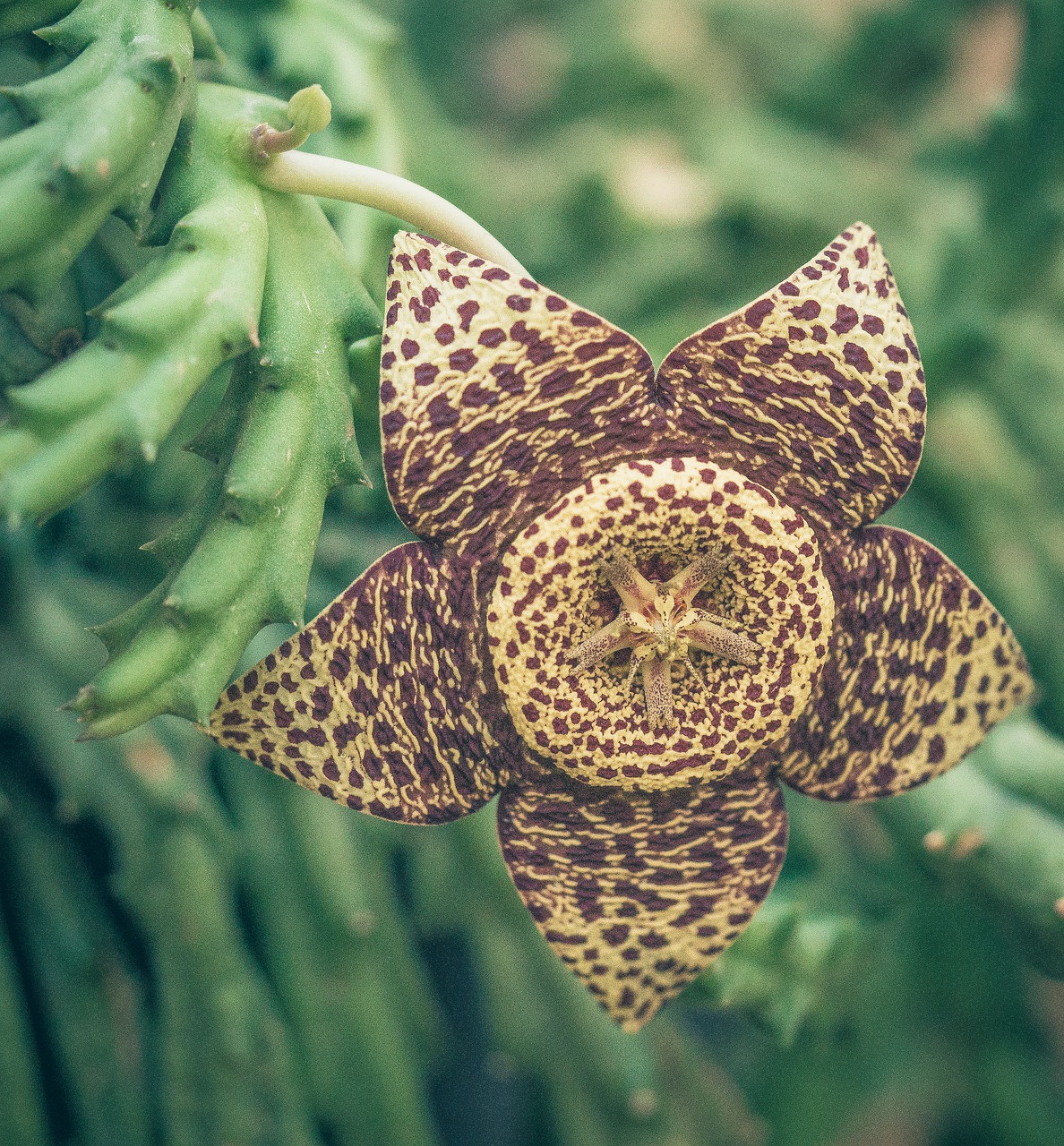
Orbea is a flowering succulent that doesn’t have leaves, but rather just a stem that grows the flowers that it totes on a year-round basis. These flowers can be fleshy like succulent leaves, hairy, and sometimes even spiny.
The flowers come in multiple colors, from yellow to red, or even yellow with red spots. Orbea need plenty of light so be sure to place them in a section of your garden where they will receive sunlight all day long.
64. Orostachys
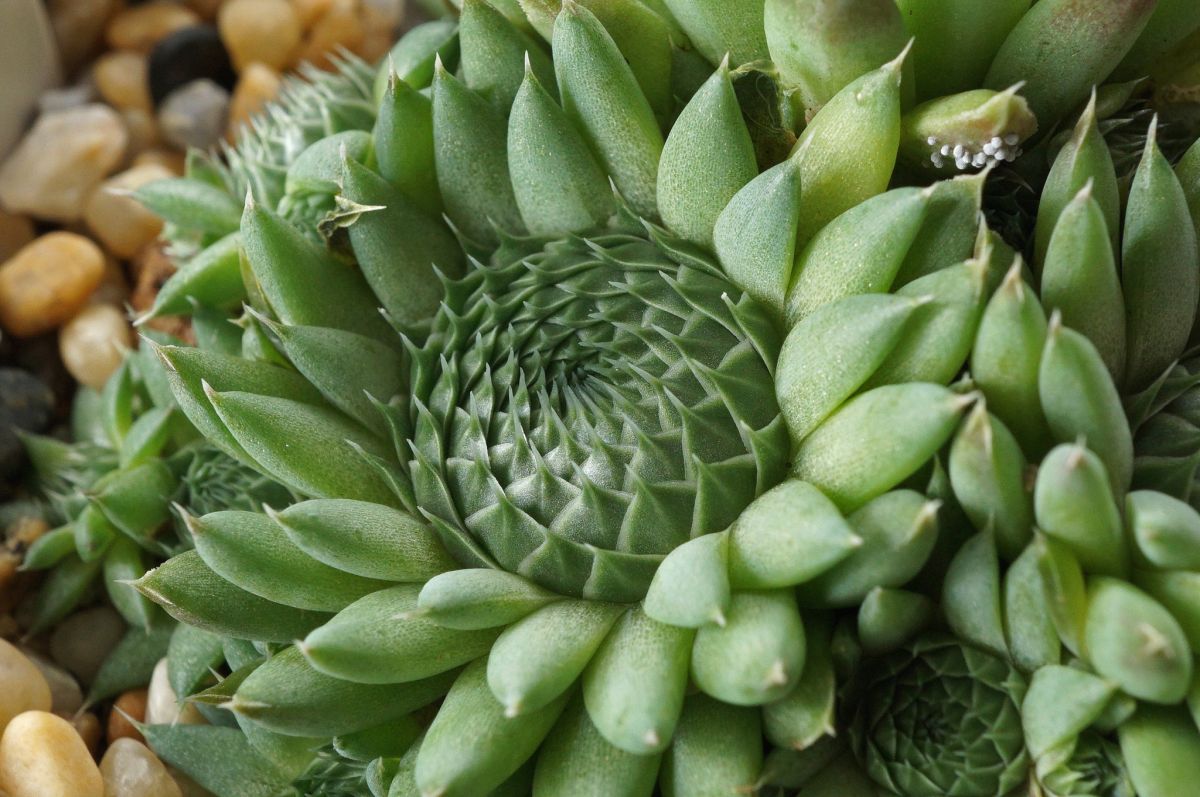
Live in a cold climate? Don’t worry, you can still have outdoor succulents. The Orostachys types of succulent is an outdoor breed that is native to Siberia and Mongolia, making it the most cold-tolerant plant on this list.
Orostachys come in many different colors and forms, one of the most popular being one that resembles a lotus flower in shape, but it is completely green in color.
These succulents do fine in snow, and they can survive temperatures as low as -40 degrees celsius. Just be sure they have well-drained soil as these succulents rot easily.
65. Prenia
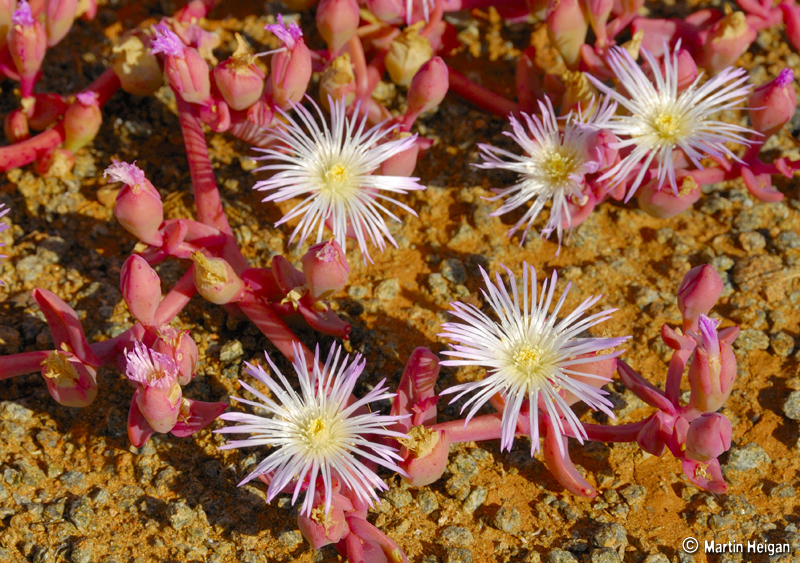
Prenias are ice plants that are native to Nambia. They tend to like to grown on mountain slopes and, if allowed, they will spread out and cover a large area of ground.
Prenias are unique in that they are red and pink in color with no green to be found anywhere. The pink leaves do open seasonally to reveal small white and yellow flowers.
66. Rabiea
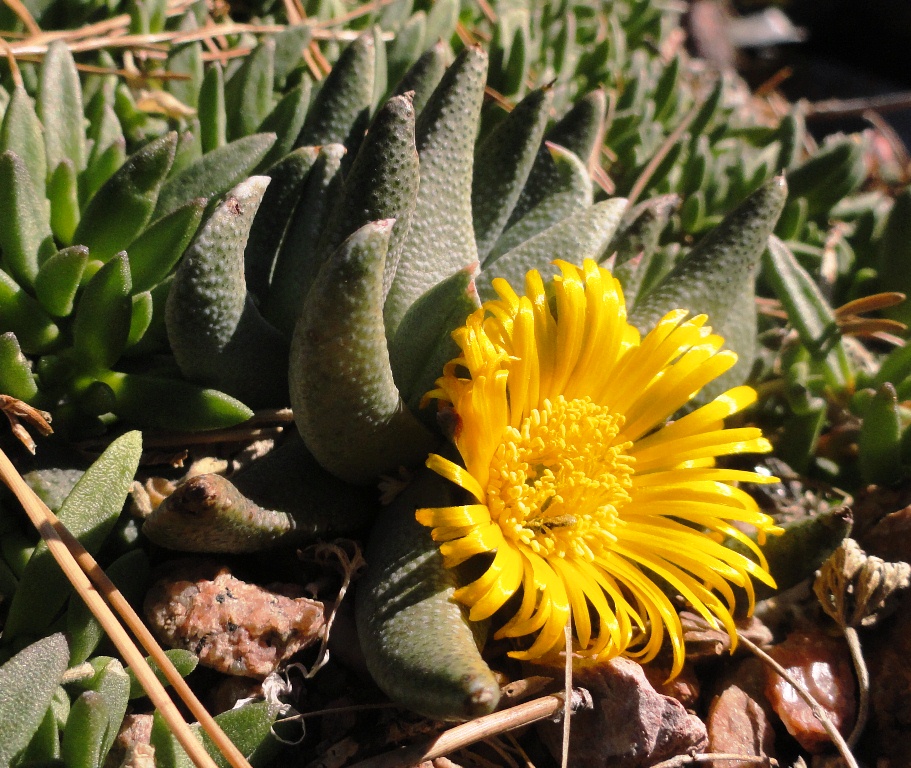
Rabiea are another mat-forming succulent that grows close to the ground. They are easy to grow in dry climates, and typically do not need a ton of attention to flourish.
Rabiea are green, with triangular-shaped leaves that grow outwards in every direction. Some Rabiea are flowering, but be careful putting them in a yard with pets as some have hallucogenic properties and can harm animals.
67. Rhombophyllum
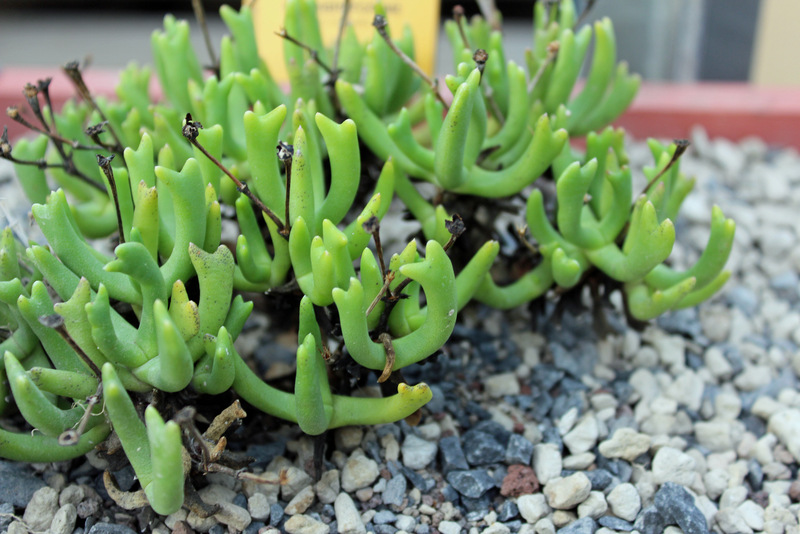
Rhombophyllum are a low, wide-growing species of succulent that are native to Nambia. They can be identified by their greenish pink leaves, and sometimes the leave grows up to form the shape of a cactus.
68. Rosularia
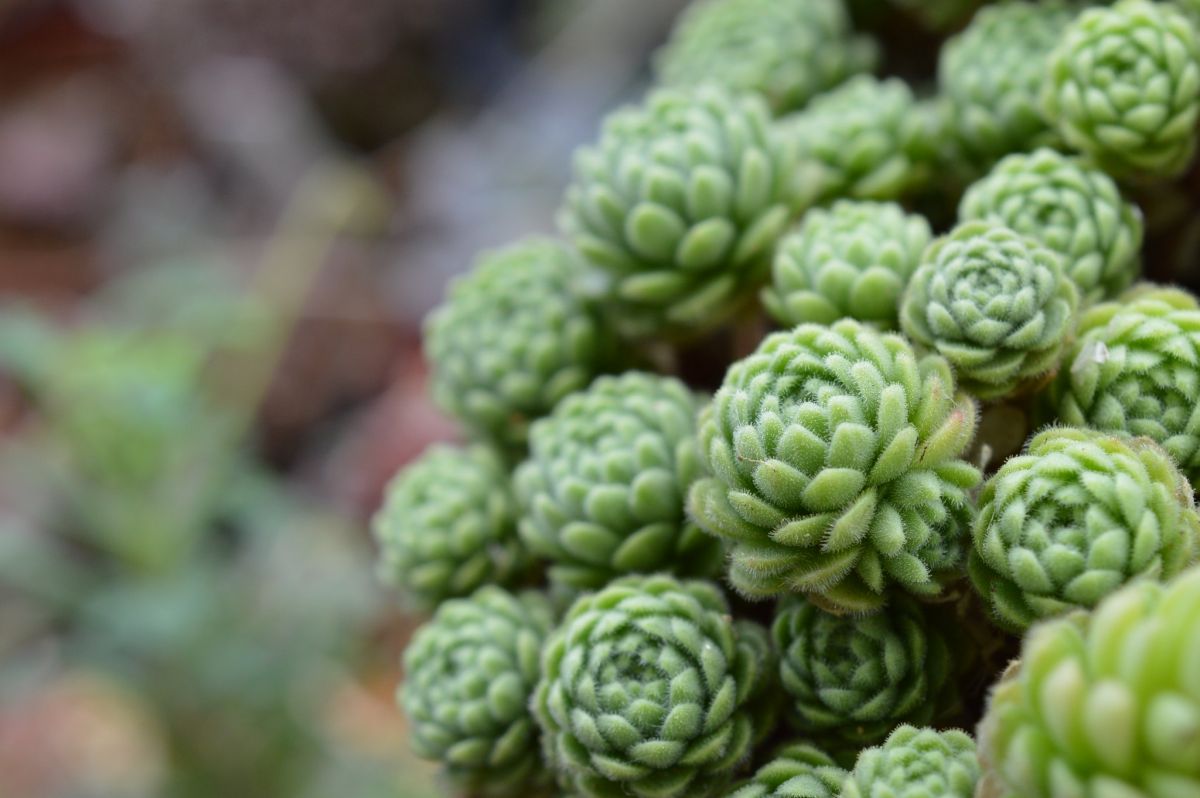
Rosularia are what come to mind when people think of succulents as they have thick leaves that grow in a rosette shape making succulent identification a breeze. They have little hairs like an ice plant and they are used to help with water absorption.
Rosularias can be hardy, but do best when they are not exposed to frost.
69. Sempervivum
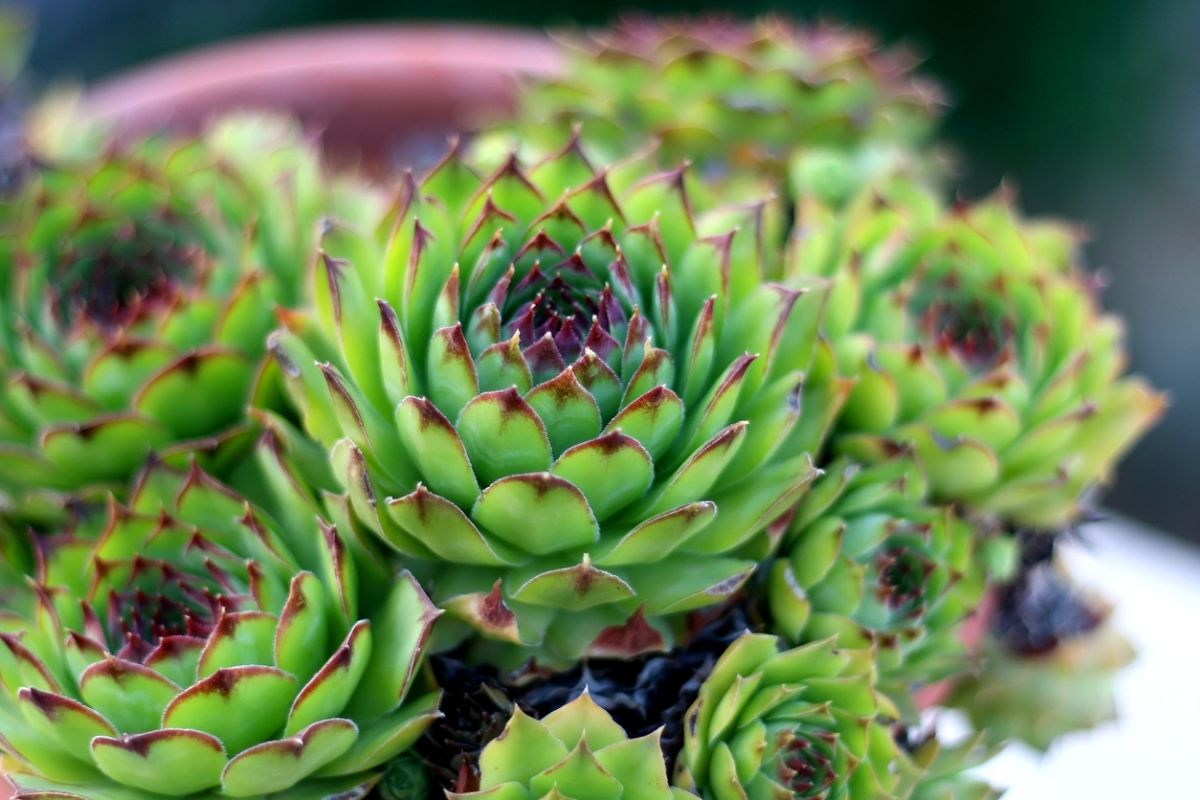
Sempervivums are beautiful succulents that grow leaves in a flower shape. They range in colors from blue to green or even red and purple. Some Sempervivums even have multi-colored leaves.
Sempervivums are native to Iran, meaning they will do well outdoors in a warm and dry climate. If you live somewhere rainy, you can still have one, you will just need to raise it indoors.
70. Senecio
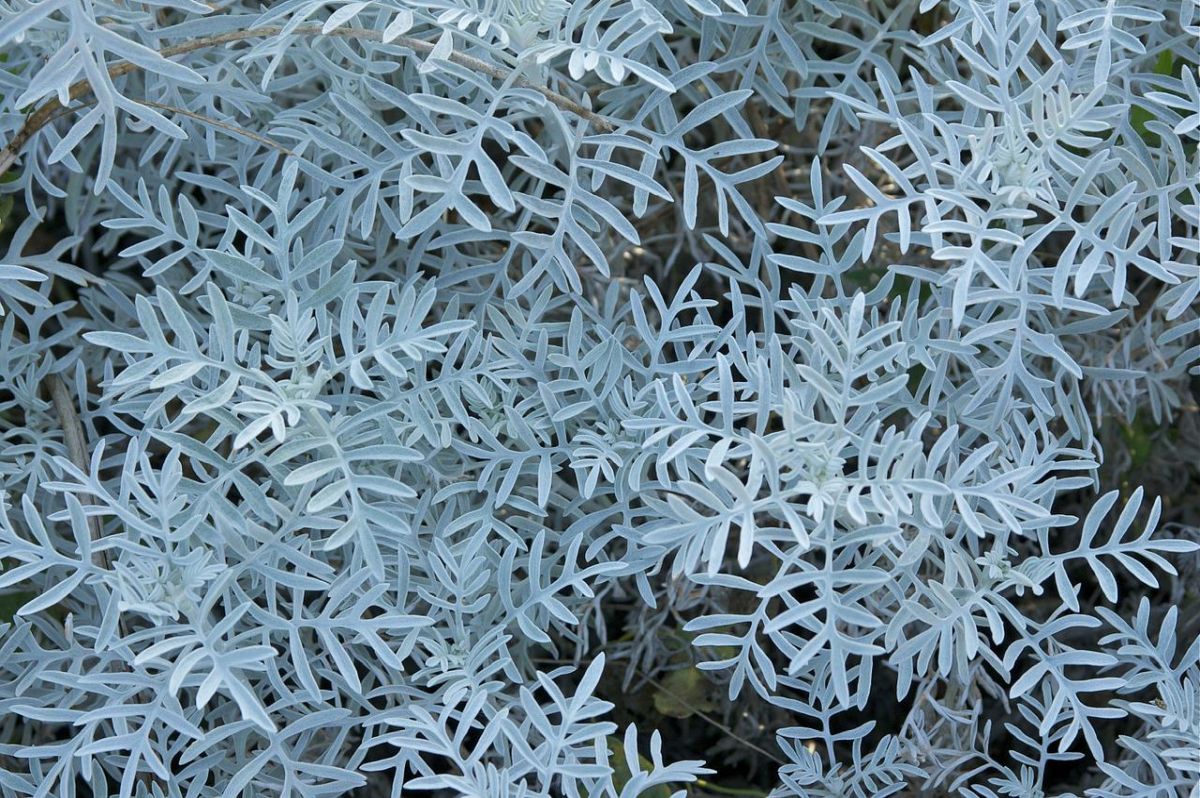
Did you know that succulents can grow to be as large as shrubs? The Senecio is a shrub succulent that can be used to fill a large space in your garden. Although they frequently grow out first, they will grow up later.
Senecios can be blue or green, but they are extremely picky when it comes to the weather. They can only be grown in a place without frost, that doesn’t have extreme temperatures over 80 degrees Fahrenheit either.
How to Revive a Dying Succulent Plant
Succulent plants tend to die because they are overwatered, or placed in an environment that they are not meant to thrive in.
Before you try to revive a dying succulent plant, it’s important to look up information regarding your types of succulents and ensure you have them in the environment which is right for them.
If you research your succulent and find that it is in the right environment, then take a look at some of the symptoms and solutions below to help revive your dying succulent plants.
Symptom 1: Succulent Turning Brown, Black, and Mushy
A succulent that is brown, black, and mushy is one that is experiencing rot. Rot happens when a succulent is overwatered. Remember that most types of succulents store water and only need to be watered once a week. Rot can happen in the green leaves of a succulent, or in the woody stems.
Solution:
Unfortunately, depending on the state of the rot, it can be difficult to revive this succulent. Start by discontinuing the water of the plant until the soil is dry. You should also trade the soil in the pot for potting soil that drains more easily. Ensure the succulent is in a pot that has good drainage.
If the succulent is still alive after this, then it has survived and you can water it a small amount. Going forward, be sure to monitor how much you are watering your succulent and scale back to only giving it water when the soil is dry.
Symptom 2: Succulent Turning Brown
If your succulent is turning brown, but isn’t mushy, then it is probably a victim of a little bit of sunburn. Sunburn can occur in succulent plants which are left in full sun that is too hot for them to handle. The snake plant is an example of a succulent that does not do well in the full sun.
Solution:
Luckily, saving a succulent from sunburn is an easy fix. All you need to do is move the succulent from the sunny area to an area with partial shade. You may have to move an outdoor succulent indoors if there isn’t sufficient shade in your yard.
Symptom 3: Succulent Losing Leaves
Succulents begin to drop their leaves when they are overwatered, and this is often a sign that rot may be following shortly after. The good news is, if your succulent is only losing leaves and doesn’t show signs of rot, you will still be able to save it.
Solution:
Start by changing the way you water your succulents, doing so only when the soil in the pot is completely dry. You should also change out the soil, and ensure the pot has enough drainage so that the succulent isn’t sitting in standing water at any point.
If you do all of these things, it is likely you will be able to save a succulent that is losing it’s leaves.
Symptom 4: Succulent Wilting or Shriveling
Is your succulent looking a little shriveled or wilted? Then it is likely you aren’t watering your succulent enough. That, or the soil you have your succulent in is too hard and allows the water to run off instead of absorbing it.
Solution:
When your succulent is wilted, it is easy to bring it back to healthy simply by watering it a little more often or switching it to more absorbent soil. Just be cautious that you don’t overwater your succulent in the process as this can cause a whole new host of problems.
Symptom 5: Tall Succulent Only Losing Leaves at the Bottom
Sometimes, a succulent may grow so tall that it will cause its own problems by having the upper leaves block sun access for the lower leaves hindering photosynthesis and causing them to die out.
Solution:
While this can be scary, especially when it happens to your beautiful zebra plant or aloe vera, it is a normal process of the growing process for a succulent. The only time you should be concerned is if the entire plant starts to wilt, as this is a sign that it isn’t getting enough bright light.
When this is the case, you should move your succulent to a location where it will get full sun.
Symptom 6: Succulent Frozen
If your succulent experiences a frost, this is bad news. Most types of succulents are not designed to be cold-hardy and will not survive if left out in the cold.
Solution:
The minute you know it will frost, or drop below freezing, it’s essential to bring your succulent indoors, or to somewhere where it will be out of the cold. As long as the succulent does not turn brown or mushy, it should survive.
If it is too late, and the succulent’s green leaves have already turned brown, black, or mushy, still move it indoors as there is a chance it could recover when given some TLC.
Symptom 7: Succulent or Soil Molding
Seeing mold in the pot with your succulent is definitely a terrifying moment. Don’t panic however as in either situation, the mold is likely caused by over-watering and doesn’t mean your succulent is dying (yet).
Solution:
Start by reducing the watering of your plant, and swap out the soil for a new batch (especially if there is mold in the soil itself). Next, mix together water, baking soda, and dish soap and dip a cloth into the mixture.
Use the cloth to gently brush the mold off your succulents. You can also use a spray bottle to spray the mixture lightly on the leaves if it won’t brush off. Prevent future mold on the leaves by spraying a bit of milk onto your succulents.
Symptom 8: Spots Appearing on Leaves
It is common for outdoor succulents to get spots on their leaves when they are exposed to insects, but when placed inside, you may wonder where they are coming from.
Dark spots on leaves are usually just small sunburns. Therefore spots on the leaves of your plant can indicate it is getting too much sun.
Solution:
Move your succulent to a more shady location, or if you recently put it in the sun, you need to acclimate it to its new position much slower. You can also purchase a shade cloth to provide your plant with shade at different points in the day.
Types of Succulents FAQS
What is the Prettiest Succulent?
The most beautiful succulent will generally depend on your personal opinions (what you find the most beautiful) as well as the type of environment you have set up to host a succulent.
By in large, however, most people agree that jade plants and burro’s tail are some of the most beautiful types of succulents.
How Many Different Types of Succulents Are There?
There are currently over 10,000 different types of succulents. They are divided into 1,300 different plant types and classified into 60 different families.
Therefore, you should have no problem finding the ideal succulent for your home or yard. It’s the selection process that will be difficult.
What is the Most Common Type of Succulent?
Most people adorn their homes with a beautiful jade plant, a burro’s tail, a pincushion cactus, or an aloe vera. These types of succulents are not only beautiful, but they are easy to care for and can be either indoor or outdoor succulents.
Do Certain Types of Succulents Ever Flower?
Many types of succulents are actually flowering plants and will bloom during one or two seasons of the year. The time of year your particular succulent will bloom will depend on its type and where you plant it.
Many succulents bloom white flowers, yellow flowers, and pink flowers. But some succulents will bloom multi-colored flowers as well as red or orange flowers.
What Types of Light Do Succulents Need?
The type of sunlight your succulents need will depend on the types of succulents you buy. Some succulents need full sun, while others prefer partial shade.
It’s important to review all care information about your particular breed of succulents before planting it in the ground or placing it outside.
Upgrade Your Home with Succulents Today
By now, you should almost be an expert when it comes to the world of succulents. Whether you decide to spruce up your living room with a jade plant or plant an ice plant in your outdoor garden, there is a succulent for every home and every weather condition.
Can’t decide on a single succulent? Well, then it sounds like you will definitely need to buy two or three, so pick your favorites off this list and start planting different types of succulents in your home today.
